Clara's AP Art History Flash Cards
1/225
Earn XP
Name | Mastery | Learn | Test | Matching | Spaced |
|---|
No study sessions yet.
226 Terms
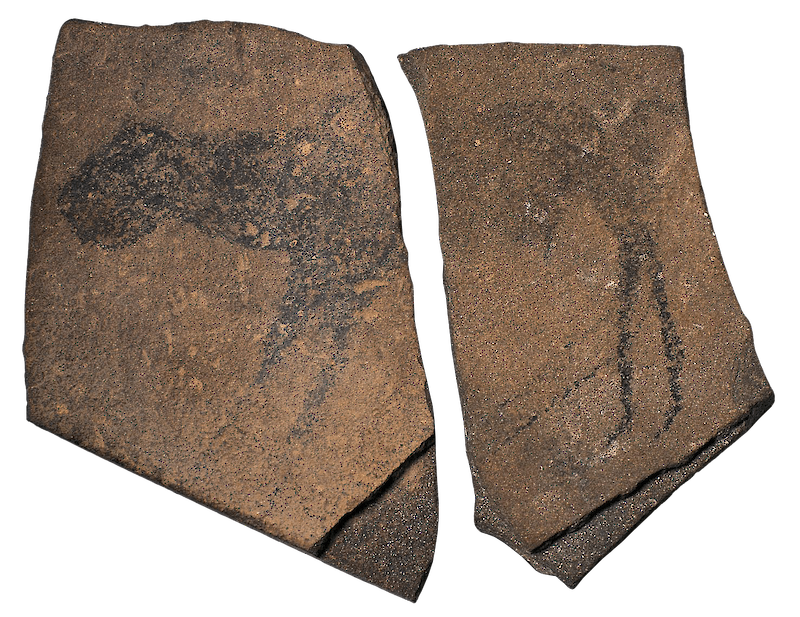
Apollo 11 Stones- 25,500–25,300 B.C.E., Namibia, Charcoal on Stone
Form
Simplistic
Split
Content
Hand-sized
Feline?
Human hind legs
Oryx?
Supernatural
Context
Buried underneath sediment & debris
Earliest evidence of human artistic expression
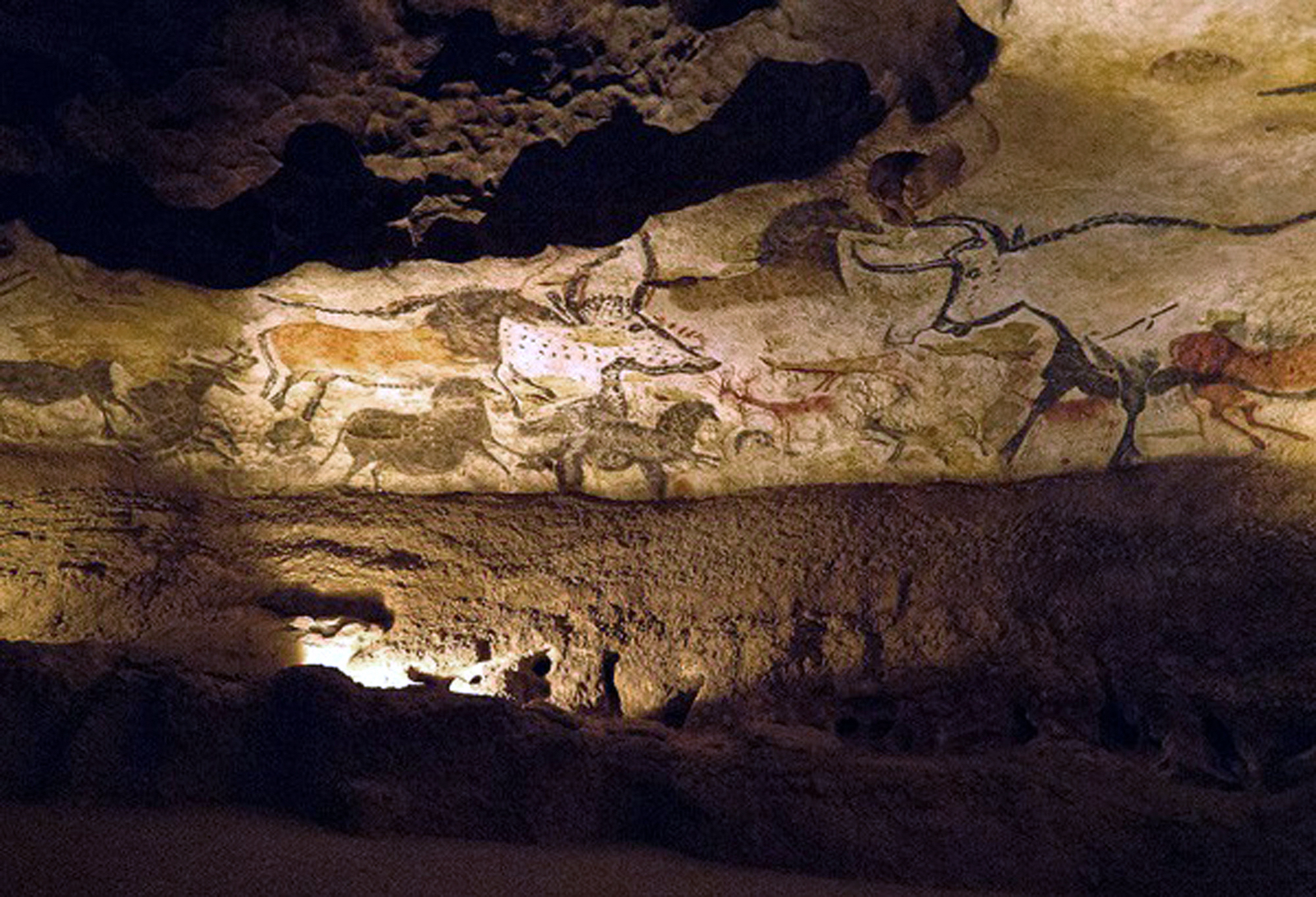
Great Hall of the Bulls- Lascaux, France. Paleolithic Europe, 15,000-13,000 BCE. Rock Painting
Form
Heavy contrast
Naturalistic
Thick Lines
Content
Charcoal
Ocher
Horses, Deer, Bison, elk, lions, rhinos, bears
Context
Twisted perspective
pre-planned
Function
To use for “Hunting Magic”
The belief that creating images of an animal and conducting rituals would ensure a good hunt

Camelid Sacrum in the shape of a canine- Tequixquiac, Central Mexico, 14,000-7,000BCE. Bone.
Form
Smooth
Carved
Polished
Content
Remains of a camelid (camel, llama, alpaca)
Sacrum- triangular bone at spine
Dog (or) pighead
Context
Sacrum- sacred bone (reproductive)

Running Horned Woman- Tassili n’Ajjer, Algeria. 6000-4000 BCE. Pigment on rock
Form
Exaggerated
High contrast
Twisted perspective
Carefree
Content
Woman running
Fringe clothing
Horned
Scarification
Decorated
Context
Priestess? Religious?
Placed high up
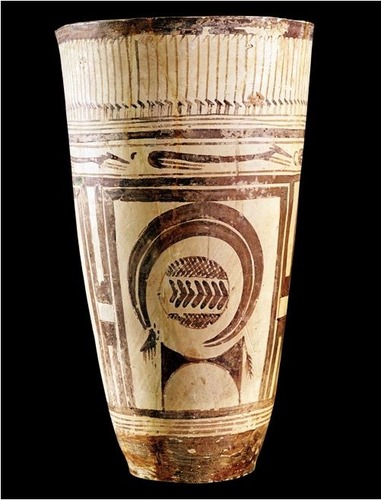
Bushel with Ibex Motifs- Susa, Iran. 4200-3500 BCE, Painted terra cotta
Form
Geometric and organic shapes
Circular and linear
Integration of shape with design
Content
Thin
Imperfect
Mountain goat (Ibex)
Exaggerated horns
Dog (Greyhound?)
Function
Buried at cemetaries
Symbol of fertility
Holding water
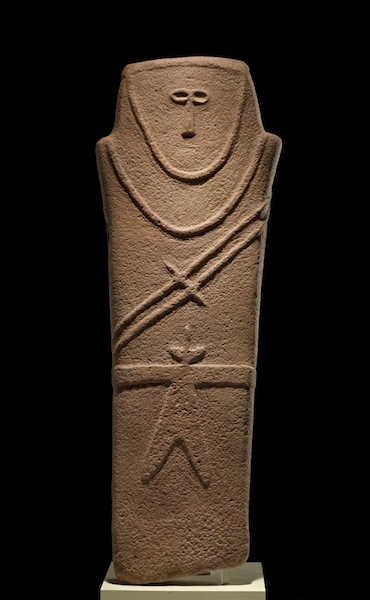
Anthropomorphic Stele- Arabian Peninsula, Neolithic 4000 BCE, Sandstone
Form
low- relief
Vertical
Frontal emphasis
Simple
Content
Abstracted human
3ft tall
Trapezoidal head
Male
Function
Religious
Burial
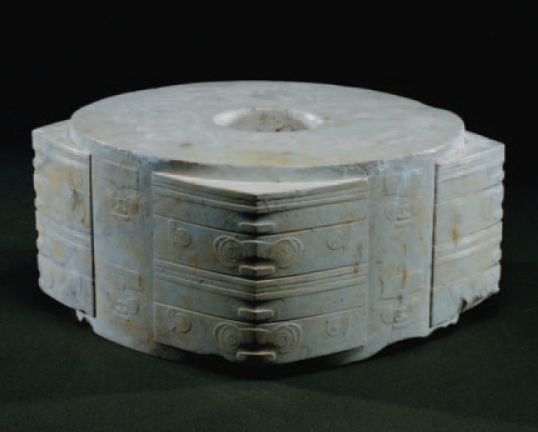
Jade Cong- Liangzhu, China 3300-2200 BCE, Carved Jade
Form
Symmetrical
Low-relief
Content
Square hollow tubes decorated with lines
Circles
Representation of faces
True Jade (Nephrite)
Context
Found in graces
Nephrite, hard to mine and carve
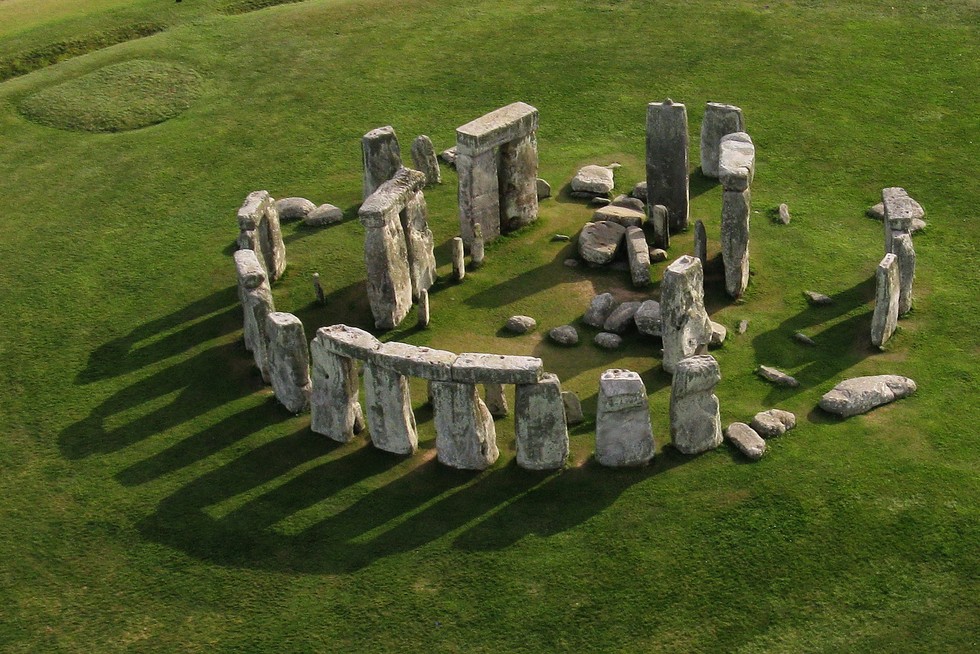
Stonehenge- Wiltshire, UK. Neolithic Europe, 2500-1600 BCE. Sandstone
Form
Uneven
Rough
Inward pull
Content
Large rocks arranged and stacked in a circle
Context
Egalitarian effort
Lintels fitted and curved
Phase one 3100
Ditch dug (henge)
Pits dug
Phase two
Wooden posts in henge
Used for burial(men
Phase three
Placed in circle
Stones erected into lintels

Ambum Stone- Ambum Valley, Enga Province, Papua New Guinea, 1500 BCE. Greywacke
Form
Smooth
Detailed
Symmetrical
Relief
Content
Nondescript animal
Curved
Fetal form
Context
Religious
Ritual mechanism for ancestors to reside in
Believed to move, mate, and reproduce on its own
Importance of commanding natural resources and super natural forces
Sacrificed to ward off danger, promote fertility
Function
Pestle?
Tlatilco female figurine- Central Mexico, site of Tlatilco. 1200-1900 BCE. Ceramic
Form
Supernatural
Exaggerated
Content
Voluptuous female figure
thick af
Two-faced (duality)
Wide hips (fertility)
Context
Burials
Death-Life
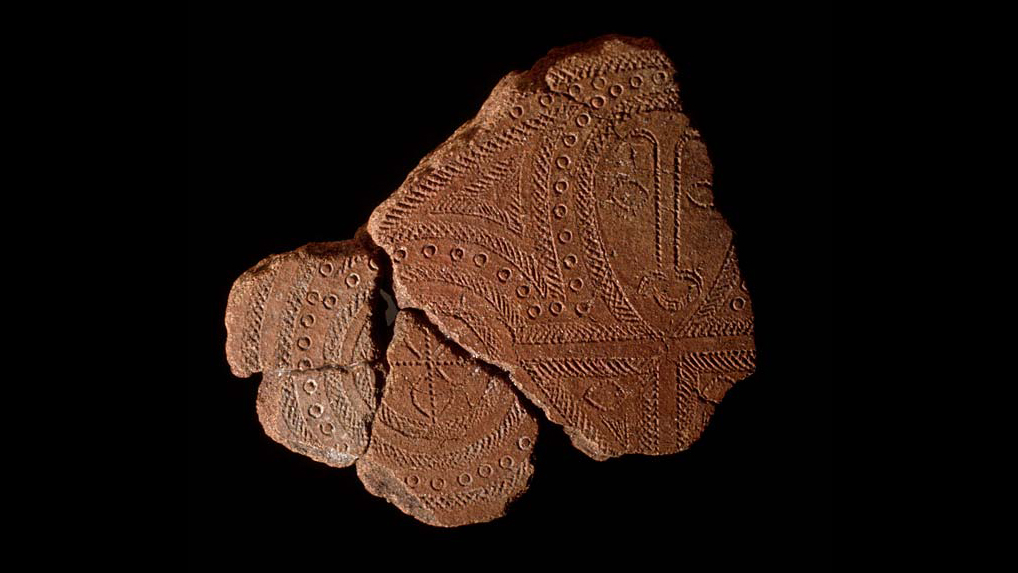
Terra Cotta Fragment- Lapita, Solomon Island, Reef Islands 1000 BCE. Terra Cotta (incised)
Form
Repetition of patter
simple yet intricate
Content
Terra cotta shards w/ patterns
Context
Lapita- very knowledgeable with seafare
Terracotta largely and vastly distributed
Shaped by hand
Paddle and anvil
Low-fire earthenware
Placed in open fire
Clay and Sand -durable af
Design grammar
Function
Serving food or storage
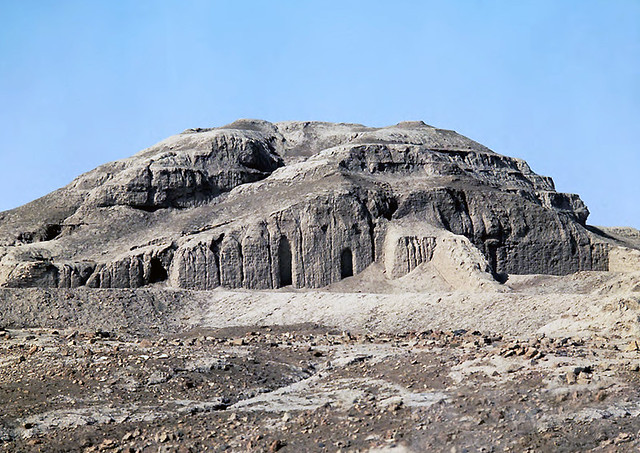
White Temple and its Ziggurat- Uruk, Iraq. Sumerian 3500-3000 BCE. Mud Brick
Form
Simple
Dull
Content
Temple (White)
Defensive walls
Striped
Raised platform with four sloping sides
Context
First writing appeared in Mesopotamia
Dedicated to the sky god Anu
Focal point and symbolic center of the city
Walk around to enter
labor intensive
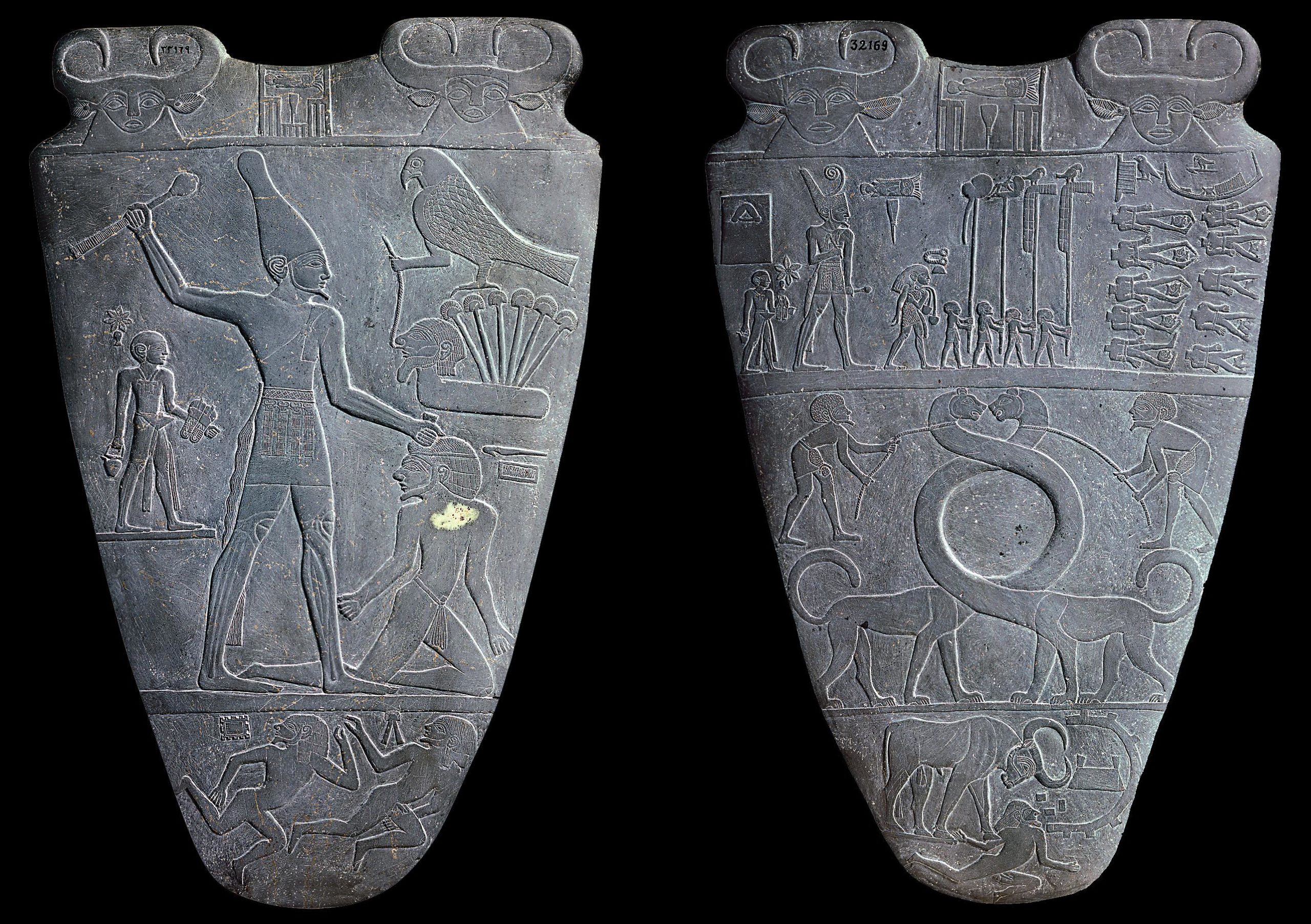
Palette of King Narmer- Predynastic Egypt. 3000-2920 BCE. Greywacke
Form
Low-relief
Smooth
Angular
Flat
Hierarchy of scale
Content
Registers
King Narmer
Horus
Dead foes
Gods/Goddesses
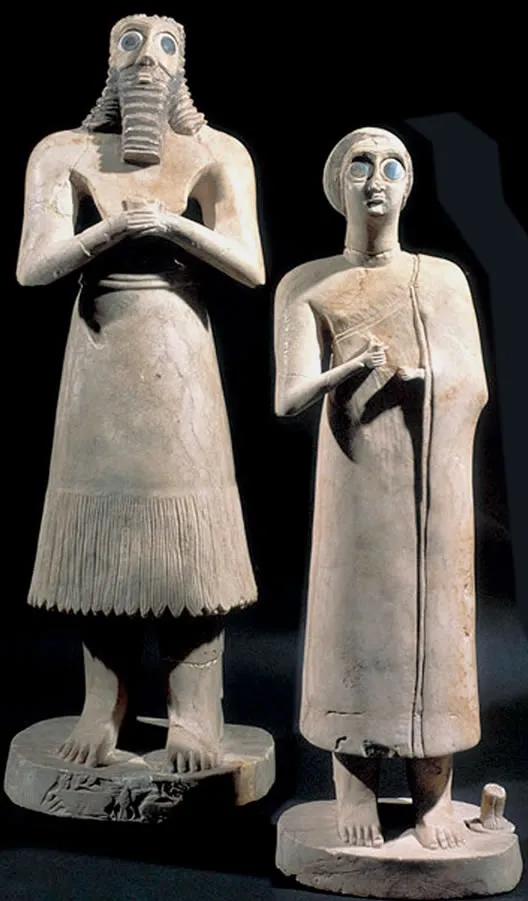
Statues of votive figures, from the Square Temple at Eshnunna- Iraq, Sumerian. 2700 BCE. Gypsum inlaid with shell and black limestone
Form
Smooth
Placid
Symmetrical
Dull
Attentive
Erect
Geometric
Content
Big eyes
Platform above the ground
Clasped hands
Shoulders big
Context
Buried in the floor of a temple
1-3 ft tall
Dynastic Sumerian culture
Function
To represent an elite member of society who wished to be placed in front of a statue of God in order to maintain constant prayer
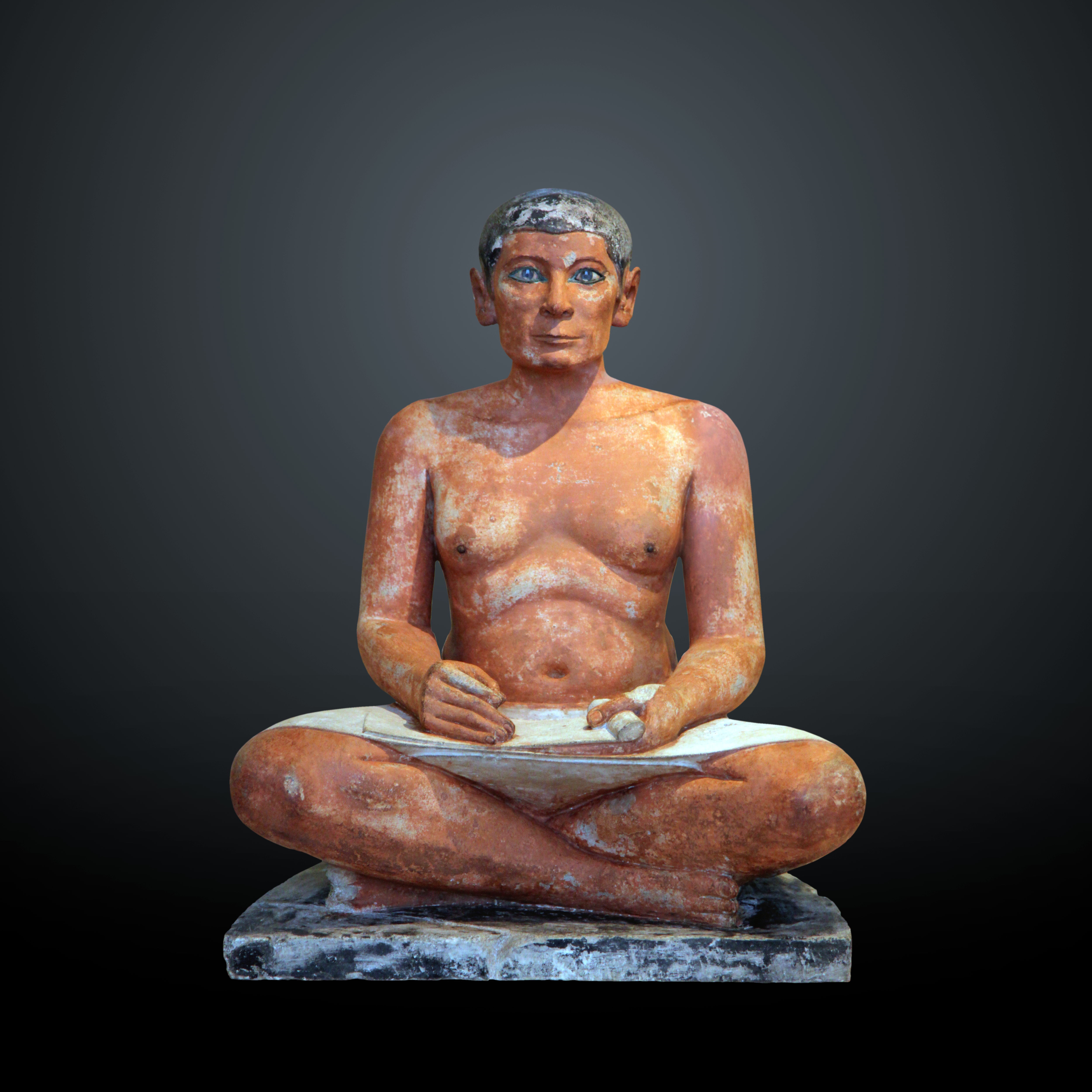
Seated Scribe- Saqqara, Egypt. Old Kingdom, Fourth Dynasty. 2620-2500 BCE, painted limestone
Form
Bright
Still
Realistic
Symmetrical (except hands)
Frontal
Content
Man sitting peacefully
writing
Very relaxed
Context
Crystal eyes
Wooden hips
Scribes valued highly within society
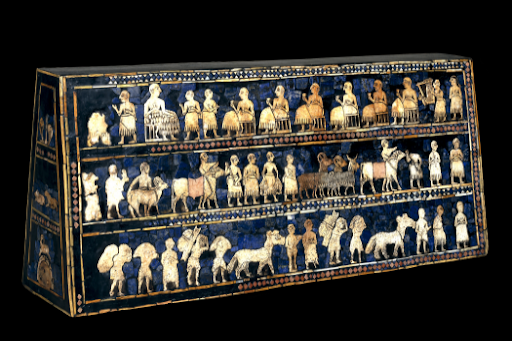
Standard of Ur From the Royal Tombs at Ur- Sumerian. 2600-2400BCE. Wood inlaid with shell, lapis, and red limestone
Form
Intricate
Content
3 layers representing divisions of power
War side
Peace side
Context
Unknown what was inside
Materials obtained through long distance trade
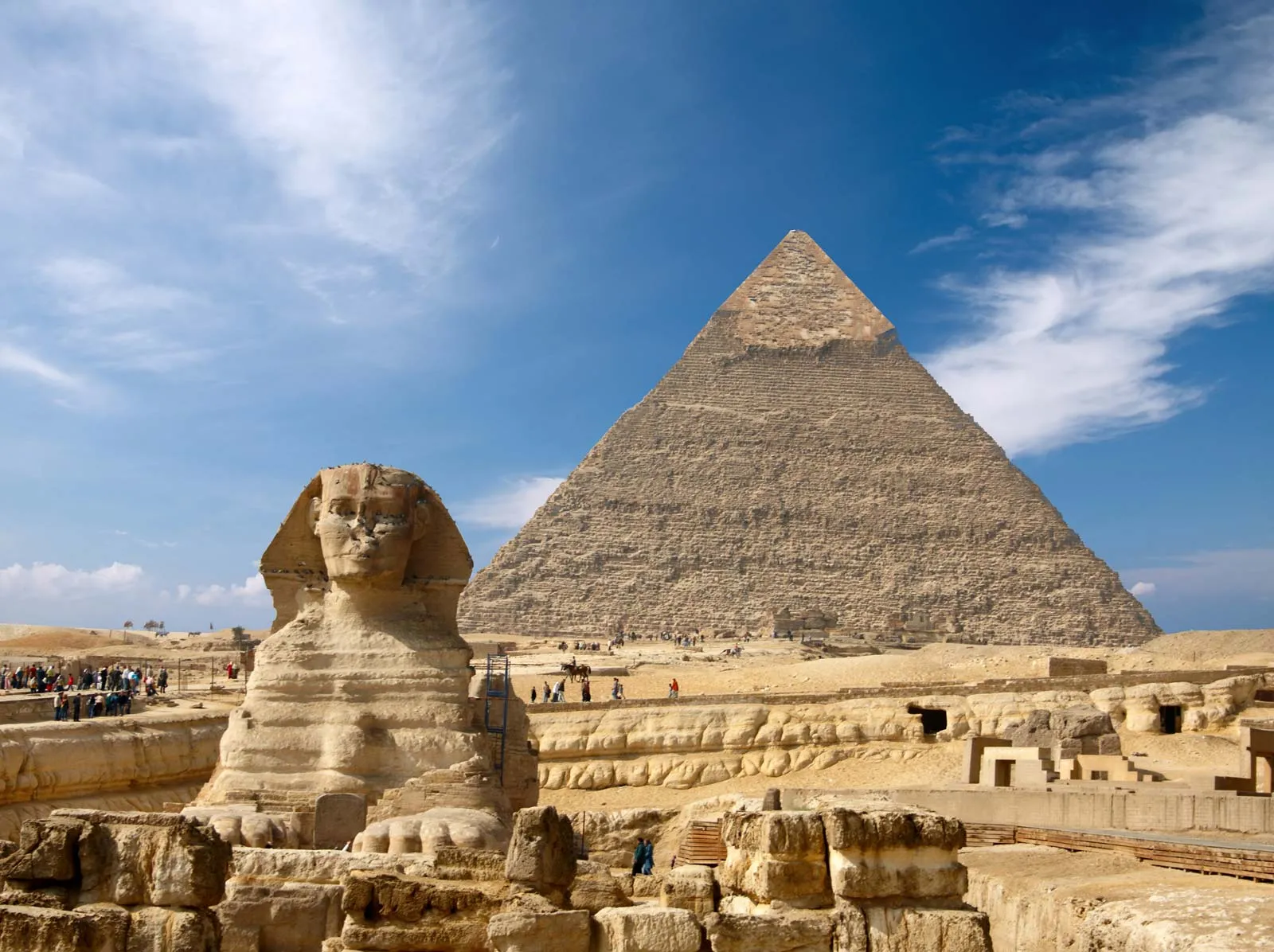
Great Pyramids (Menkaura, Khafre, Khufu) and Great Sphinx- Giza, Egypt. Old Kingdom, Fourth Dynasty. 2550-2490 BCE. Cut Limestone
Form
Large
Textured
Content
Khufu
Largest
Precise
50 tons
Unique passageways
Boat pits for the afterlife
Context
Intense labor
One pyramid per ruler
Queens had smaller satellite pyramids
Cemetery in Khufu
Solar references
Rays
Path for pharaoh into the sky
Function
Place of regeneration for deceased rulers
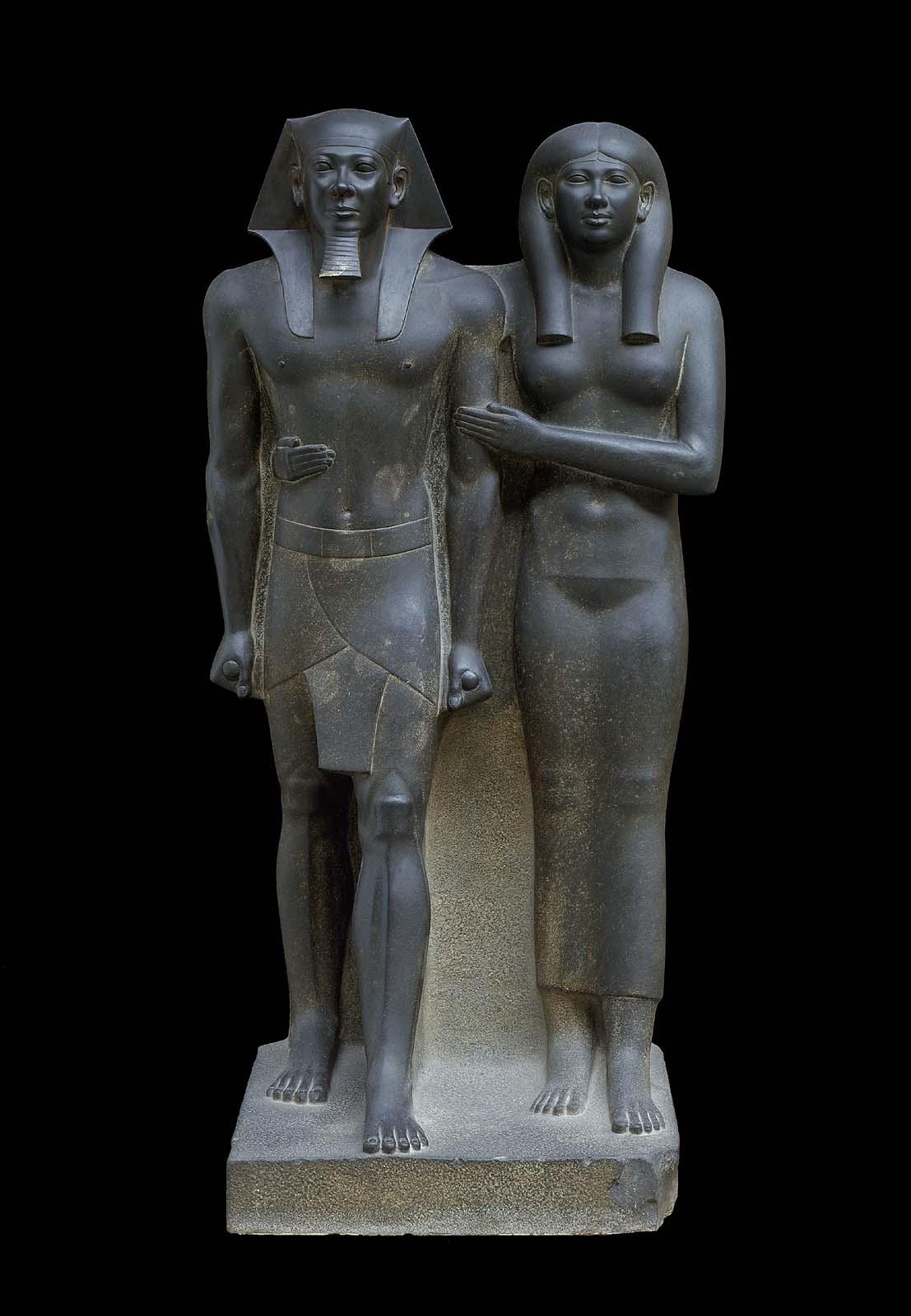
King Menkaura and Queen- Old Kingdom, Fourth Dynasty. 2490-2472 BCE. Greywacke
Form
Regal
Smooth
Even
Movement
Base/platform
Content
King and Queen
Menkaure head facing right and walking
Straight & Strong bodies
Youthful
Beauty
Royal formality
No protective cobra
Context
Life sized
Smooth as silk
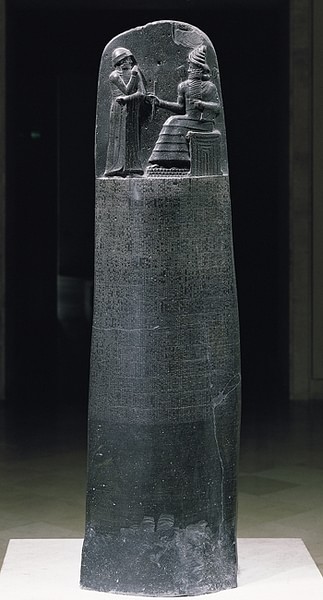
The Code of Hammurabi- Babylon (Iran), Susian. 1792-1750 BCE. Basalt
Form
Smooth
Subtractive
Monotone
Content
Thick stone w/ depictions of King Hammurabi and Shamash
Shamash giving king scepter & ring
Cuneiform
Stele
Relief
Context
King Hammurabi
Shamash (Sun god/god of justice)
Equivalence (Eye for an eye_
Importance of king
Importance of social norms
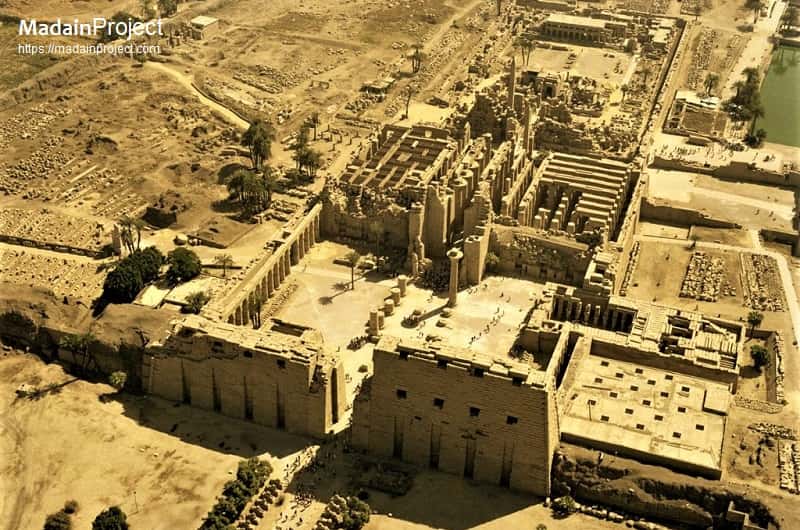
Temple of Amun-Re and Hypostyle Hall- Karnak/Luxor, Egypt. New Kingdom, 18th and 19th dynasties. 1550 BCE- 1250 BCE. Cut Sandstone and mudbrick
Form
Symmetry
Bright and colorful
Content
Lots of temples and chapels
Sacred lake
Workshops
Two axes
Red granite obelisk for hatshepsut
Hypostyle hall
Context
Cult image of Amun
Tallest obelisk in Egypt
Clerestory lighting
Limited access
Temples- beginning of creation
Mound of creation emerging from primeval waters
Function
Place for god to dwell on earth
Working estate for priests
To reflect the beginning of creation
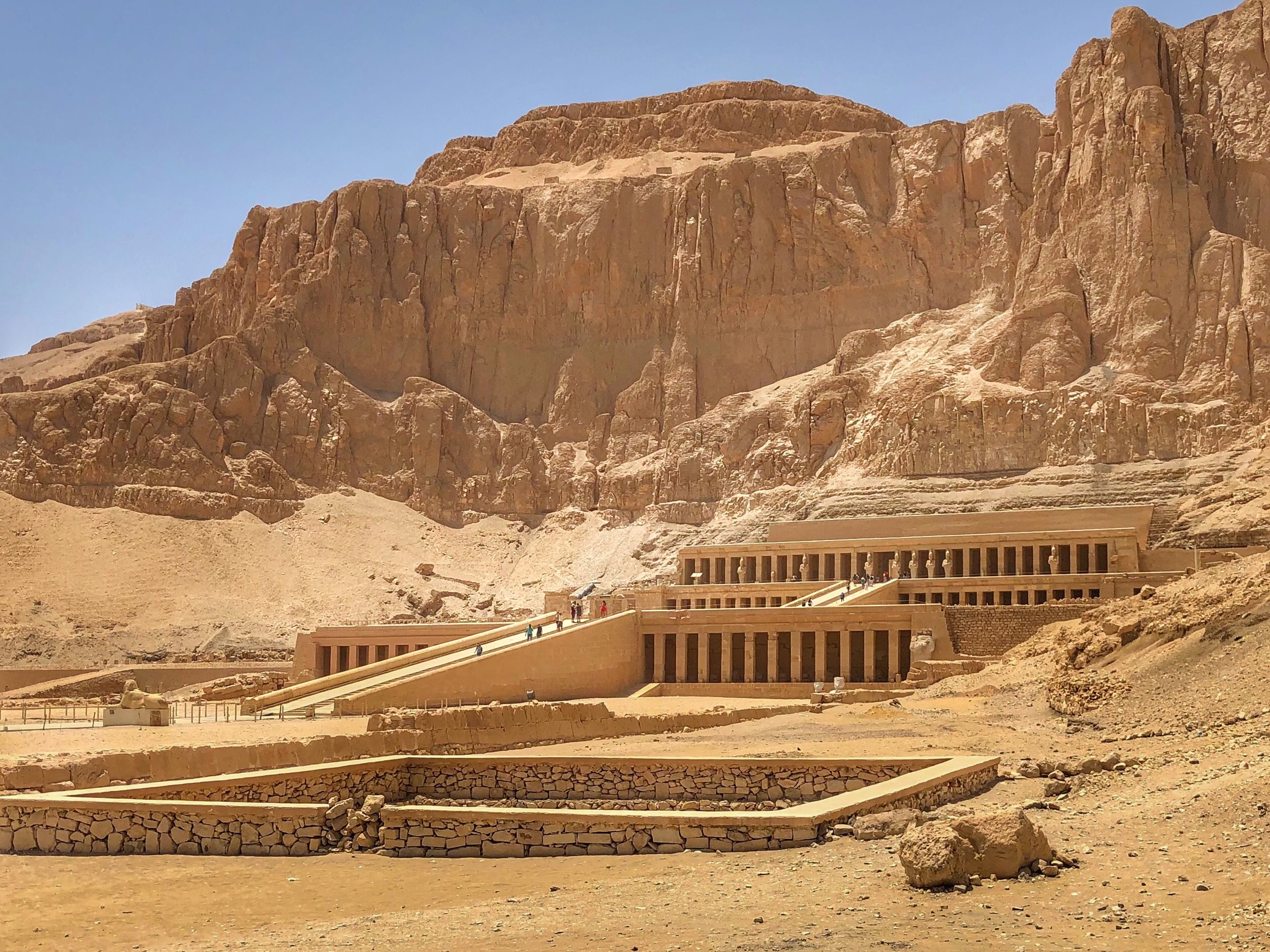
Mortuary Temple of Hatshepsut- Luxor, Egypt. New Kingdom. 18th dynasty, 1473- 1458 BCE. Sandstone, carved into cliff, red granite
Form
Rigid
patterned
Contrast with surroundings
Content
Statues
Cliff face
Building
Kneeling statue of Hatshepsut
Context
Ritual sculpture of god carried from Thebes to temple
land of living- dead
First Woman pharaoh
Created her own mythology to justify her rule
two decades
Beginning of new period
Use of traditional Egyptian art and symbols for “king”
Kneeling statue placed in pathway for procession of God statue
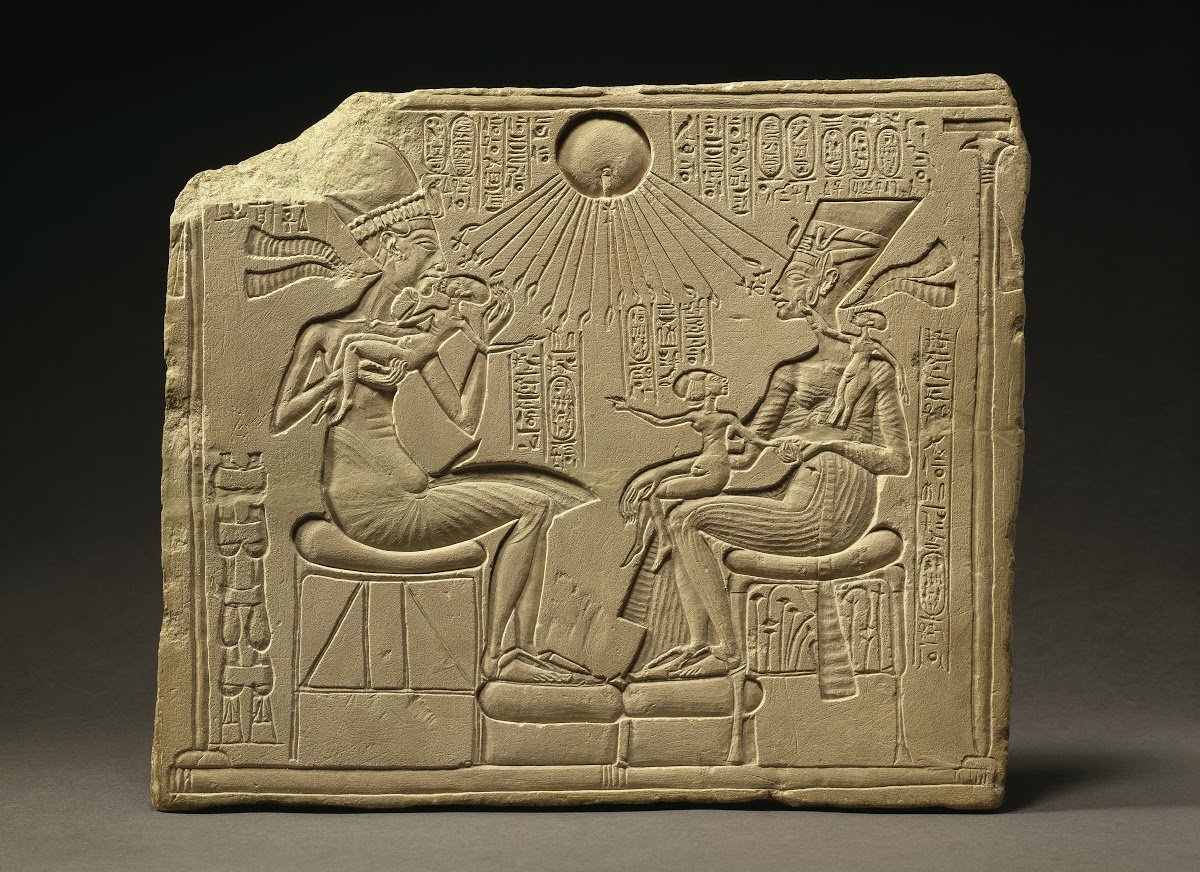
Akhenaton, Nefertiti, and three daughters- New Kingdom (Amarna) 18th dynasty, 1353-1335 BCE. LImestone
Form
Low-relief
Symmetry
informal
soft
Content
Akhenaton, Nefertiti, and three daughters
Swollen bellies
Long arms
Frontal eye view
Hands and ankhs at sun (Aton) rays
Context
Akhenaton changes religion (monotheistic)
Amun- Aten
him and his wife the only worthy ones
Alter piece
Domestic

Tutankhamun’s Tomb, innermost coffin- New Kingdom, 18th dynasty, 1323 BCE. Gold with inlay of enamel and semi precious stones
Form
Bright
Symmetrical
Stoic
Content
3 Coffins
Outer two- wood covered in gold and lapis etc.
Inner- solid gold
Crook and flail (divine right)
Nekhbet and wadjet gods across torse
Isis and Nephthys etched into gold lid
Context
Refocus of worship to Amun
Recentering of Thebes as central area
Married to half-sister
Pharaoh
Skin of Gold
Bones of silver
Hair of Lapis
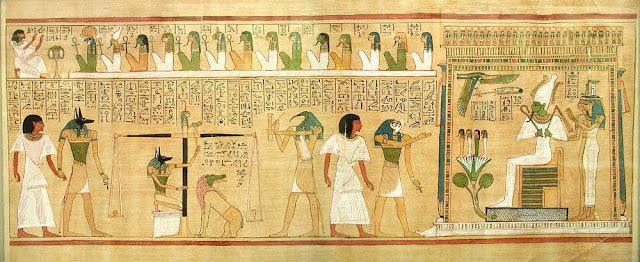
Last Judgement of Hu-Nefer, from his tomb (page from book of the dead). New Kingdom, 19th dynasty, 1275 BCE. Painted papyrus scroll
Form
Clear
Structure
Content
Hu-Nefer talking to gods
Ma’at divine order
Thoth recording
Hu-nefer’s hear being weight against a feather
Successfully lighter
Horus
Ankh
Symbols of NESW
Osiris a tthe end of the hall
Lotus (Eternal life)
Isis and Nephythys (gods of after life
Context
Book of the dead
Tutorial for making it into the afterlife
Hu-nefer was a royal scribe of high statues
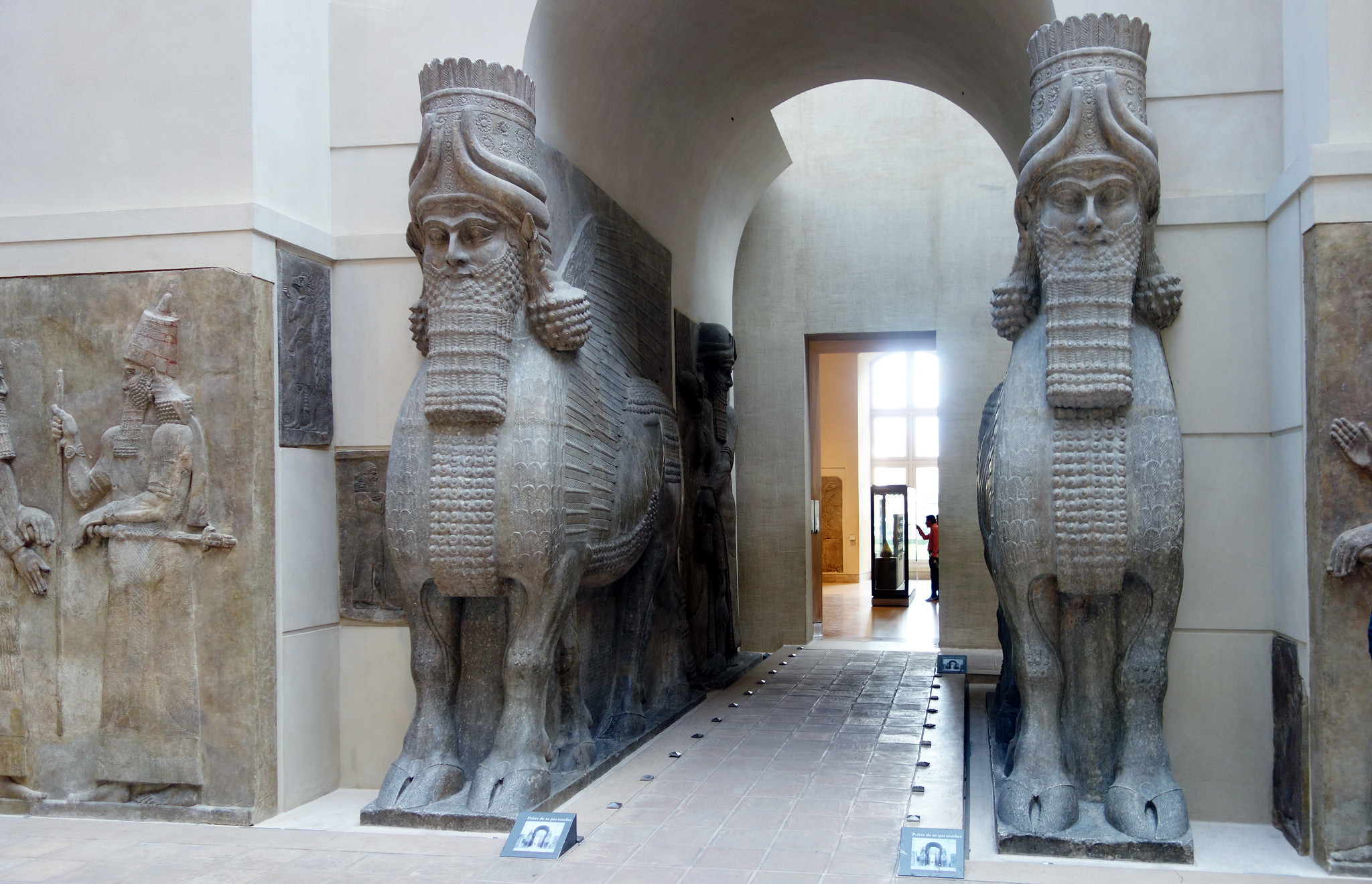
Lamassu from the citadel of Sargon II- Dur Sharrukin (Iraq) Neo-Assyrian. 720-705 BCE. Alabaster
Form
Patterned
Large
Powerful
Decorative
Content
Winged bulls with heads of men
Crown w/ rosettes
Horns
Ring of feathers
Beards, eyebrows, hair
Cuneiform inscriptions
Five legs
Stable from front
Moving from side
Context
Carved at heigh of Assyrian civilization
Guardians of temples and palace
Structural purpose
Monolithic
Gateway
Function
To show the power and authority of the king and the fortress
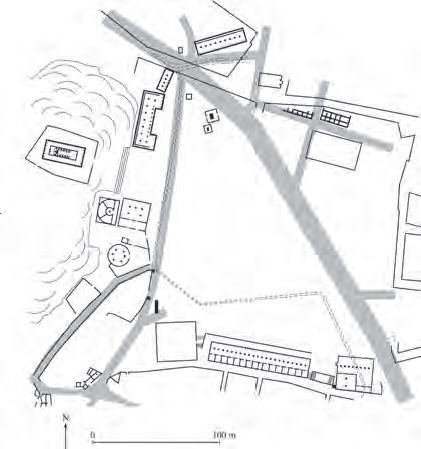
Athenian Agora- Archaic/Hellenistic Greek, 600 BCE- 150 CE. PLan
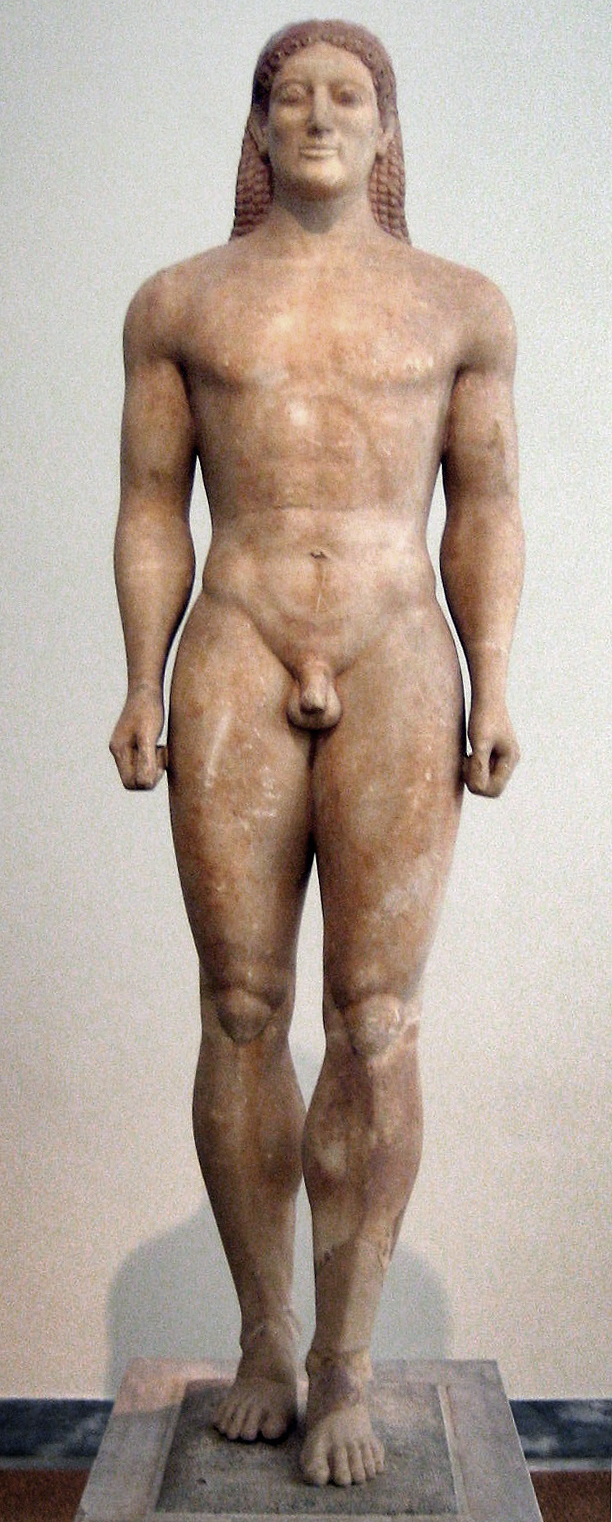
Anavysos Kouros- Archaic Greek. 530 BCE, Marble with paint
Form
Bright
Frontal
Symmetrical
Naturalistic
Content
Idealized naked man (youth) standing straight up
Stepping forward (left leg)
Braided hair
Archaic smile
Context
Inscription
Dead youth who fell in battle
Aristocratic
Ideal body
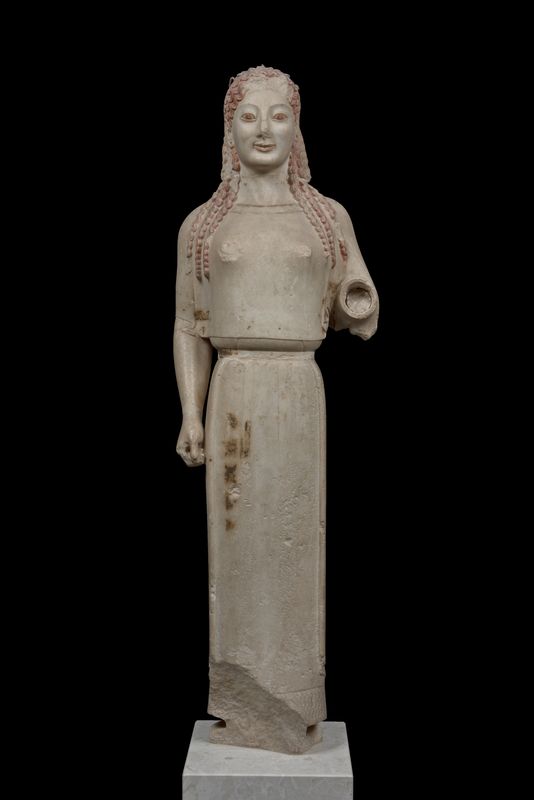
Peplos Kore from the Acropolis- Archaic Greek 530 BCE, Marble, painted
Form
Bright color
Stoic
Smooth
Frontal
Powerful
Content
Woman dressed in peplos
Makeup
Curly hair
Context
Kore- statue of young women to mark graves or serve as votive figures
Peplos- dress worn by women in Greece
Folding
Outdated by time of carving
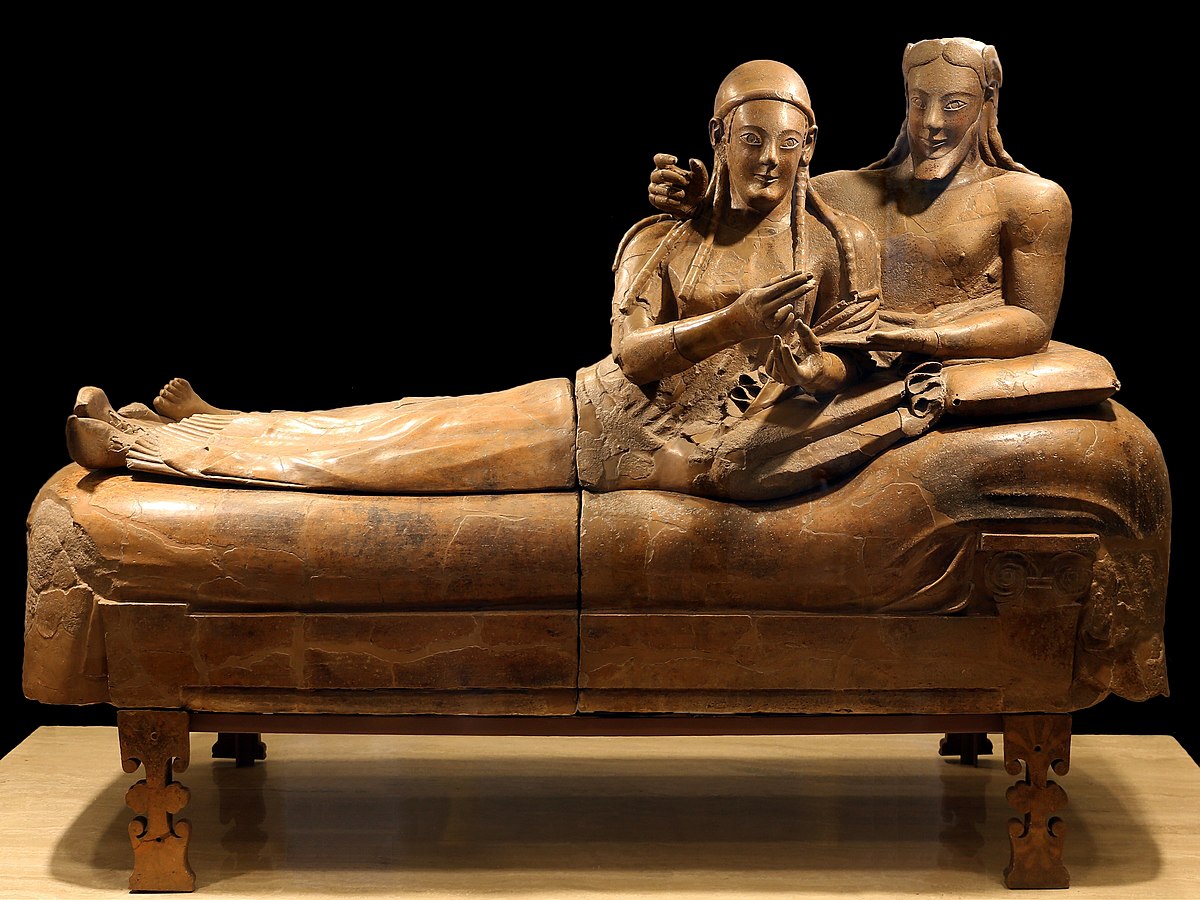
Sarcophagus of the Spouses- Etruscan, 520 BCE. TerraCotta
Form
Smooth
Direct
Intimate
Domestic
Content
A couple laying together
Context
High importance of funerary tradition within Etruscan society
Function
Sarcophagus for a couple who wished to be buried together
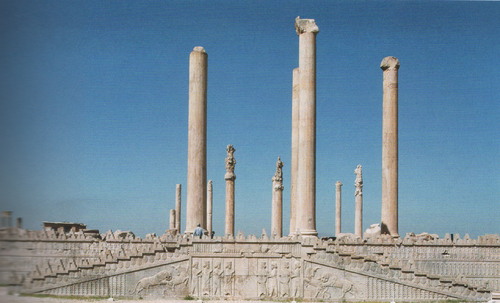
Audience Hall (apadana) of Darius and Xerxes- Persepolis, Iran, Persian. 520-465 BCE. Limestone
Form
Vertical
Smooth
Multipiece
Hypostyle
Content
Tops of columns depicting royal animals
stairs with relief structures
to be viewed by tributes being brought to the king
Elites and military
Context
Economic center
Microcosm of the empire
City of the persions
Darius named it “Royal Hill”
Residential, treasury, ceremonial, fortifications

Temple of Minerva and Sculpture of Apollo- Near Rome, Italy. 510-500 BCE. Original temple of wood, mud brick, tufa, terra cotta sculpture
Form
Dynamic
Content
Temple
High podium
Frontal entrence
Triple cella (divine triad)
Single entrance
Apollo
Etruscan assimilation of Greek Gods
Placed on roof with other sculptures
Context/ Function
ritual space
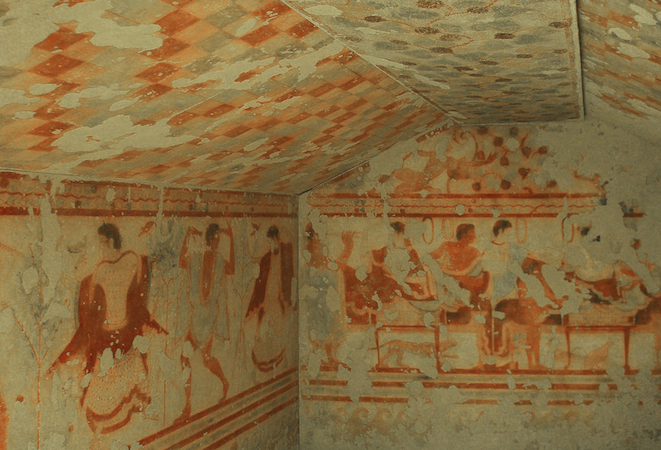
Tomb of the Triclinium- Etruscan, Italy, 480-470 BCE. Tufa and Fresco
Form
Colorful
Registers
Animated
Patterned
Content
Subterranean rock-cut chambers
Banqueters enjoying a dinner party
Bright robes (Elite)
Animals under couch
Dancers and Musicians
Women with fairer skin
Checkers (similar to fabric worn for funerary rituals)
Context
MOST affluent
Contains remains and goods
Tufa- easy to carve
Multi-gen tombes
Etruscans have extensive funerary traditions
Necropolis
Oral tradition (pantheon of Gods) almost identical to Greeks and Romans
Seafaring
Function
To display Etruscan funeral culture
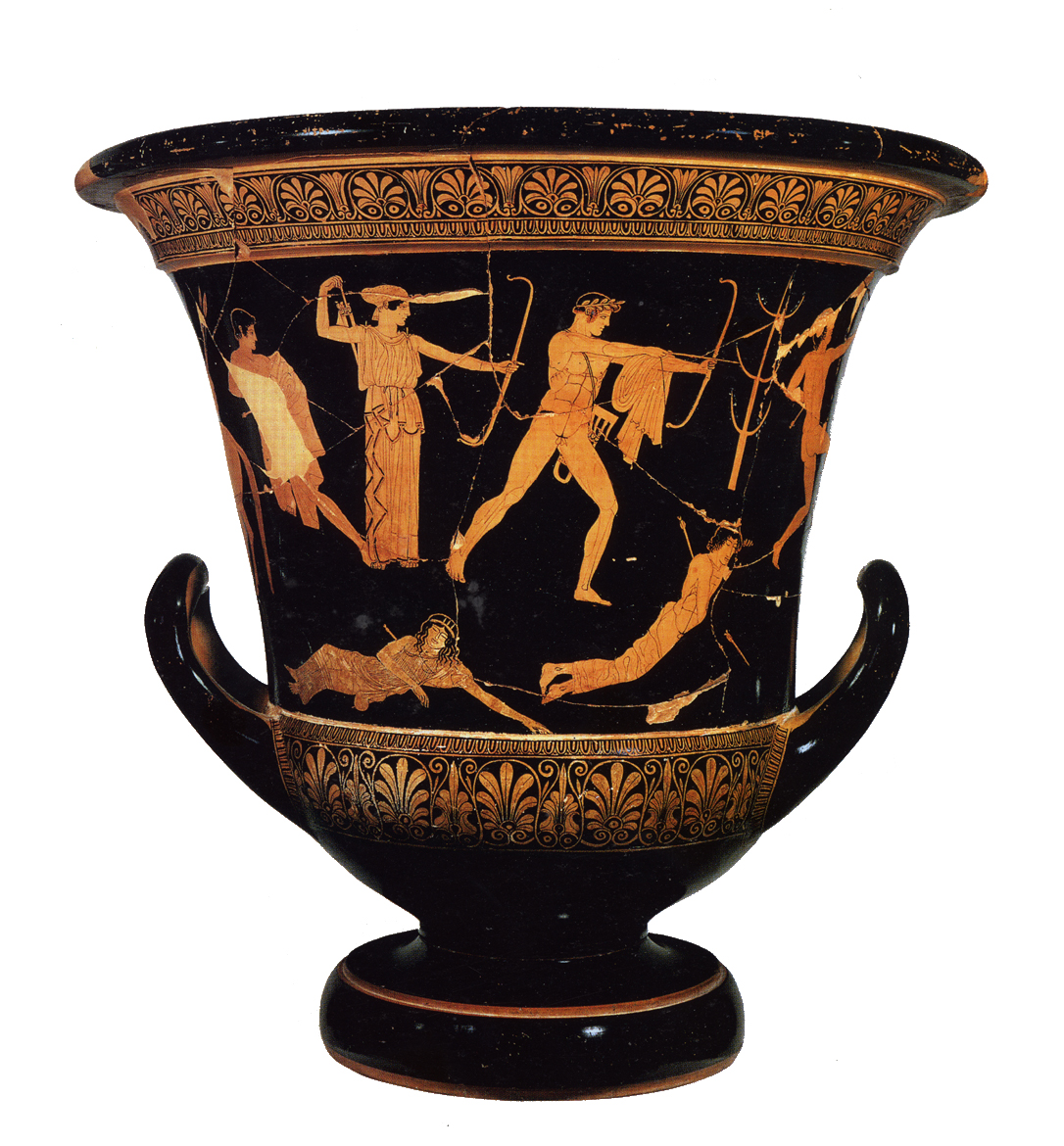
Niobedes Krater- Anonymous painter known as Niobid painter. 460-450 BCE. Clay, red-figure technique.
Form
Harsh contrast in color
Stiff
Detailed
Delicate
Content
Vase with a mural
Niobe who bragged abt her children to the Goddess Leto
Leto’s children (Apollo and Artemis) seek revenge
Hubris
Herakles and Athena
Context
Calyx Krater- punch bowl
Red figure painting
red clay, silhouetted by black
“Severe style”
Multiple levels
Illusion of space and scale
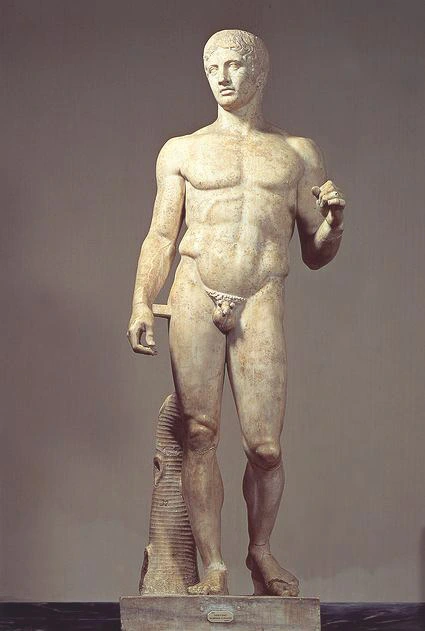
Doryphorous (Spear bearer)- Polykelitos, 450-440 BCE.
Form
Naturalistic
Contrapposto
Content
Ideal form based on man
“Spear Bearer”
Muscular man standing
Context
Mathematical body perfection
Roman depiction of perfect body
Nude shows beauty of human form
Kouros style
More flued
Curved (breaking symmetry)
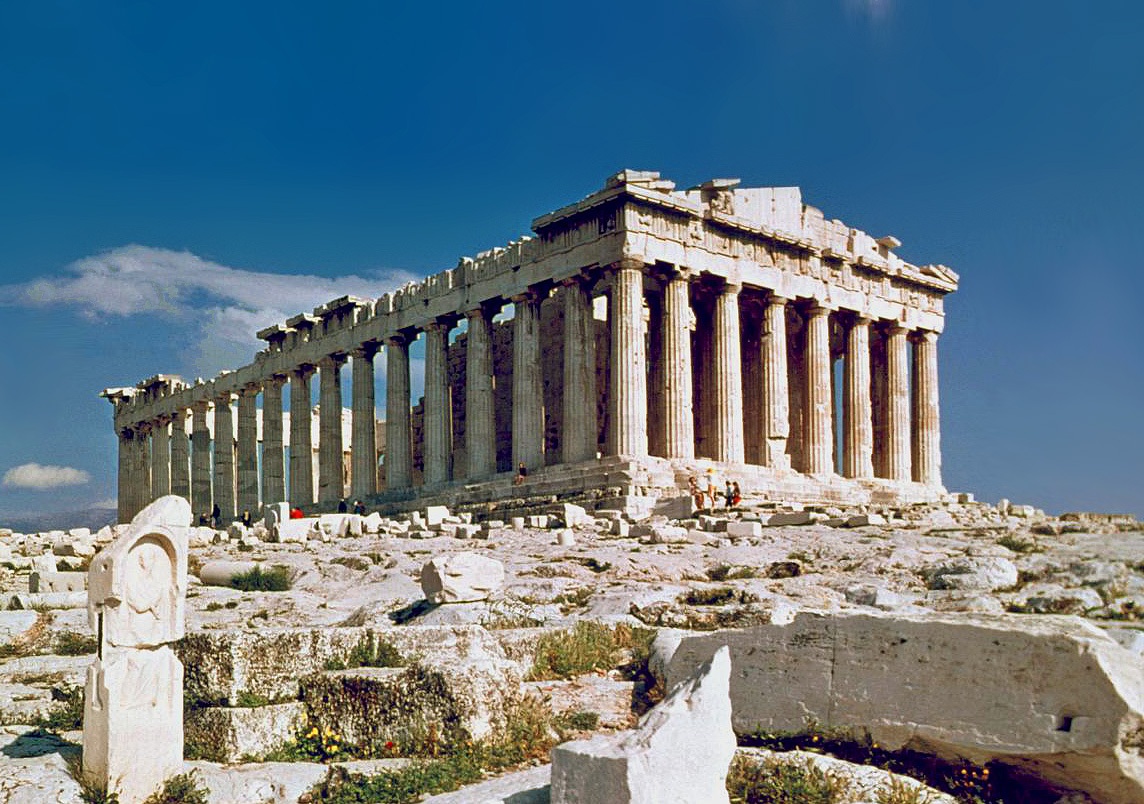
Acropolis (Parthenon, Nike Adjusting her sandal)- Athens, Greece. Iktinos and Kallikrates. 447-410 BCe. Marble
Form
Painted and colored
Solemnity
Phidian
Doric and Ionic
Content
West pediment- story of Athena and Poseidon
East Pediment- Birth of Athena
Giant sculpture of Athena
Metopes
Greeks vs enemies (Greeks vs. Persians)
Nike adjusting her sandal
Outward
Off balance
Erotic/ revealing
Context
Atop rocky cliffs
Fortified
Built during Athens’ peak
Peak high Classical
Dedicated to Athena
House of Delian league
Architects were mathmaticians
Individually cut stones
Few right angles
entasis
Yearly procession to honor Athena
Function
Treasury
Symbol of loyalty to Athena
Symbol of city’s wealth
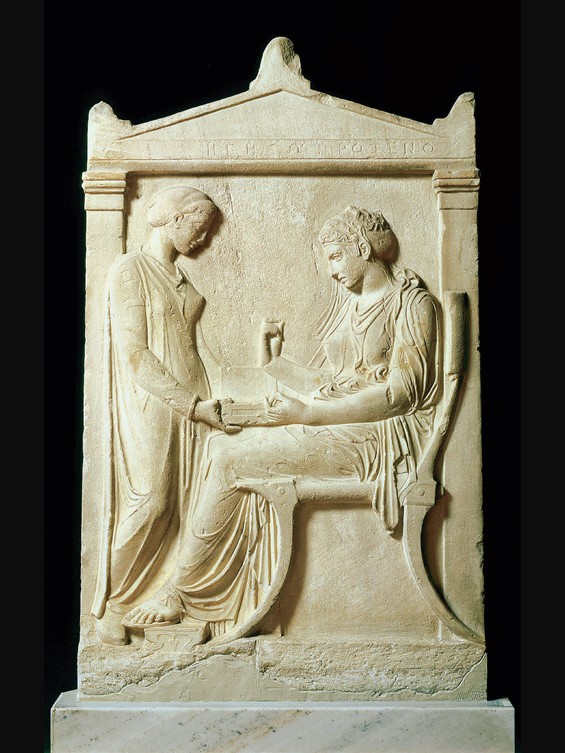
Grave Stele of Hegeso- Kallimachos, 410 BCE. Marble and paint
Form
Framed
Naturalistic
Precise
Textured
Quiet
Content
Gravestone
Domestic setting
Defined by relationship with men in the label of the stone
Hegeso
Atop foot rest
Context
End of high-classical moment
Funerary
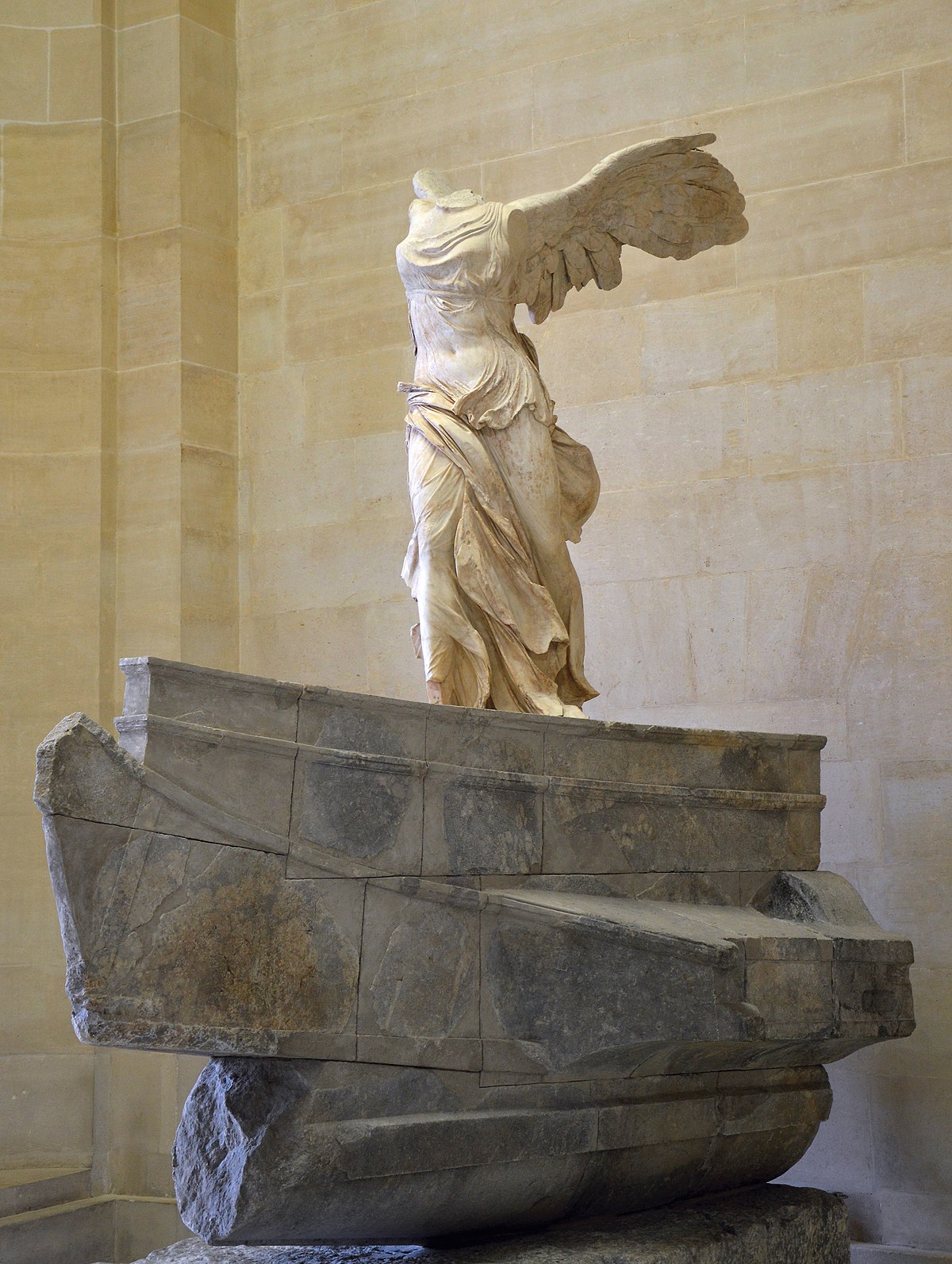
Winged Victory of Samothrace- Hellenistic Greek 190 BCE, Marble
Form
Phidian
Expressive
Energetic
Powerful
Content
Wind
Facing the coast
Nike
Landing on a war ship
Context
Goddess of Victory
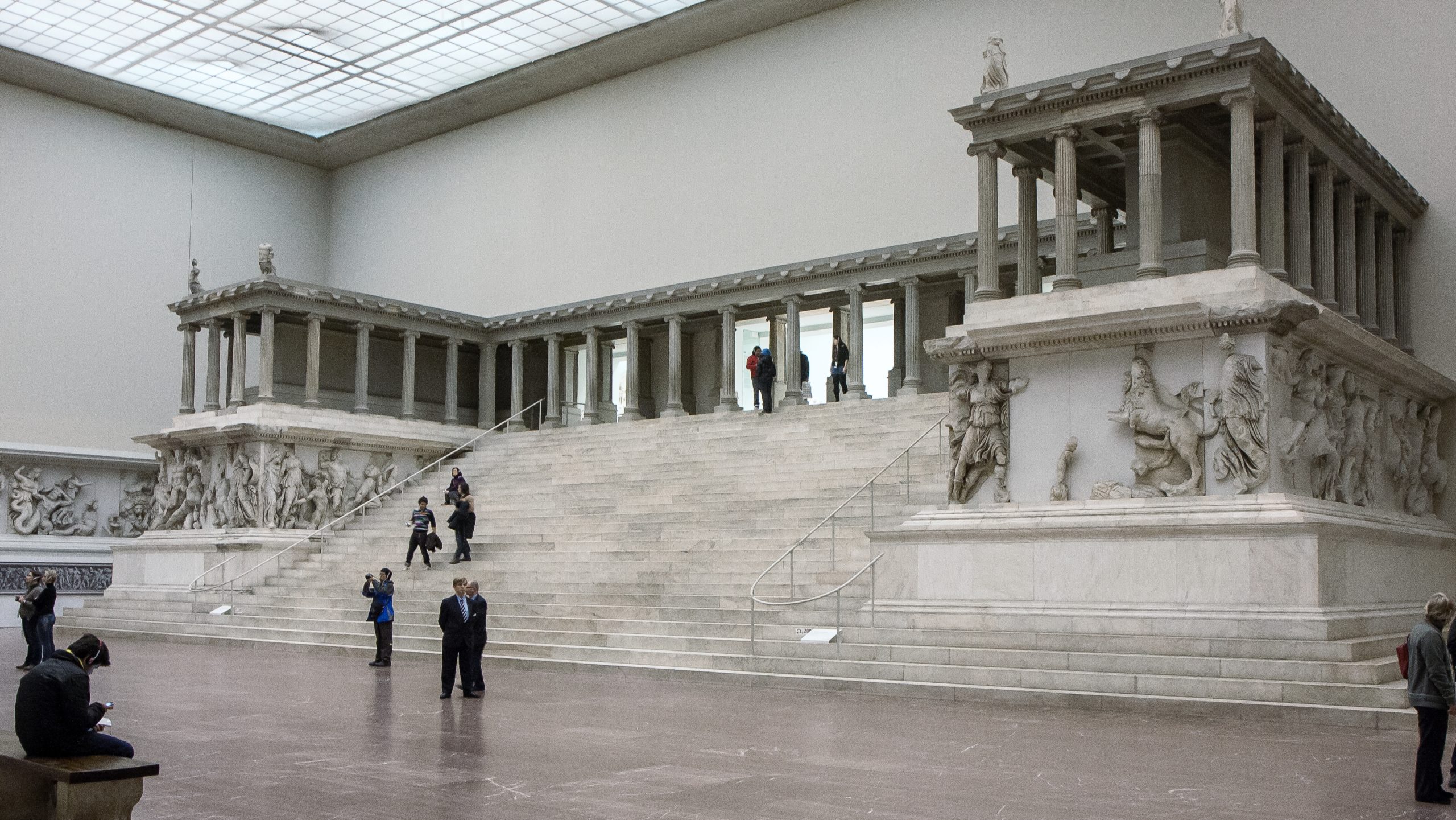
Great Altar of Zeus and Athena at Pergamon- Asia Minor (present day Turkey) Hellenistic Greek. 175 BCE. Marble.
Form
High relief
3D (entering our world)
Dramatic
Expressive
Swirly
Dense
Content
Celestial battle
Giants vs. Gods for control of earth
Colonnades
Context
Fire for Zeus
Sacrifices
In Prussia they wanted to inherit strength of strong militaristic predecessors
Atop acropolis, surrounded by library
Alexander the Great Hellenization
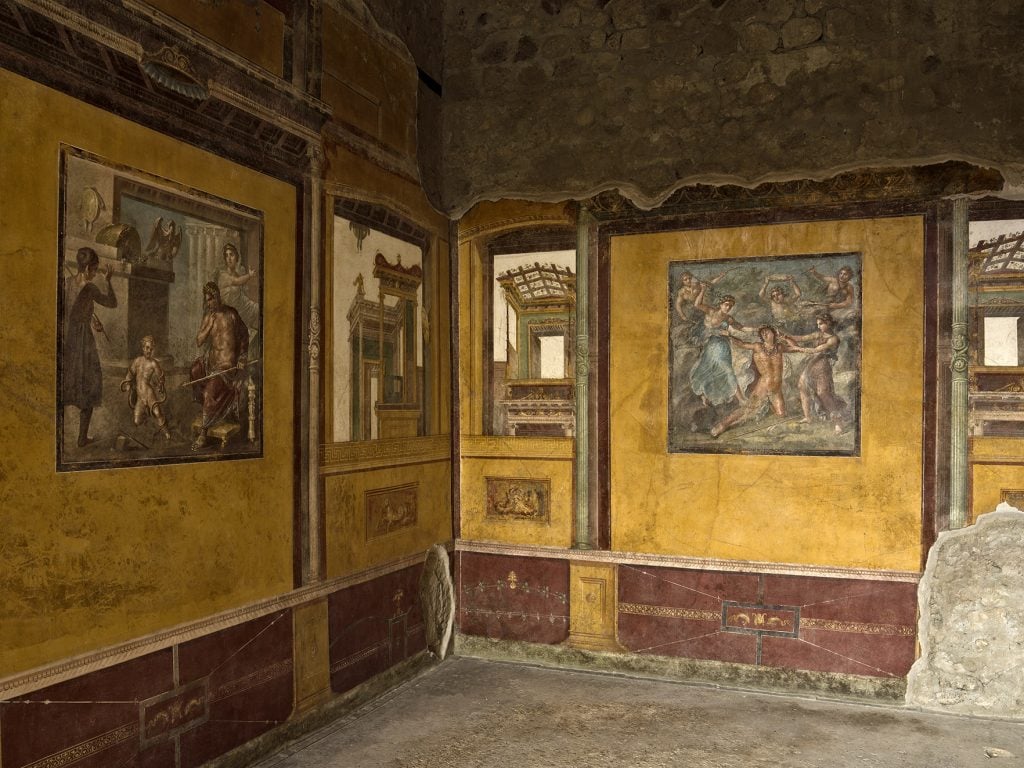
House of the Vettii- Pompeii, Italy, Imperial Roman. Second century BCE, rebuild 62-79 CE. Cut stone and fresco
Content
Roman Townhouse
Canonical ref. for domestic architecture
Flanked by wings
Bounded by bedrooms
office of the head of the house links private to public part of household
Open colonnaded courtyard
painting of god priapus weighing penis with a bag of money
Wall paintings
Context
Entered by street from narrow doorway
Owned by freedman
Newly riche
Domus Architecture
House as sacred space for ritual and display of social hierarchy
Patron-client
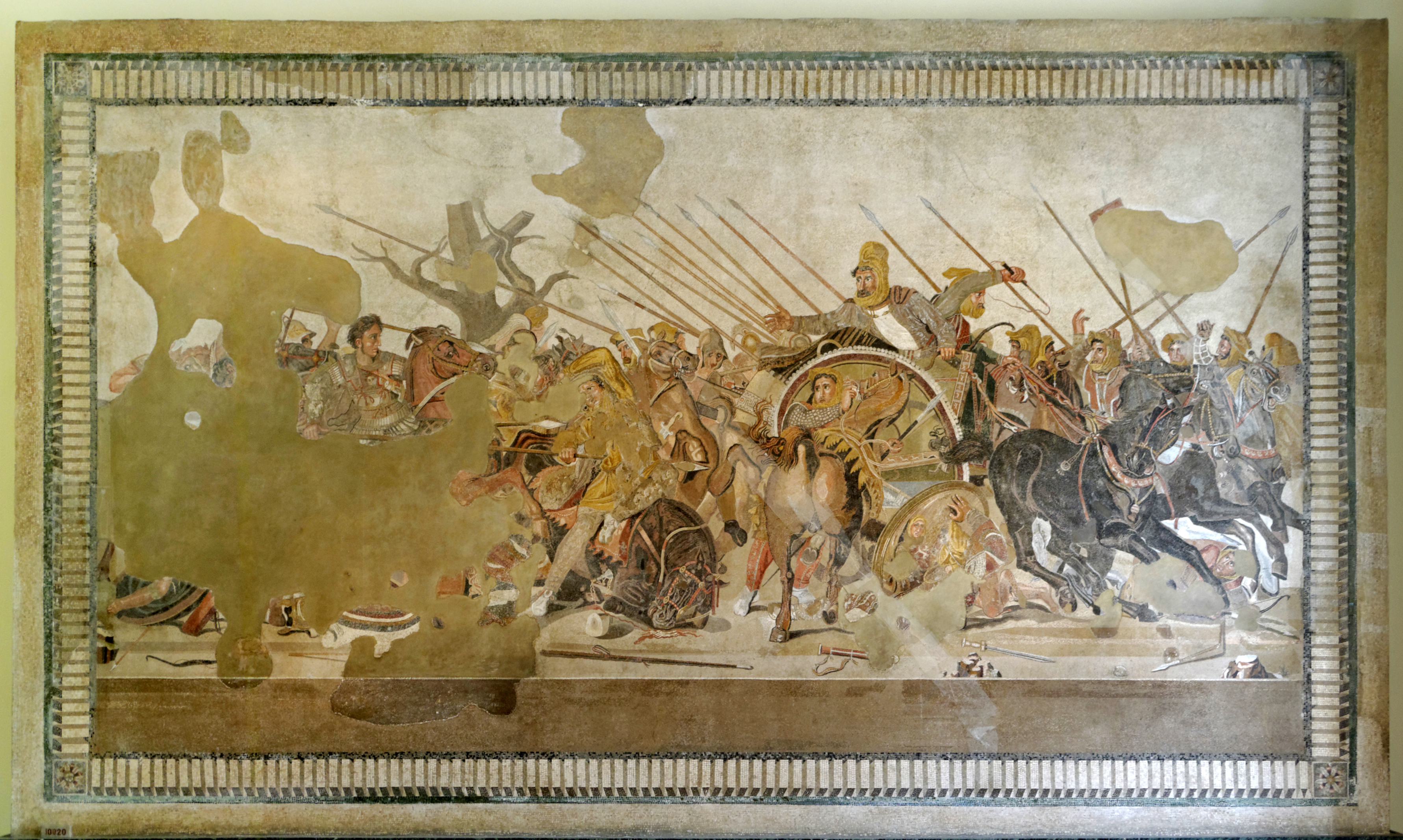
Alexander Mosaic from the House of Faun, Pompeii- Republican Roman 100BCE. Mosaic
Form
Bright
Explosive
Chaotic
Moving
Weighed down
Elaborate
Content
Battle of Issus
Darius (persian king) retracting from Alexander TG power
Tension
Momentum
Chariot spinning back
Seated Boxer- Hellenistic Greek, 100 BCE, Bronze
Form
Stoic
Naturalistic
Informal
Relaxed
Content
Not ideal
Defeated/exhausted
Wounded
Cauliflower ear
Scars/cuts
Muscular
Context
Greek originally
Lost wax casting
Missing eyes
Carved
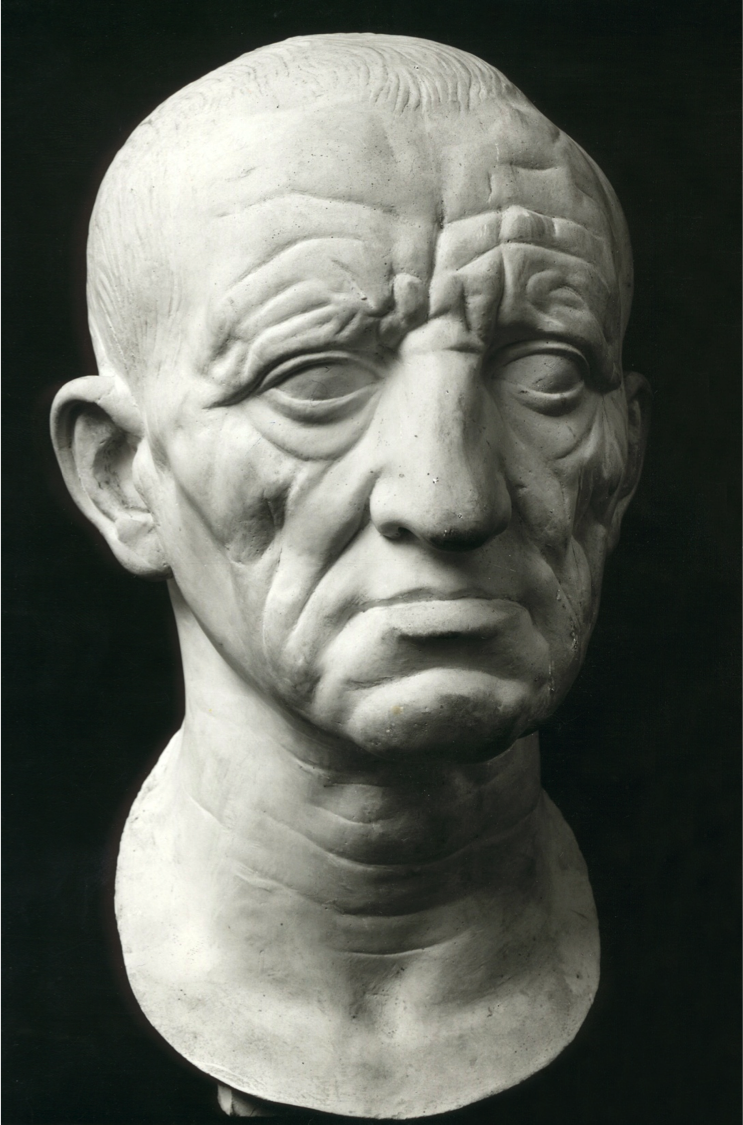
Head of a Roman Patrician- Republican Roman. 75-50 BCE. Marble
Form
Deep
Heavy lines
Stoic
Forward
NO Dynamism
NO Emotion
Content
Unknown Roman Patrician
Strong cheekbones
Hooked nose
Deep wrinkles
Furrowed brow
Sagging/sunken
Context
Gravitas
Seriousness of the mind
Virtus
Virtue of holding a public career
Wearing marks of his endeavors in life
Verism
Respect for family, tradition, and ancestry
Hyperrealism of naturally occurring features to absurdity
Charicature
Function
Death mask of important ancestor
Used in wealthy families to act in death parades
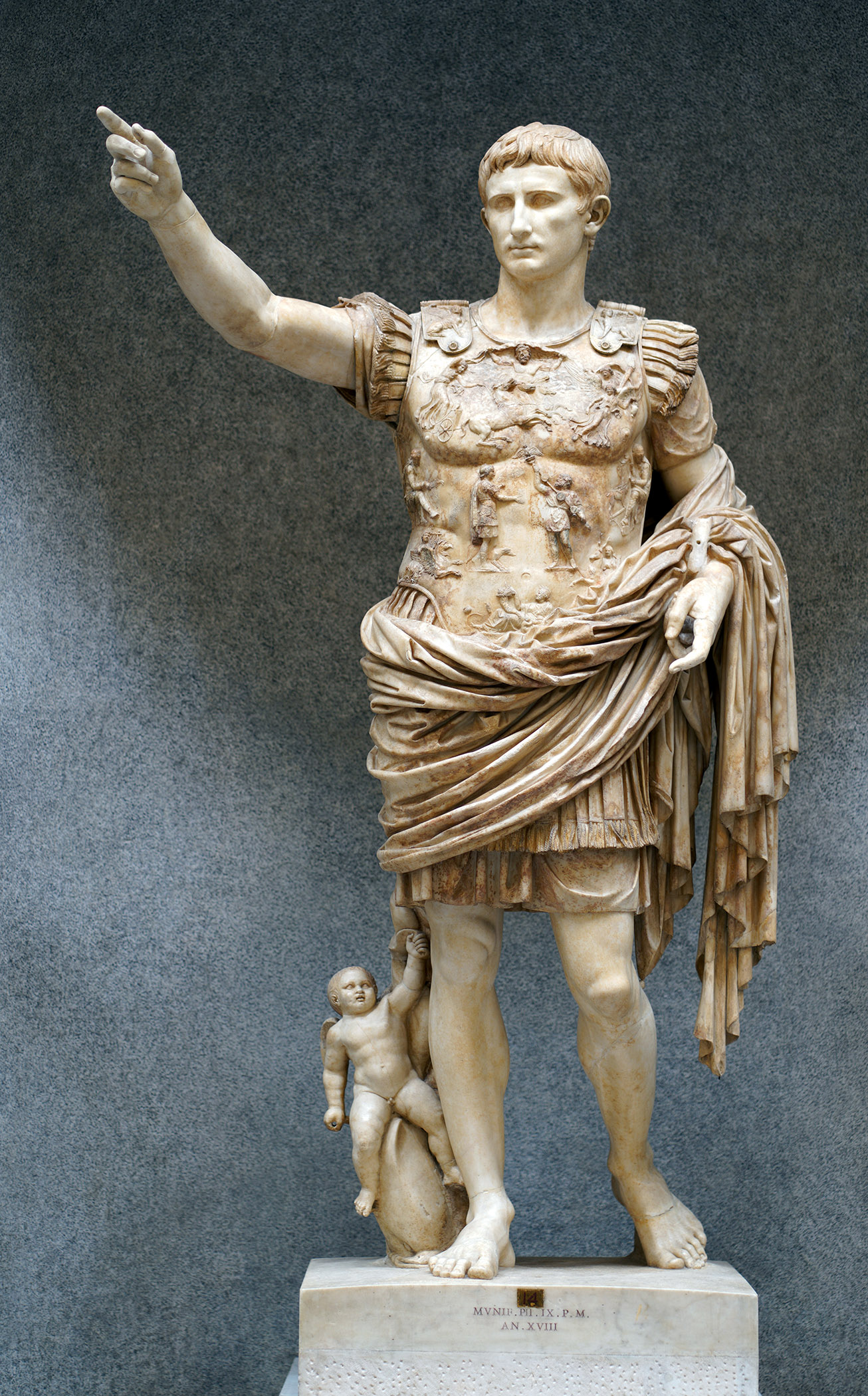
Augustus of Prima Porta- Imperial Roman. Early First Century. Marble
Form
Naturalistic
Idealized
Contrapposto
Content
Augustus
Celebrating victory over the parthians
Speaking to the troops
Cupid on dolphin
Breastplate shows success stories
Captives
Rome
Apollo
Context
Augustus- First emperor of Rome
Augustus believed he was related to Venus through Aeneas
Descendant of the gods
Function
To represent a new era for Rome
To represent the power of ROme
Rome as inheritors for Greek power and success
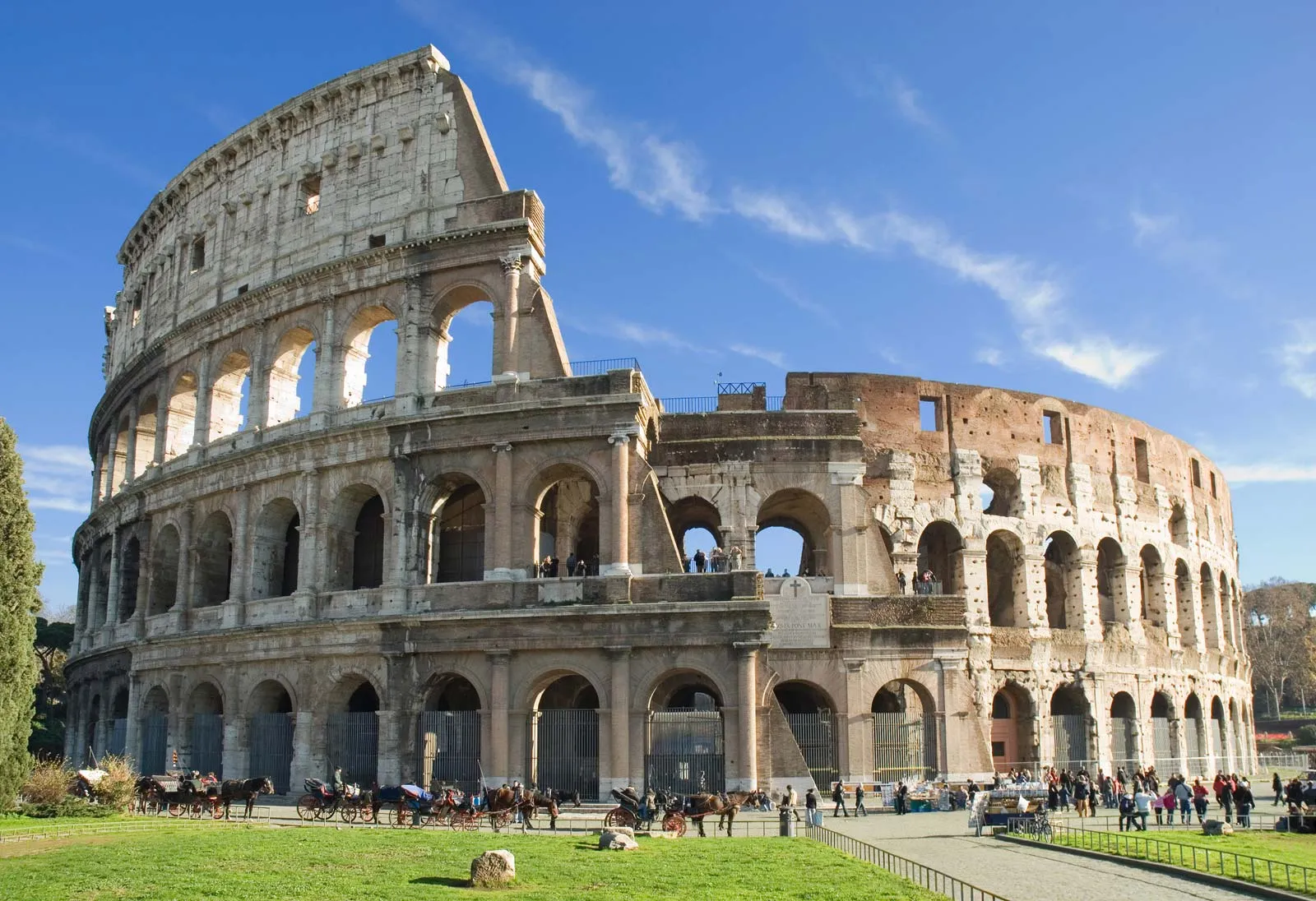
Colosseum (Flavian Ampitheater)- Rome, Italy. Imperial Roman. 70-80 Ce. Stone and Concrete
Content
Ampitheatre
Artificial lake
Context
Public
Flavian ampitheater
Colossal statue of sun god outside
100ft tall
Ticket numberings
Corinthian, Ionic, and Doric Columns
Function
Place for Nero to give to the public

Forum of Trajan, Apollodorus of Damascus, Column of Trajan- Rome, Italy. Apollodorus of Damascus. Forum and Markets, 106-112CE. Colum completed 113CE. Brick and Concrete, Marble
Form
Elegant
Elaborate
Content
Markets of Trajan
Commercial complex
Cashiers of the treasury
Imperial officials
Shops
Temple for deified Traja
Basilica Ulpia
Civic and judicial
Two libraries
Area fori (main square)
Trees
Statues (Trajan riding)
Gilded statues
Equus Traiani (Trajan as horse)
Context
Architect was asked to move an entire hill to make room
Marcus Ulpius Traianus- Trajan
Italian/Hispanic
“Good emperor”
Chosen from the job not by blood (meritocracy)
Period of stability
Apollodorus of Damascus (architect)
Military engineer
Accompanied Trajan on his campains
Crowning achievement
Contrast from tight surrounding streets
Function
To display the wealth Trajan brought to Rome from his military strength
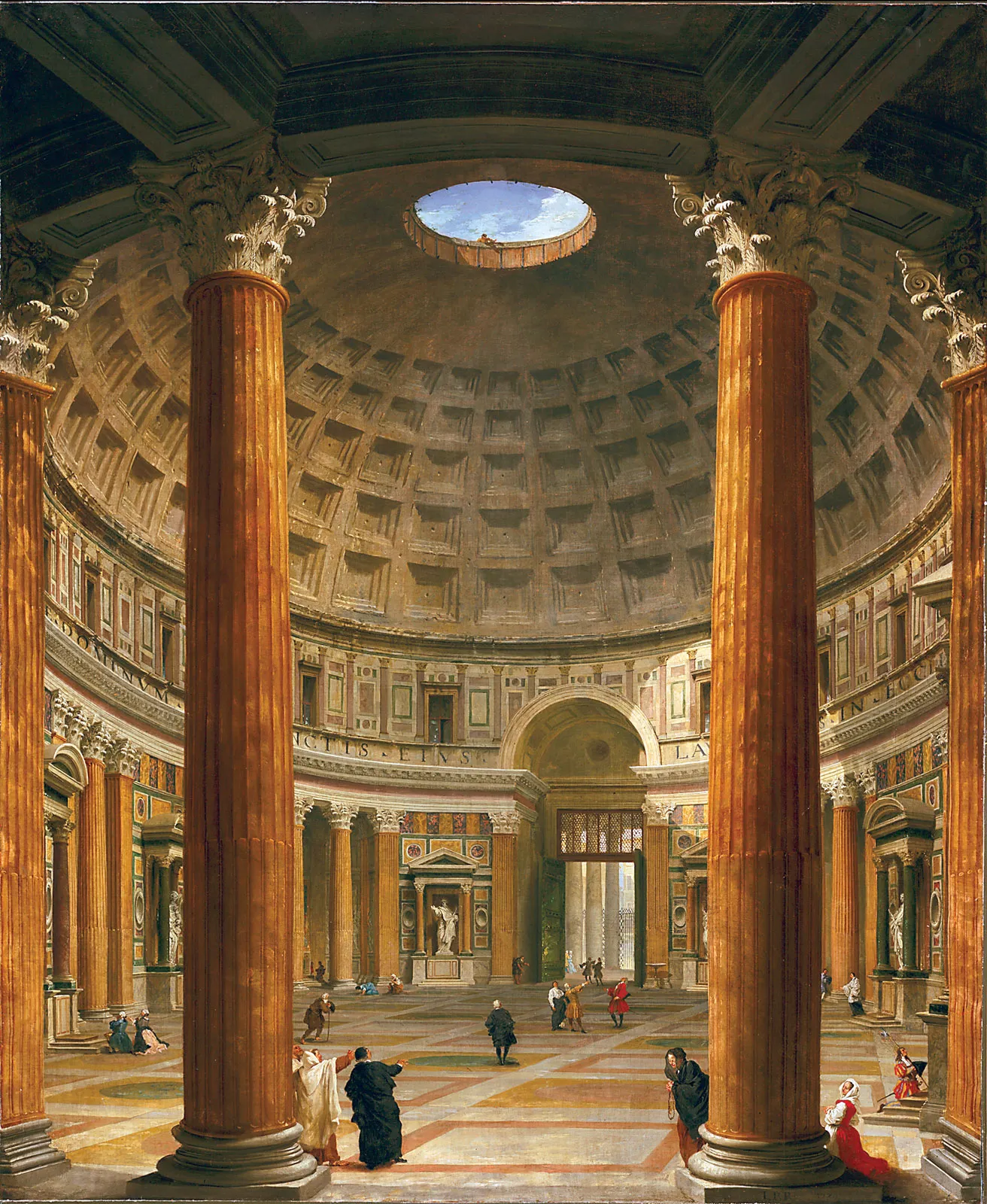
Pantheon- Imperial Roman, 118-125 CE. Concrete with stone facing
Form
Dynamic
Content
Surrounded by colonnade
Corinthian capitals
Radial design
Columns
Alligned with frieze
Statues of teh gods
Colored marble
Oculus
Context
Imported marble
Increase in elevation
Accommodates a perf. sphere due to radial points
“Ideal geometry”
Kings of concrete
Function
Divin space
Monument of heavens
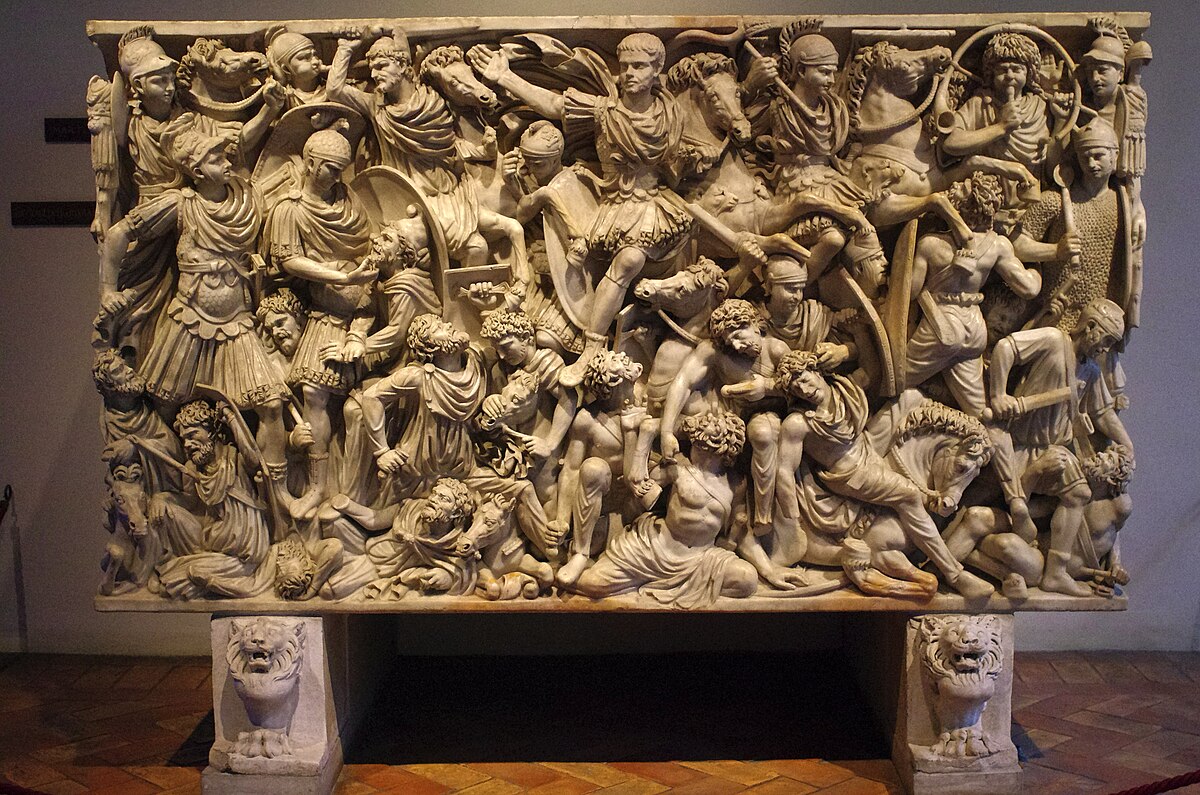
Ludovisi Battle Sarcophagus- Late Imperial Roman. 250 CE. Marble
Form
High Relief
Dynamic
Dense
Hierarchy of scale
Shadow play
Texture
Content
Romans vs. Barbarians(goths)
Idealized vs. Ugly
Context
Cremation THEN Burial
Funciton
Tomb for wealthy person

Catacomb of Priscilla- Rome, Italy. Late Antique Europe. 200-400 CE. Excavated tufa and fresco.
Form
Rough
Content
75 miles
Labirynth
Graves stacked
Hallways stacked
Cubiculum
Loculi
Shelves
Symbols
Inscriptions
Orant fresco
Veiled woman
Married
Orant=prayer
Shadows
Greek Chapel
Not a chapel
Wall painting mimicking marble
Small
Sarcophagi
Christ’s miracles
Context
Christian martyrs buried
Earliest christian art/ iconography
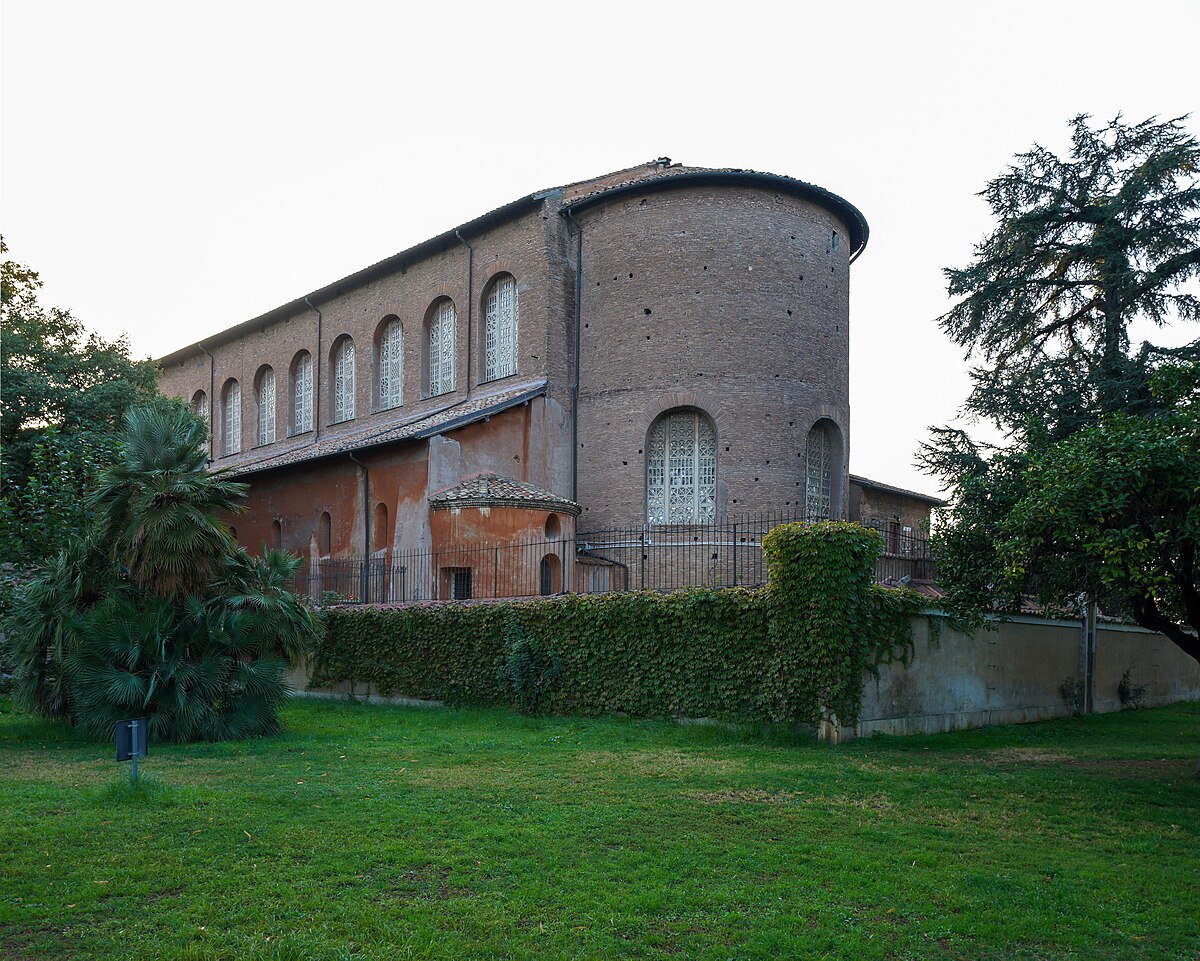
Santa Sabina- Rome, Italy. Late Antique Europe. 422-432 CE. Brick and stone, wooden roof.
Form
Spacious
Simple
Content
Flat ceiling
Clerestory
Ancient Roman style
Longitudinal axis
Arches
Spolia
Carved wooden door
Old and New Testament
1st crucification depiction
Tiled inlaid stone arches
Eucharist
Context
Few years after Christianity was legalized
Across from Roman temples
Function
Basilica
To display new authority of Christianity
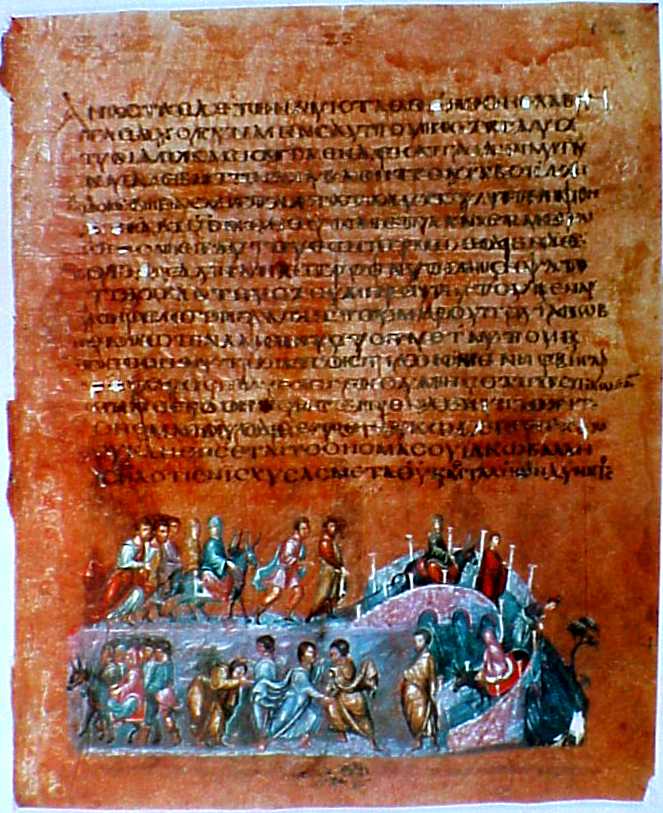
Rebecca and Eliezer at the Wall and Jacob Wrestling the Angel, from the Vienna Genesis- Early Byzantine Europe. Early sixth century CE. Illuminated manuscript. Tempera, gold, and silver on purple valium
Form
Text and Art
Classical elements (architecture)
Shading (Spatial awareness)
Simplified
Content
Rebecca and Eliezer at the Well
Jacob Wrestling the Angel
Context
Ancient/Medieval
Books as luxury
Abraham sent a man to get his son a wife- then prayed that the wife would show up to help with camels, and then lady shows up
Rivers and water as people
Function
Greek copy of Book of Genesis

San Vitale- Ravenna, Italy. Early Byzantine Europe. 5260 547 CE. Brick, marble, and stone veneer, mosaic.
Form
Disproportionate figures
Dynamic
Content
Central plan
Ambulatory
Octagon
Lots of windows
Double columns
Piers
Mosaic
Paradise
Life!
Apostles
Christ sitting on earth
Handing church and crown to proprietors of the church
Justinian and Theodora
Power
Church, emperor and sholdiers
Women as co-equal.
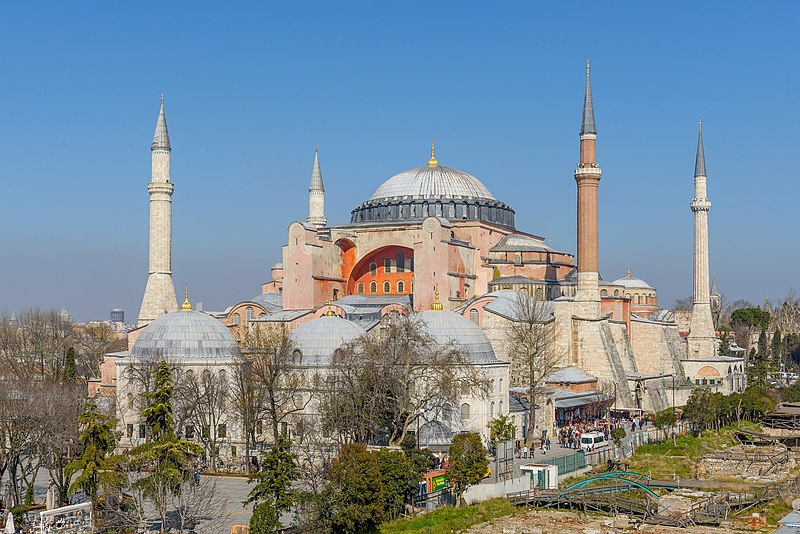
Hagia Sophia- Constantinope (Istanbul). Anthemius of Tralles and Isidorus of Miletus. 532-537 CE. Brick and ceramic elements with sotne of mosaic veneer
Form
Central plan space
Dynamic
Content
Dome on square barrel
Pendentive arches
Half domes
Clerestories
40 windows in the dome
Marble
No figural imagery
Islamic inscription
Context
Scholars and Geometrists (Architects)
Emperor Justinian
Byzantium- Constantinople- Istanbul
Close to emperors castle
Light=divine
Church and emperor separate but collaborating
Imported marble
Mosque during Ottoman Empire
Function
Expressing emperors power
New Christian architecture
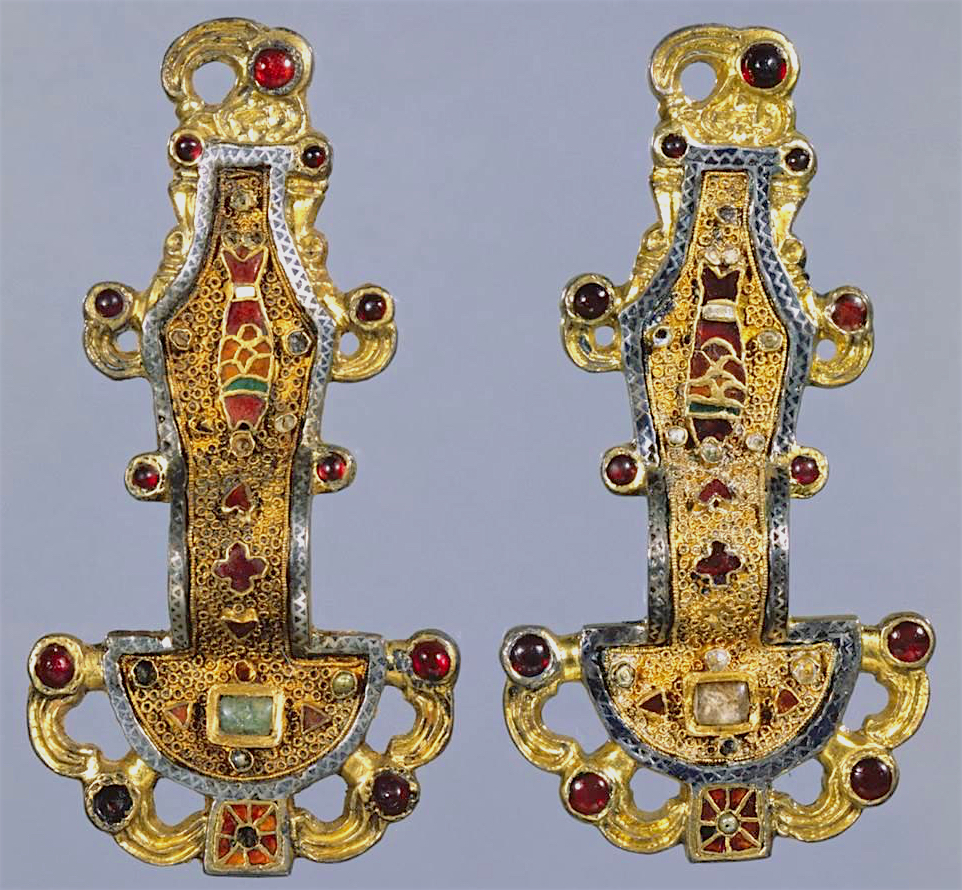
Merovingian Looped Fibulae- Early Midieval Europe. Mid-sixth century CE. Silver gilt worked in with filigree, with inlays of garnets and other stones.
Form
Ornate
Content
Brooches
Radiate-headed
In-laid stones
Eagle
Fish
Context
Found in barbarian grave sites (non-Roman)
Though to be of Germanic origin
Eagle= symbol of Roman empire
Function
To hold capes/cloaks in place
Badges of power
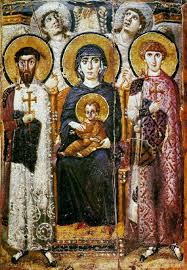
Virgin (Theotokos) and Child Between Saints Theodore and George- Early Byzantine Europe. Sixth or early seventh century CE. Encaustic on wood
Form
Classical faces
Spatially compressed
Hierarchy of bodes
Upward&Inward
Content
Virgin (Theotokos) and child between Saints Theodore & George
Halos
Differing gazes
Function
Tying heaven to our plane

Lindisfarne Gospels: St. Matthew, cross-carpet page; St. Luke portrait page; St. Luke incipit page. Early medieval (Hiberno Saxon) Europe 700 CE Illuminated manuscript. Ink, pigments, and gold on vellum
Form
Abstract
Naturalistic
Content
Manuscript
Cross
Animals
Context
Center of exchange
Reminiscent of gold/metal work
Mediteranean
Written by the Sts.
Artistic flatness to mimic metalwork
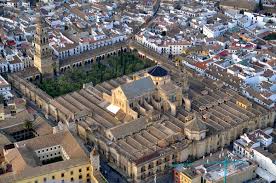
Great Mosque at Córdoba- Córdoba, Spain. Umayyad. Begun 785-786 CE. Stone masonry
Content
Orange trees in courtyard
Hypostyle prayer hall
Fountain
Minaret
Mihrab
Gold Tessarae
Horseshoe arch
Dome
Context
Oldest structure of Al-Andalus
Abd al-Rahman I
Escaped Southern Spain & aimed to recreate Demascus
Sponsored building programs and agriculture
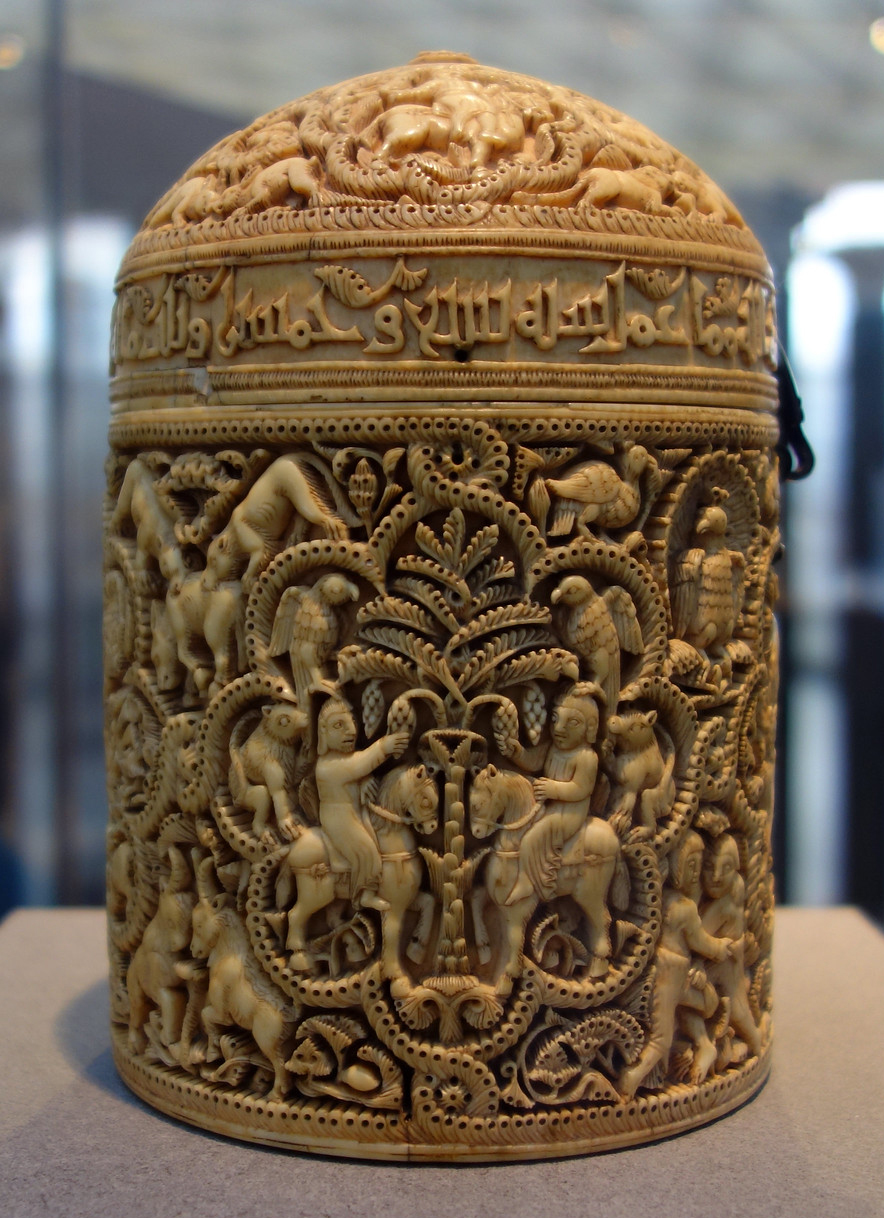
Pyxis of al-Mughira- Umayyad. 968 CE. Ivory
Form
High-relief
Content
Falconers, wrestlers, griffons, peacocks, birds, goats
Royal iconography
inlaid jade
Context
Domestic
Gift to al-Mughira, son of a caliph
Royal ivory carving
Royal workshops
Ivory
Durable, smooth, elegant, easily carved
Function
Cosmetic
Holding perfume containers
Solidifying Umayyad legitimacy
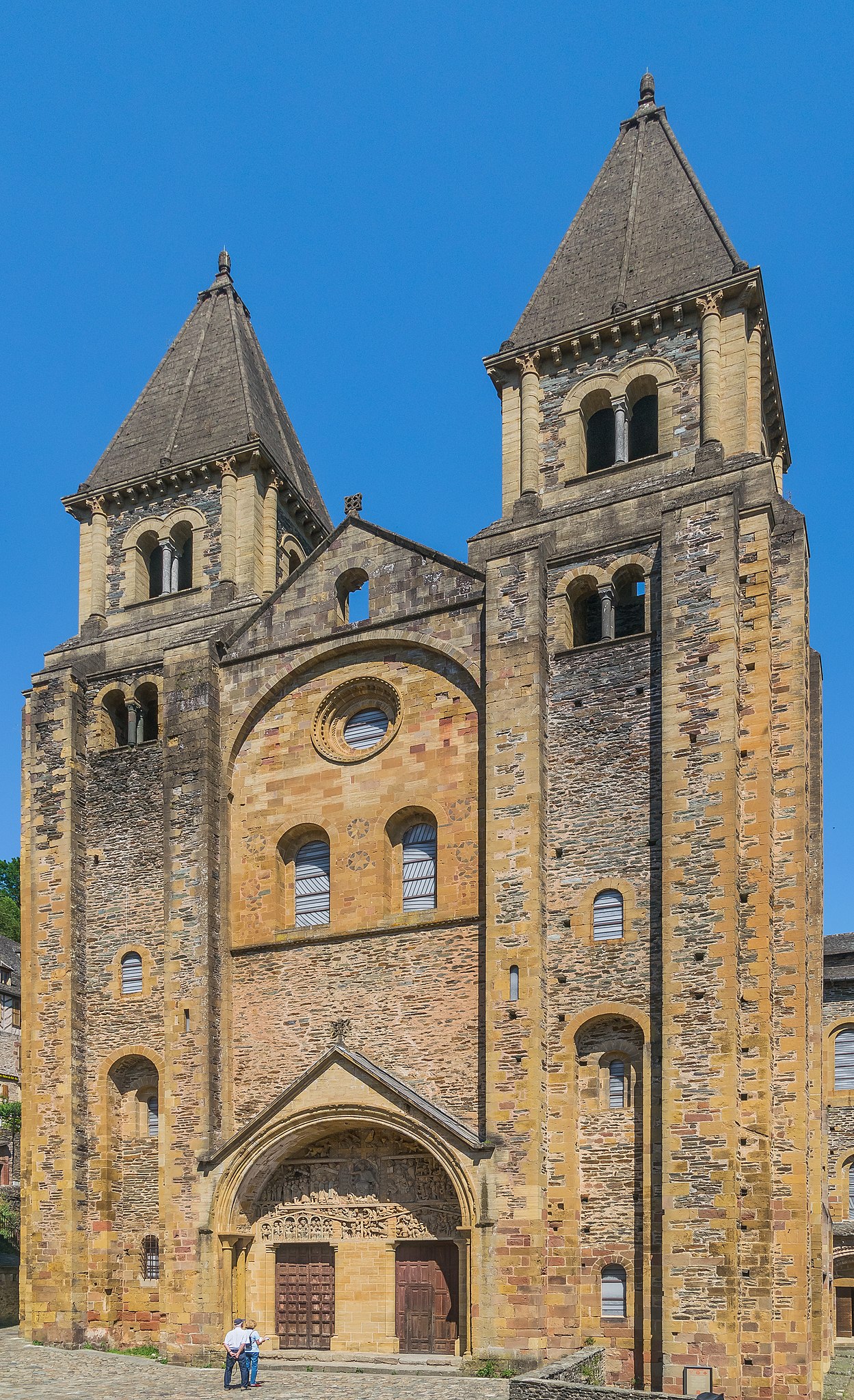
Church of Saint-Foy- Conques, France. Romanesque Europe. Church 1050-1130CE. Reliquary Ninth century CE. Stone; sotone and paint; gold, silver, gemstones, and enamel over wood (reliquary)
Form
Romanesque
Content
Abbey
Monastery
Barrel vaulted nave
Cruciform plan
Last judgement in relief
Christ= central
Angel opening tombs for judgment
Hell- devil as judge
Reliquary
Holding remains of a saint or holy person (Saint Foy)
Context
Cruciform plan
Crowd control
Place to receive blessings
Rituals of medieval faith
Function
Pilgrimage spot

Bayeux Tapestry- Romanesque Europe 1066-1080, embroidery on linen
Form
Embroidered
Colorful
Narrative
Dynamic
Minimal illusion of space
Decorative
Content
Struggle for the throne of England
William (Duke of Normandy) and Harold (Earl of Sussex)
William conquered
Aesop’s fables
Context
Chronicle
Patron- Odo (Half-brother of William)
Anglo saxon embroiderers
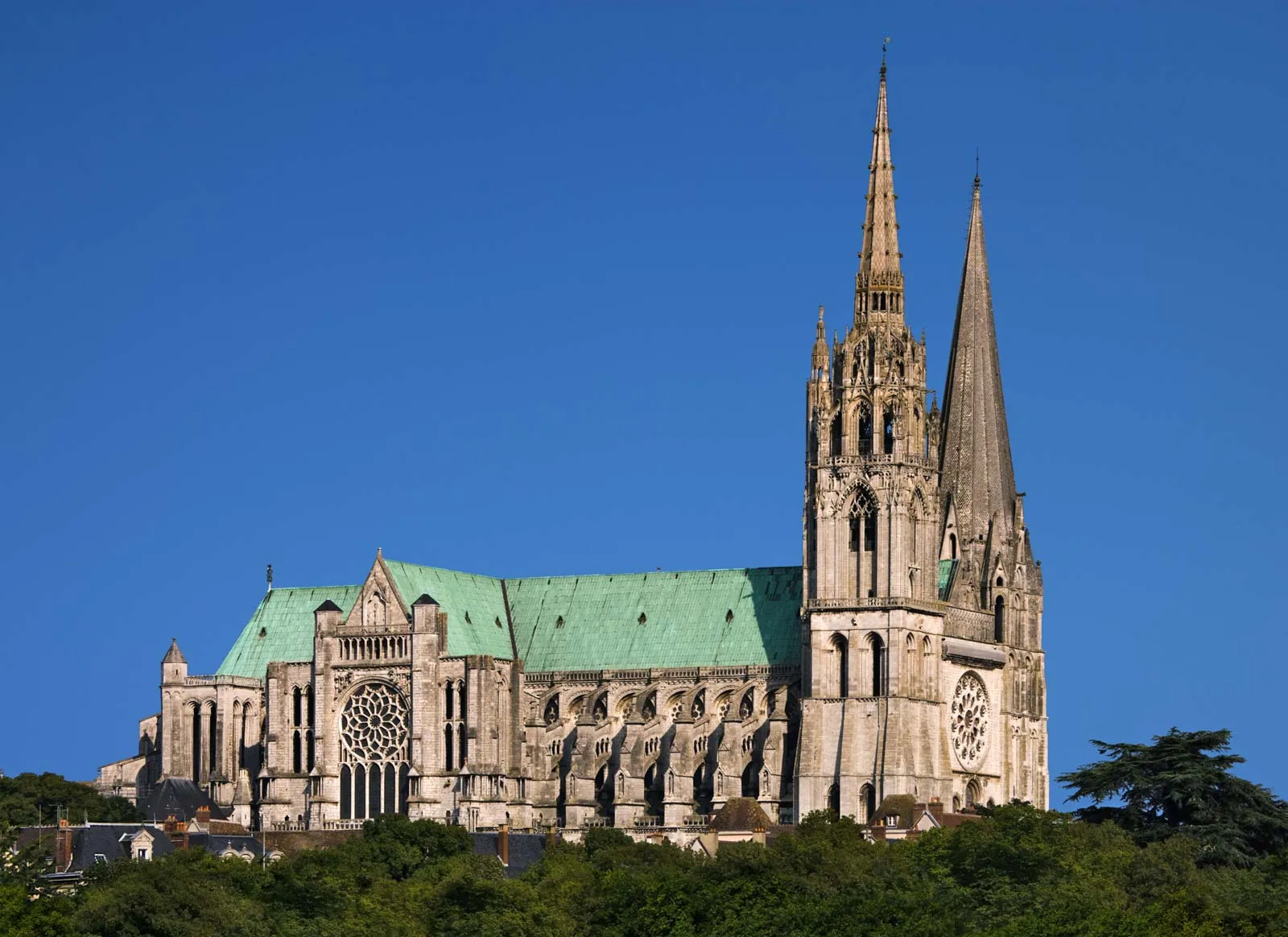
Chartres Cathedral- Chartres, Europe. Gothic Europe 1145-1220 CE. Limestone, stained glass
Form
(Early) gothic
Romanesque
Modest
Content
School
Palace for bishop
Hospital
University (liberal arts)
Arches
Vaulting and piers
Jamb figures
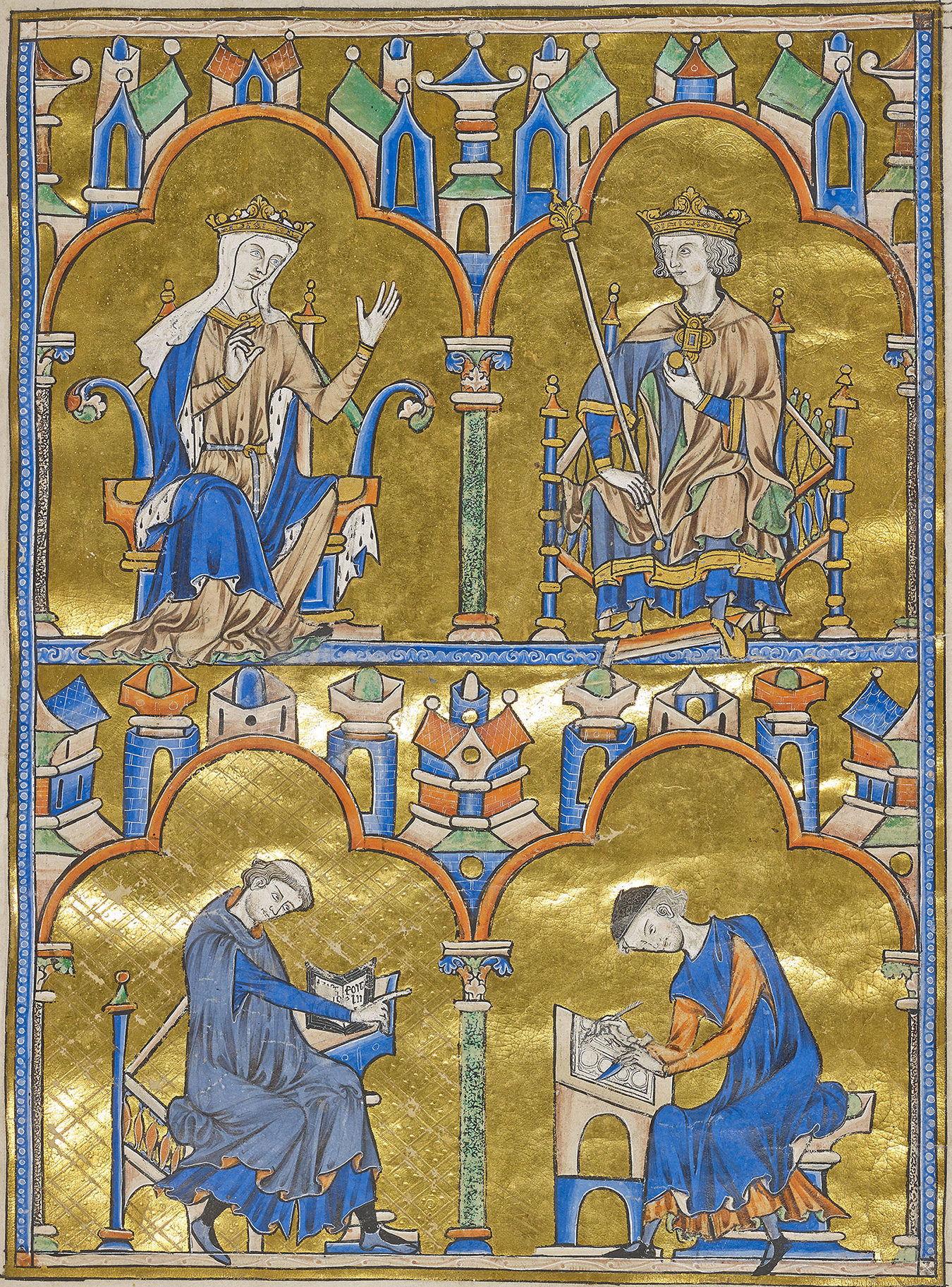
Dedication Page with Blanche of Castile and King Louis IX of France, Scenes from the Apocalypse from Bibles moralisé- Gothic Europe 1225-1245, Illuminated manuscript (ink, tempera, and gold leaf on vellum)
Form
Bright
Registers
Frontal
Minor illusion of space
Content
Blanche of Castile & San Louis
Cleric and scribe
Burnished gold and trefoil arch
Stylized & colorful buildings
Columns
Context
Blanch of Castile
Widowed and became queen
Troops rallied against her
Louis IX took power after
Made for the French royal house
Similar to depictions of Virgin Mary& Christ enthroned as celestial rulers
Function
Bible passages with moral stories for French royals
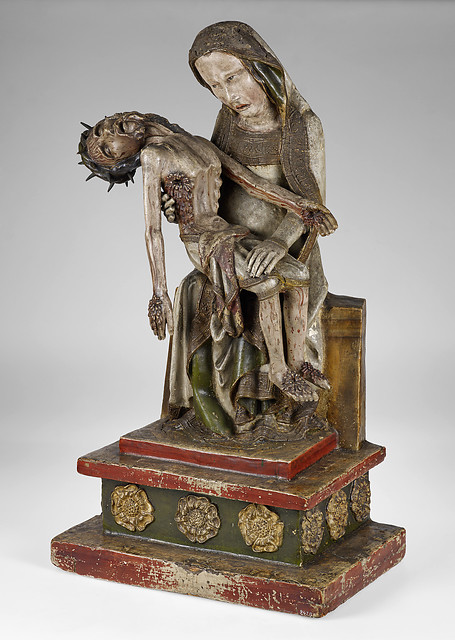
Röttgen Pieta- Late Medieval Europe, 1300-1325, Painted Wood
Form
Late Gothic
Mysticism
Stark
Gruesome
Sharp
Specific focus
Colored
Statue
Content
Mary holding dead Christ
Lamentation
Mary as sad and human
rather than all knowing
Context
Use of humanity to express empathy and connect our plane to theirs
On an altar (church)
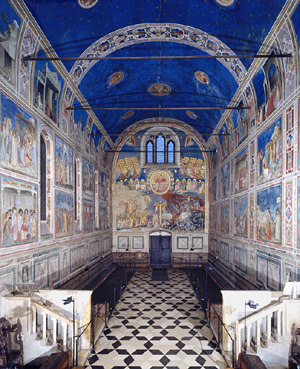
Arena (Scrovegni) Chapel, including Lamentation- Padua, Italy. Uknown architect; Giotto di Bondone (artist). Chapel 1303 CE; Fresco 1305 CE. Brick and Fresco
Form
Small
Private
Enclosing
Naturalistic
Content
Covered in paintings
BLUE!
3 registers
Continuous story of Christ
Christ on a panel (BIG)
Earthly settings for mary and angel
Virtues and vices
Elect above the ground
Context
Attached to castle
Next to remnants of ancient Roman arena
Enrico Scrovegni was a banker and charged interest
Hell
Function
Enrico Scrovegni’s atonement
Exit as last reminder for visitors to follow Christ

Golden Haggadah (Plagues of Egypt, Scenes of Liberation, and Preparation for Passover)- Late Medieval Spain. 1320. Illuminated Manuscript, pigments and gold leaf of vellum
Form
Lustrous
Practical and fine art
Gothic
Content
Prayers and readings for during teh seder
architectural details
long-flowing bodies
Jewish x Gothic art
Context
Passover
When Moses led the Jews out of Slavery
“Haggadah”
Narration
Function
Book to tell the story of passover
Symbol of wealth
Pictorial aid for stories
Alhambra- Granada, Spain. Nasrid Dynasty. 1354-1391. Whitewashed adobe stucco, wood, tile, paint and gilding
Form
Medieval
Organized
Complex
Connection to natural world
Content
City within a city
Connecting paths and gates
Plain exterior
Lattice windows
El Mexuar
Audience chamber
Geometric tile
Carved stucco panels
Comares palace
Raised
Outdoor stage
Palace of the Lions
Fountain w/complex hydraulics
Columns
Sala de los Reyes
Ceiling paintings
Gardens
Context
Heavily fortified
Function
Residence for ruler and close family
Barracks for elite guard
City where court officials lived and worked
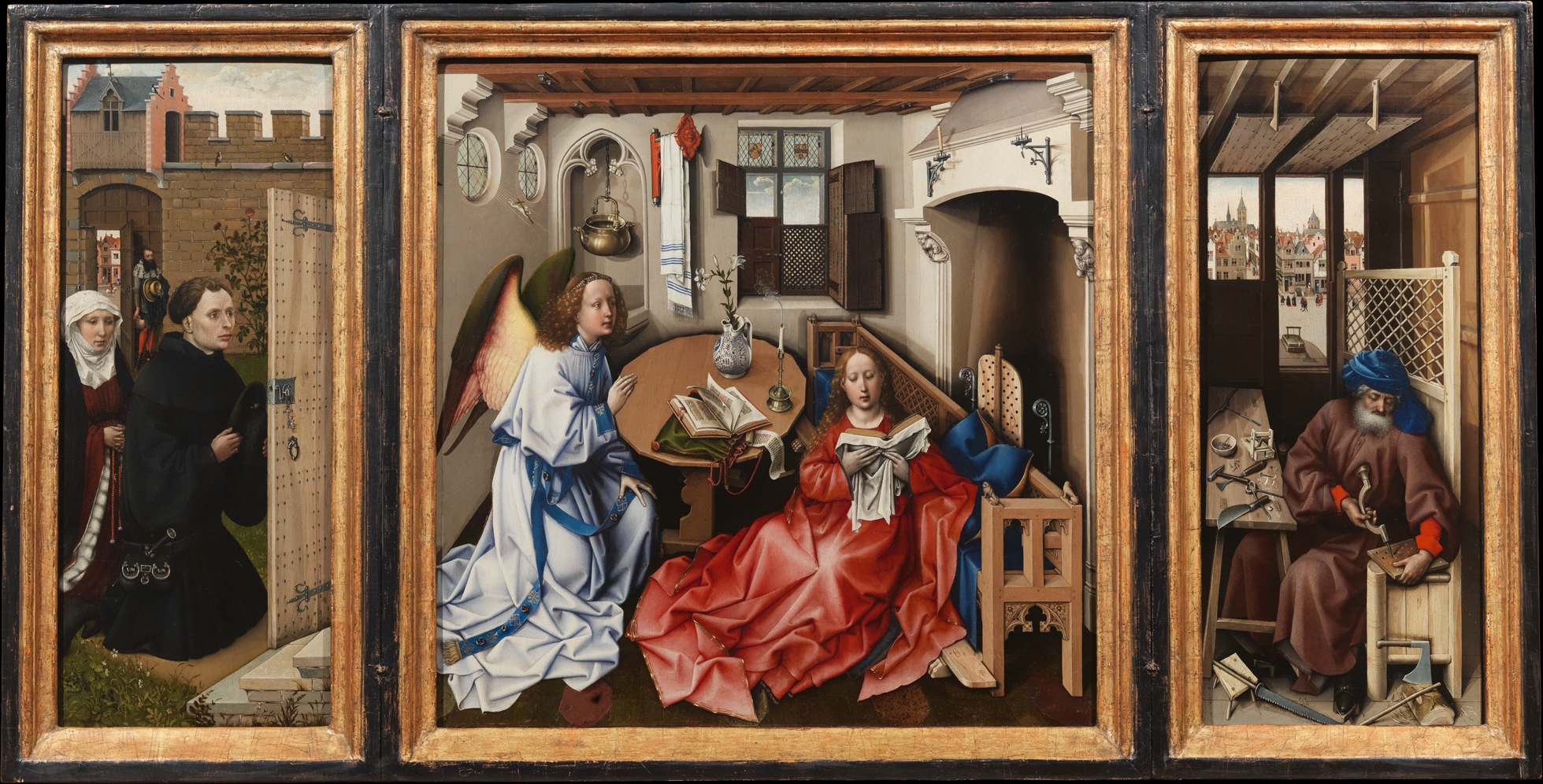
Annunciation Triptych (Merode Altarpiece)- Workshop of Robert Campin. 1427-1432 CE. Oil on wood
Form
Portable
Light
Texture
Internal focus
Demanding of time and focus
Content
Central scene
Living room
Gabriel and Mary
Annunciation
Sharp folds
Pot (Her purity)
Small figure gliding w/ cross
Left scene
Donors (Patrons) (comissioners)
Gatekeeper
Kneeling
Walled garden (Virginity)
Flemish city outdoors
Right scene
Joseph
Creating (tools)
Mouse traps
Holes (holes in Christ)
Ref. to creation of work (Meta)
Merchant city (Mercantile cutlure)
Context
Workshop of Campin
Successful painter w/ apprentices & assistance
Paintings as aids in prayer
Trade-oriented culture
Made to be sold
North Renaissance
Extra detail!
Naturalism/realism
Seen repeatedly
Development of linear perspective
Labor intensive/ detail intensive
Pazzi Chapel. Basilica di Santa Croce. Florence, Italy. Filippo Brunelleschi. 1429-1461CE. Masonry.
Form
Humanist
Geometric
Mathematical
Simple
Upward emphasis
Content
Cloister (enclosed garden)
Stained glass
Hemispherical dome
12 ribs
Oculus
Barrel vaults
Corinthian columns
Pietra Serena
Gray Limestone
Friezes
Roundels
Pazzi Coat of ARMS
Context
Loggia
Commissioned by the Pazzi fam
Medici Rivals
Function
Chapter house for Monks
Funerary space
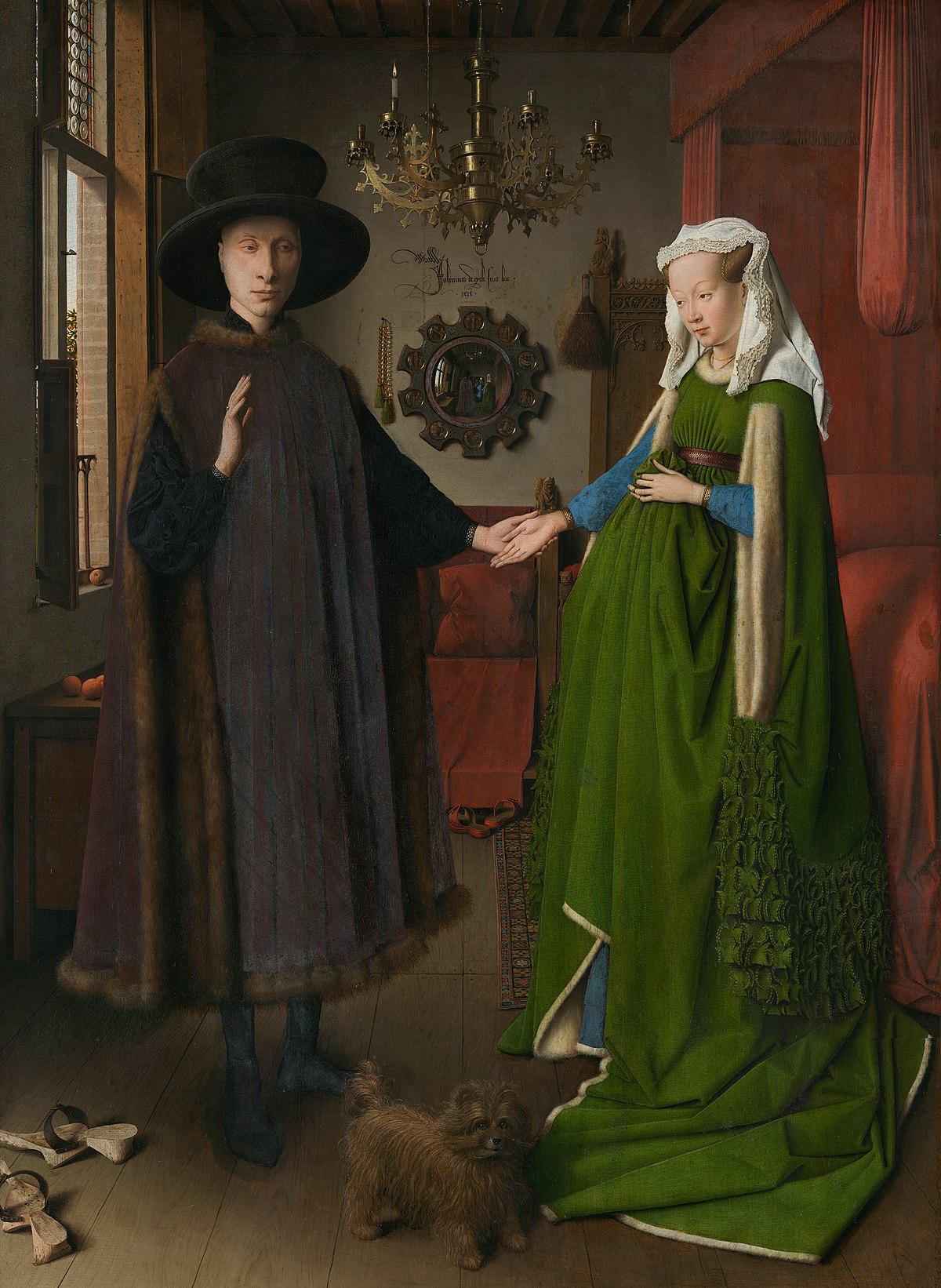
Arnolfini Portrait- Jan van Eyck. 1434CE. Oil on Wood
Form
Delicate
Elongated
Crammed
Content
Joint hands
Shoes off
Single candle (presence of God)
Two visitors (witnessing)
Roundels around the mirror
Scenes from story of Christ
Dogs (fidelity/loyalty)
Fruit on window
Elaborate carpet
Robes
Context
Wealthy merchant fam (Bruges)
Northern Renaissance
Thin layers of oil paint
Function
Memorial portrait
Wedding
Men giving authority to women
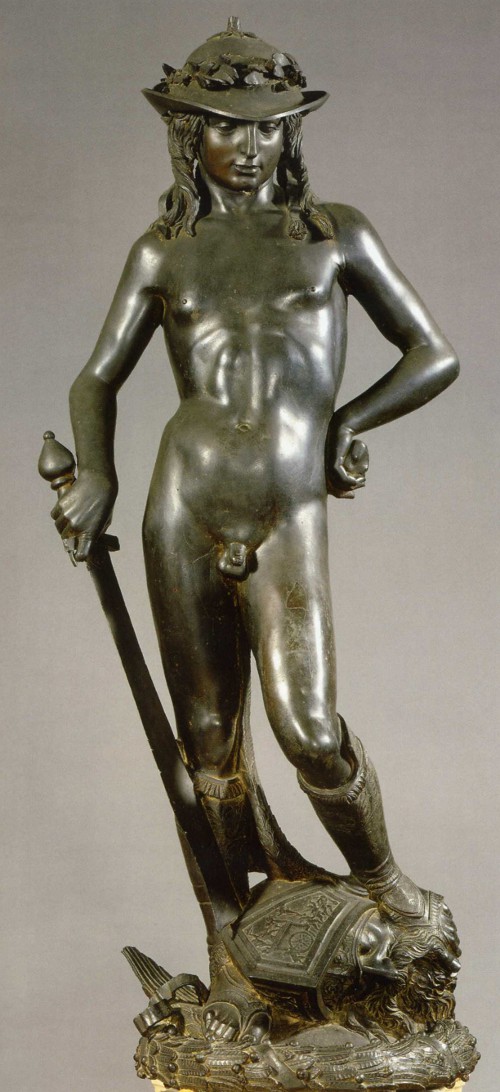
David- Donatello. 1440-1460CE. Bronze
Form
Contrapposto
Relaxed
Moving
Autonomous
Lost-wax casting
Content
Hollow
Young
Sensual
Looking down
Boots &Hat (soft)
Severed head of Goliath
Rock in hand
Oppositional stance
Context
First freestanding figure since antiquity
Florence vs. Milan
David as symbol for Florence and Republic
Symbol stolen by Medici
Christians had focused on soul rather than body
Body= corruption
Return to ancient Greek and Roman love for the bodyf
Medici garden
Central

Palazzo Rucellai- Florence, Italy. Leon Batista Alberti. 1450CE. Stone, masonry.
Form
Roman architecture
Harmony
Delicate
Low-relief
Horizontal
Content
Pilasters
Rounded arches
Entablature w/ frieze
Medici and Rucellai symbosl
Benches
3 diff capitals
Tuscan, ionic, corinthian
Context
Rucellai
Similar to Medici fam
Wood manufacturers
Unfinished
Function
Expression of loyalty to Medici fam
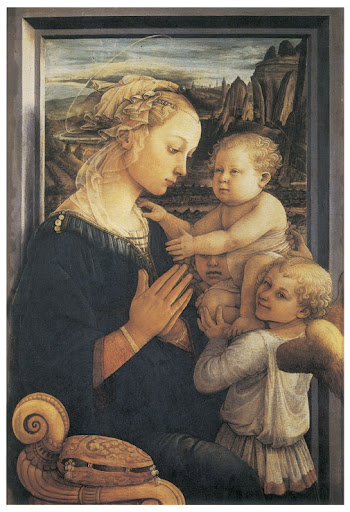
Madonna and Child with Two Angels- Fra Filippo Lippi. 1465CE. Tempera on wood.
Form
Playful
Humanist
Somber
Decorative
Content
Foreknowledge of fate of Christ
Pathos
Very common looking
Angel
Halo very subtle
Frame of window= frame of painting
Landscape
Depth
Translucent fabric
Curly shapes
Sensual
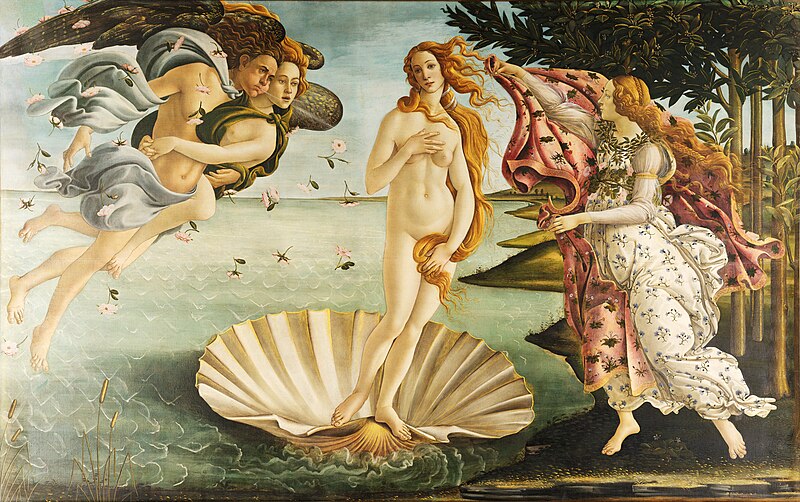
Birth of Venus- Sandro Botticelli. 1484-1486CE. Tempera on canvas.
Form
Soft
Colorful
Dynamic vs. Still
Life size
Flat/2D vs. Depth in body
Content
Venus central
Covering her body modestly
Zephr (wind) and chloris
Attendant heading to wrap her
Patterning of flowers
Weightless figures
Seashell
Gold lines throughout
Erotic
Context
First instance of female nude
Non-biblical
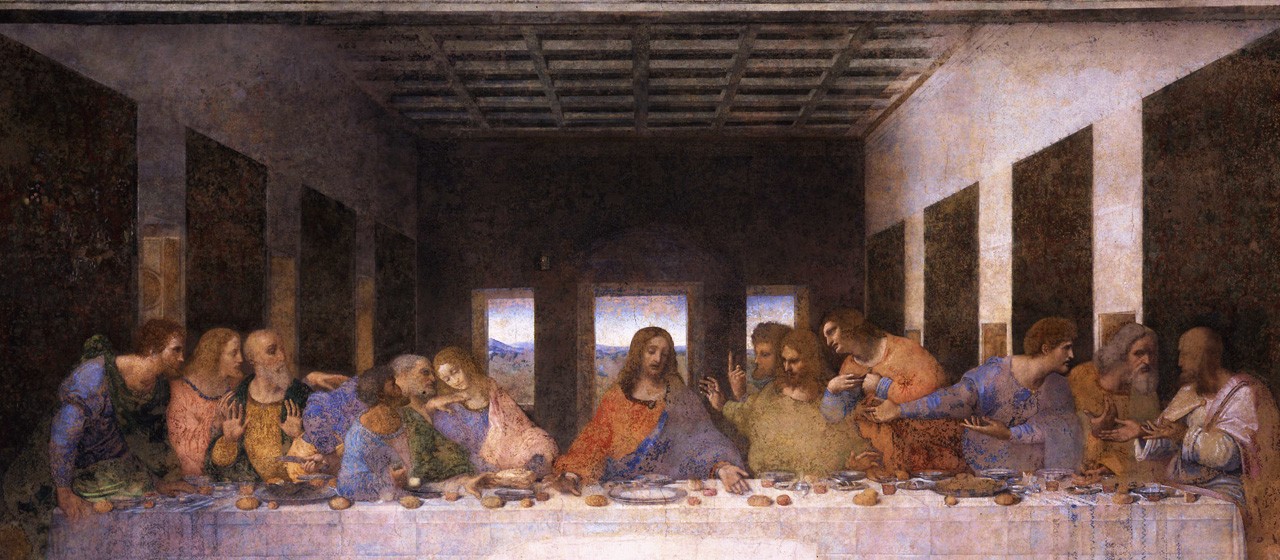
Last Supper- Leonardo da Vinci. 1494-1498CE. Oil and tempera.
Form
Crowded
Chaotic
Content
Reactions from betrayal
Christ reaching for wine and bread
Christ and Judas both reaching for bowl
Judas holding hi sbribe
Christ central
Pathos of apostles
Demarcation between our realm and theirs
Table
4 groups of 3
Overlap
Context
Tempera on dry plaster
Judas w/ other apostles
Placed where monks would take their meals
Institution of the Eucharist
Integration of geometry
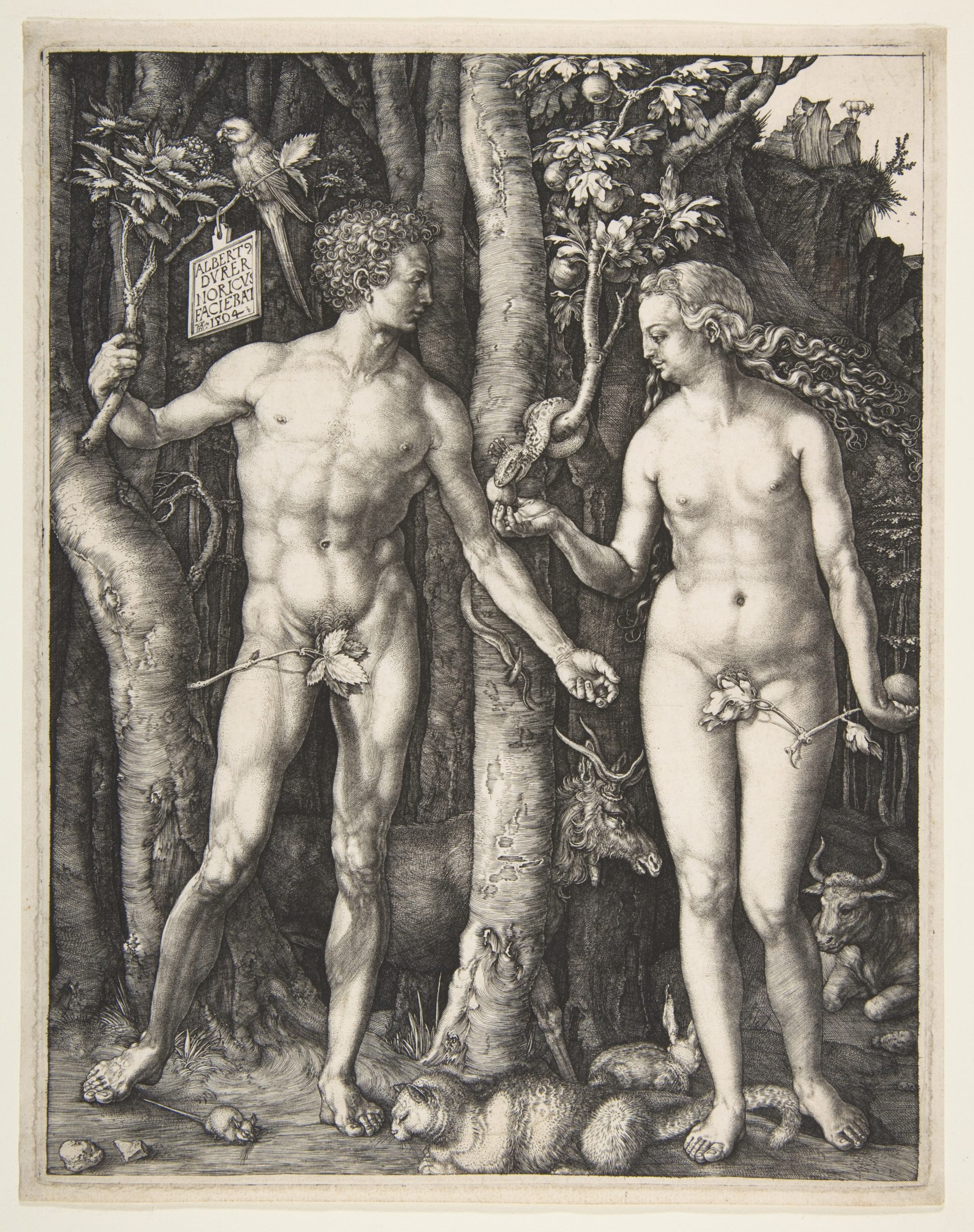
Adam and Eve- Albrecht Dürer. 1504CE. Engraving
Form
Contrast
Contrapposto
German
Frontal
Chiaroscuro
Natural
Artifical
Content
Adam/Eve
Dark,dense forest
On wood
Nude
Apple
From fig tree?
Parrot (tropical
Elk, OX, Cat, rabbit, mouse, goat
Sign
Latin
Moment of perfection and balance
Context
Grimm fairy tales
Contradictions
Classical proportion
Vitruvian
Parrots as collector items in Germany
Four Humours
Reproducible
Dürer- intellectual (scientific)
Function
Story of German Renaissance
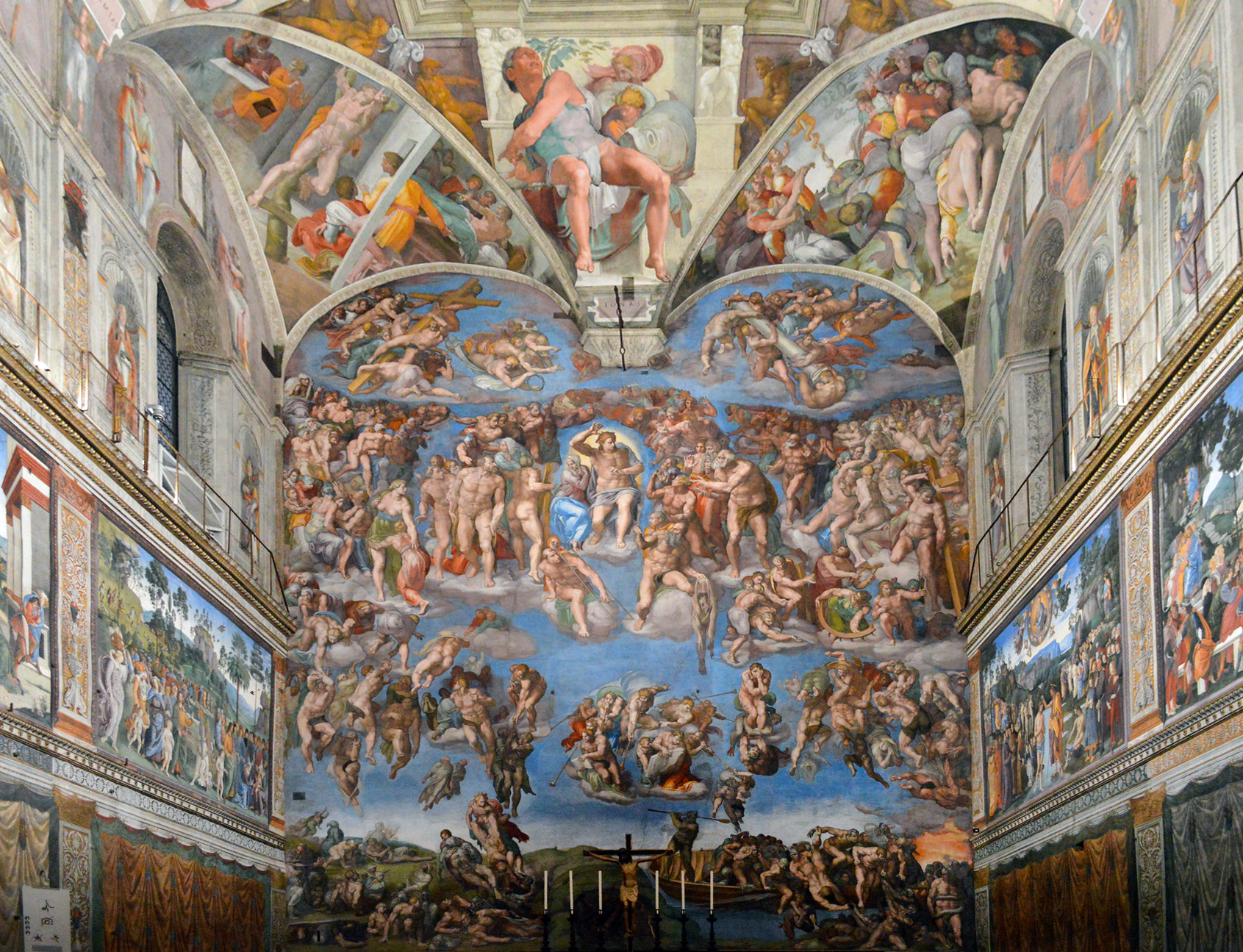
Sistine Chapel- Michelangelo. 1536-1541CE. Ceiling frescoes, altar wall
Form
Densely packed
Body emphasis
Dignity
Overbearing
Content
Christ smiting damned
Mary smiling at the blessed
Blessed being pulled by angel in ascent to heaven
Angels awakening the dead
Michelangelo as st. Batholomew
Saints (old testament figures)
Context
Altar wall
Where pope is decided
Body as symbol
Rather than Classical/renaissance proportions
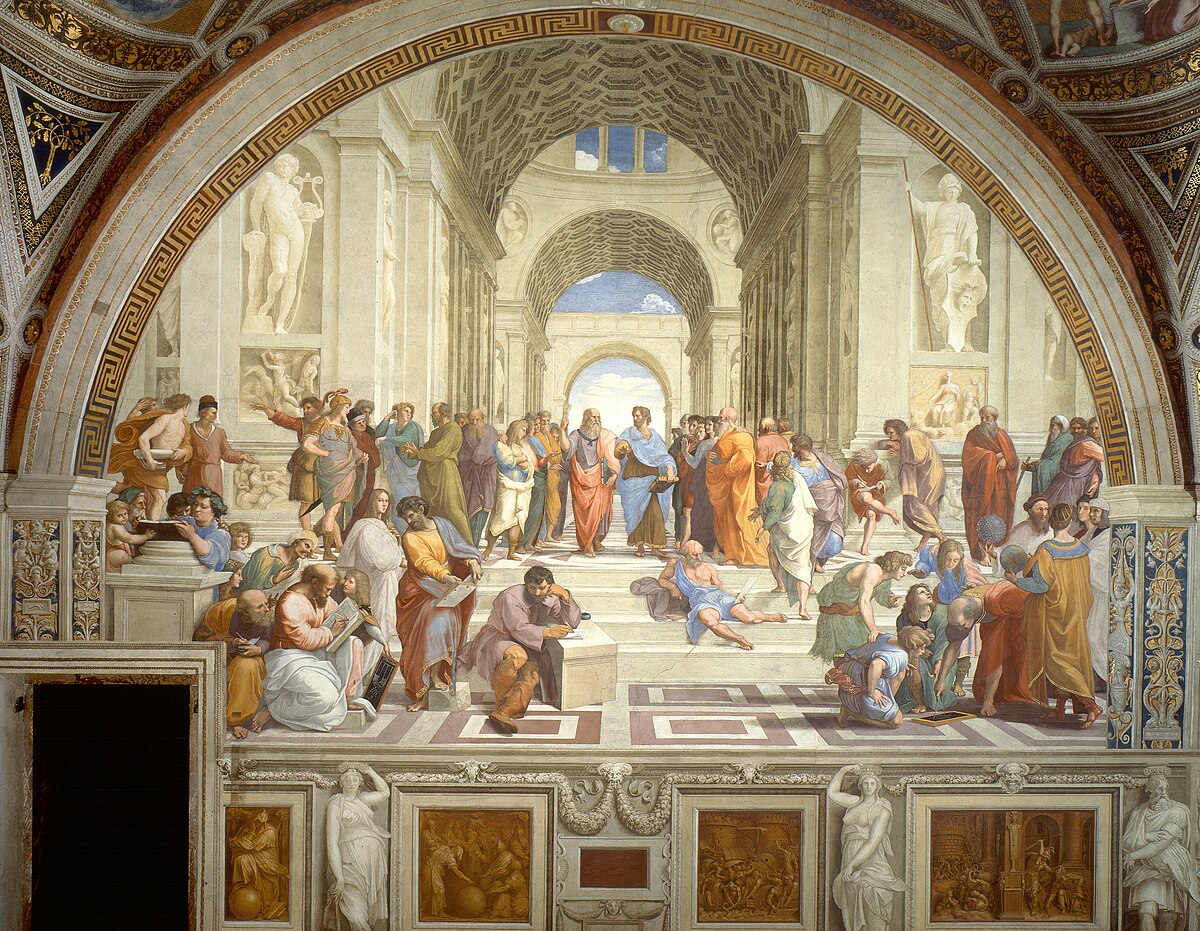
School of Athens- Raphael. 1509-1511 CE. Fresco.
Form
Overlapping
Classical
Intimate
Linear perspective
Roman architecture
Content
Pagan figures
Plato &Aristotle holding their own books
Contrasting colors
Hand up/down
Division of ideas
Ideal and theoretical vs. observed and practical
Pilasters
Barrel vaults
Statues
Apollo vs. athena
Grace in knowledge
Raphael as intellectual
Context
Within papal apartments
Four branches of knowledge
Philosphy, theology, poetry, juris prudence
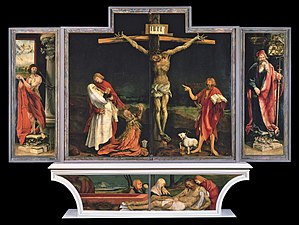
Isenheim Altarpiece- Matthias Grünewald 1512-1516 CE. Oil on wood
Form
Portable
Sculpted
Content
Statues
Christ (macabre &Distorted)
Virgin swooning into st. John E
St. John B
Semi-abstract
Hybrid-demons
St. Anthony’s temptations
Context
St. Anthony (patron) of skin disease
Function
Object of devotion
Miracle performing for patients
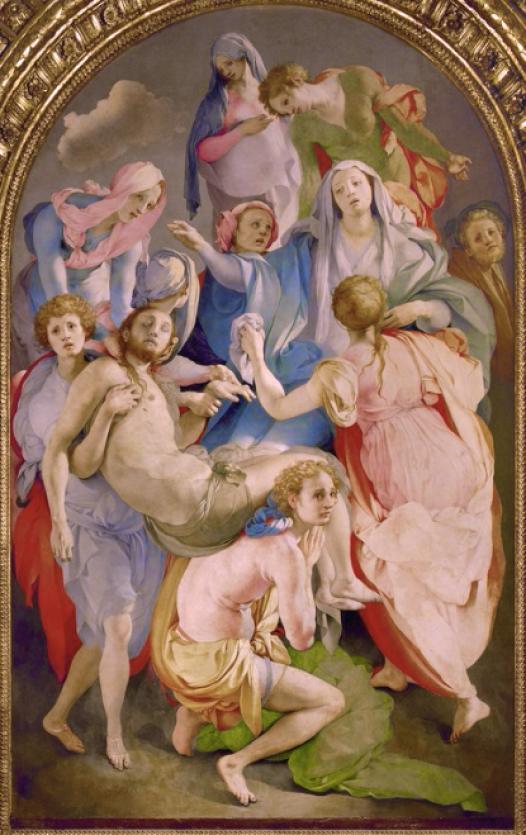
Entombment of Christ- Jacopo da Pontormo. 1525-1528 CE. Oil on Wood
Form
Light
Soft
Bright
No perspective
Weighty
Circular composition
Content
Human body (no props)
Cloth
One cloud
Non-ideal (anatomically correct)
Dance-like
Lamentation? Deposition? Entombment?
Two angels looking out
Context
Burial chapel
Altar painting
Shift away from Renaissance style
No Illusion of space
No linear perspective
accurate anatomy
Mannerism
Period between Florentine Republic and Medici rule
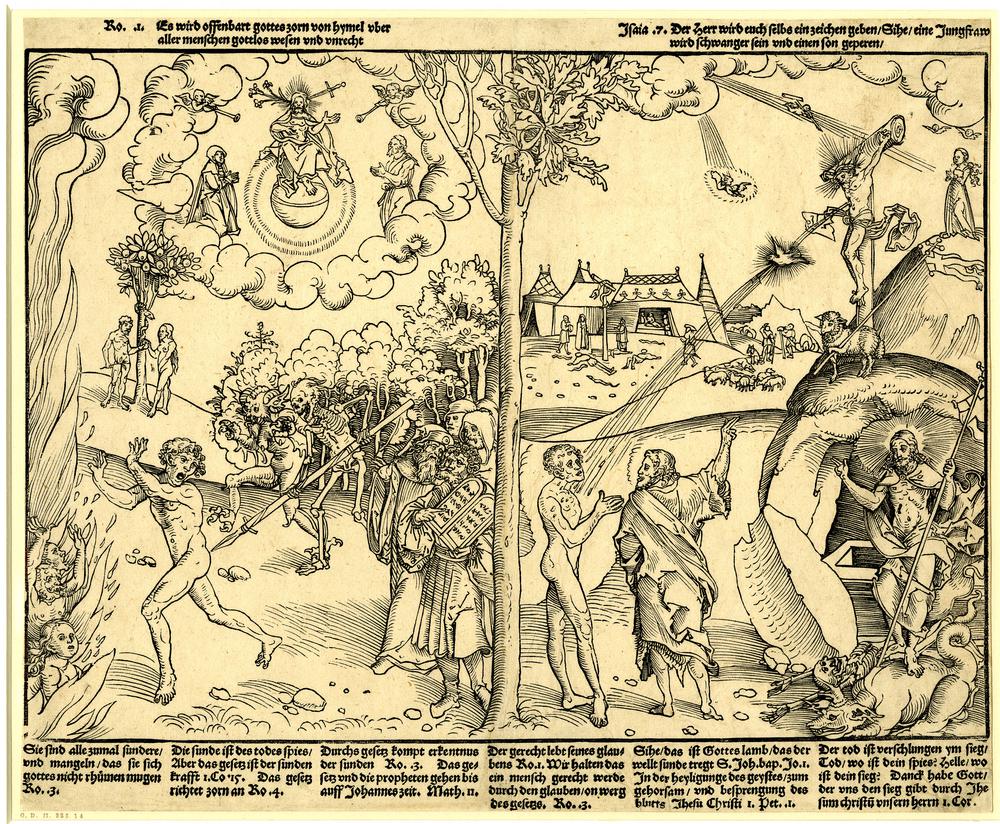
Allegory of Law and Grace- Lucas Cranach the Elder. 1530CE. Woodcut and Letterpress.
Form
Pictorial
Registers
Content
Two male nude figures
Gospel side, Law side
Resssurection
Hell
Christ judging Adam and Eve
John the Baptist
Context
Most influential image of Lutheran Reformation
Period of questioning the Catholic Church
Catholic belief in religious art as an outlet to get to heaven (paying for salvation)
Luther belief that you must just open up and have faith (art for art, not salvation)
Function
To argue that law alone cannot lead you into heaven without gospel and vice versa
Role of God as showing mercy and judge
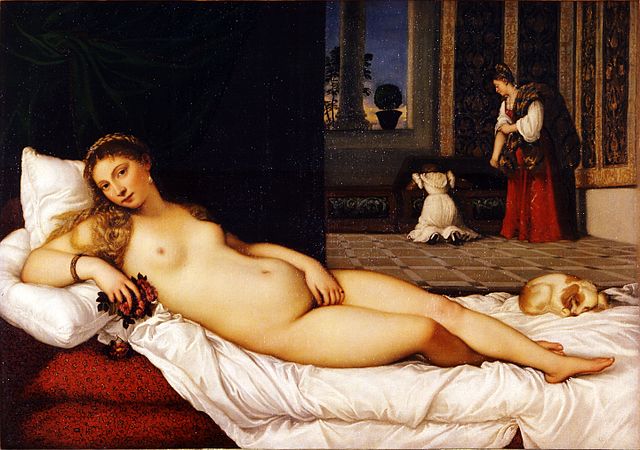
Venus of Urbino- Titian. 1538 CE. Oil on Canvas
Form
Sensual
Inimate vs. not
Split
Contrasting colors
Soft
Balance
Content
Unknown woman
Direct eye-contact
long hair frames breasts
Flowers
weird anatomy
Context
Later named Venus
Based off of patrons wife
Glazing (visual sensuality)
Beginning of reclining nude

Frontispiece of the Codex Mendoza- Viceroyalty of New Spain. 1541-1542CE. Pigment on paper.
Form
Divided into registers
symbols and figures
Content
Founding of Tenochtitlan
Divided into four
N.E.S.W.
Patron diety Huitzlopochtli
Warshields
Glyphs of those who found the location
Year glyph border
Function
To record info about the Aztecs
To brief the Spanish King
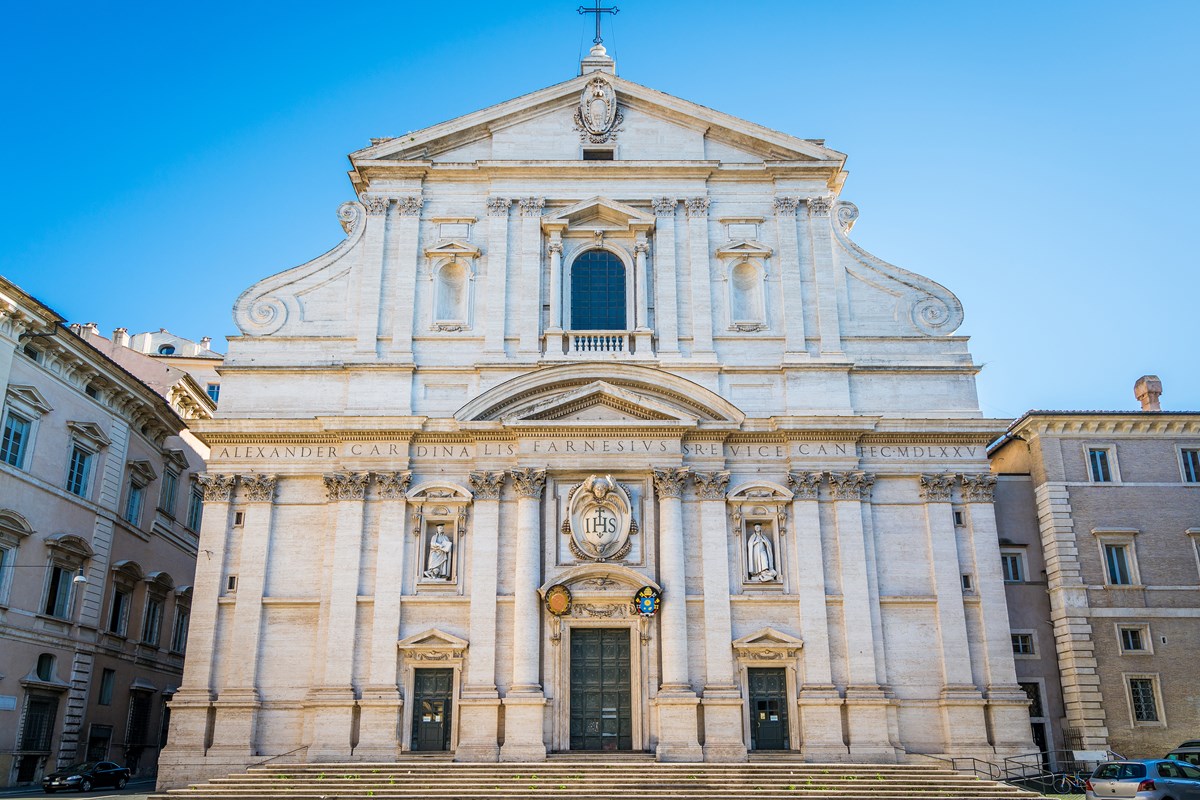
Il Gesù (including Triumph of the Name of Jesus Fresco)- Giacomo della Porta (architect), Giovanni Battista Gaulli (Fresco artist). Church 16th century. Fresco 1676-79 CE. Brick, marble, fresco, and stucco.
Form
Gilded
Painted
Elaborate
Basilica-style
Fresco
Upward emphasis
Content
Lots of gathering space
Cruciform plan
Direct narratives for clarity
Side chapels
Short trapsepts and alter
Classical refs.
Fresco
Everyone bowing to Christ
Barrel vaults
Gold
Angles
Arcs
Context
Gesù =Jesus
Council of Trent
Catholics choose plan of attack for counter reformation
Jesuit mother Chruch
St. Ignatius
Need for NEW Christian architecture
Function
To display victory of Catholic church of Protestantism
To make the miraculous accessible

Hunters in the Snow- Pieter Bruegel the Elder. 1565 CE. Oil on wood
Form
Colorful
Cool tones
Melancholy x playful
Densely packed
Content
Hunters returning from a hunt w/ their dogs
(not a very successful hunt)
Landscape
Daily routines/ labors
Playing on ice
Context
Commissioned by wealthy merchant in Antwerp
6 paintings
labors of the time of the year
Northern Renaissance
Mundane imperfect moments
Composed/imagined
Function
To depict the times of the year
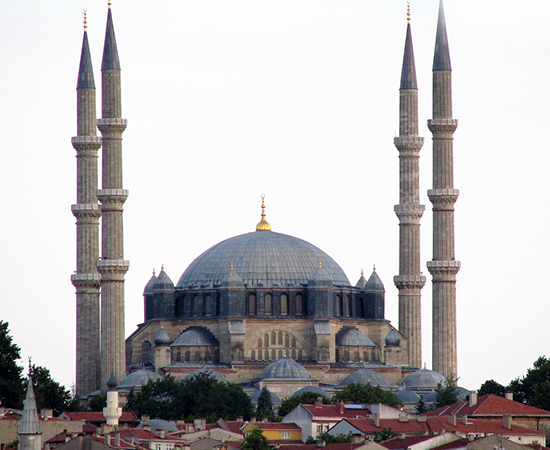
Mosque of Selim II- Erdine, Turkey. Sinan (architect). 1568-1575. Brick and Stone.
Form
Open plan inside
Stacked plan outside
Colorful
Content
Two madrasa’s
Shops
Schools
Dome
Tiles
Muqarnas
Muezzin mahfili
Context
Erdine was Selim II’s favorite city
Old capital of the Ottoman Empire
Built after defeat against Christian Holy League
Prevented expansion into European mediterranean coast
Function
To impress visitors and display greatness of the Ottoman Empire
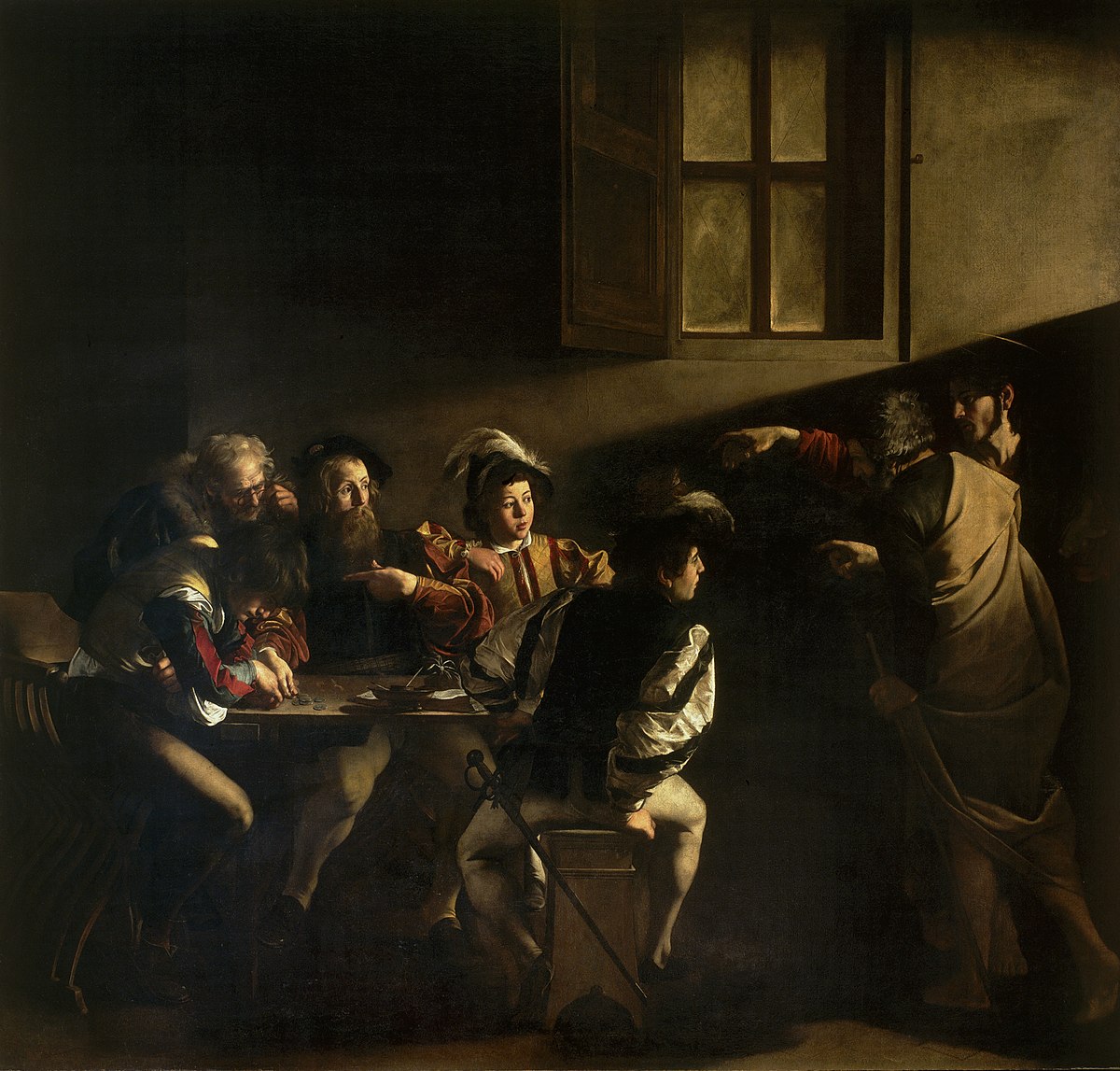
Calling of Saint Matthew- Caravaggio. 1597-1601 CE. Oil on Canvas
Form
Chiaroscuro
Tenebrism
Baroque
Naturalism
Content
Matthew as a tax collector is being called by God (christ)
Moment of spiritual awakening
Depiction of greed/ unethically obtained money.
Dirty/grimy
Adam hand x christ hand
foils
Context
In a chapel
Christ in real world
Accessible
Function
To depict greed and the observance of Christ
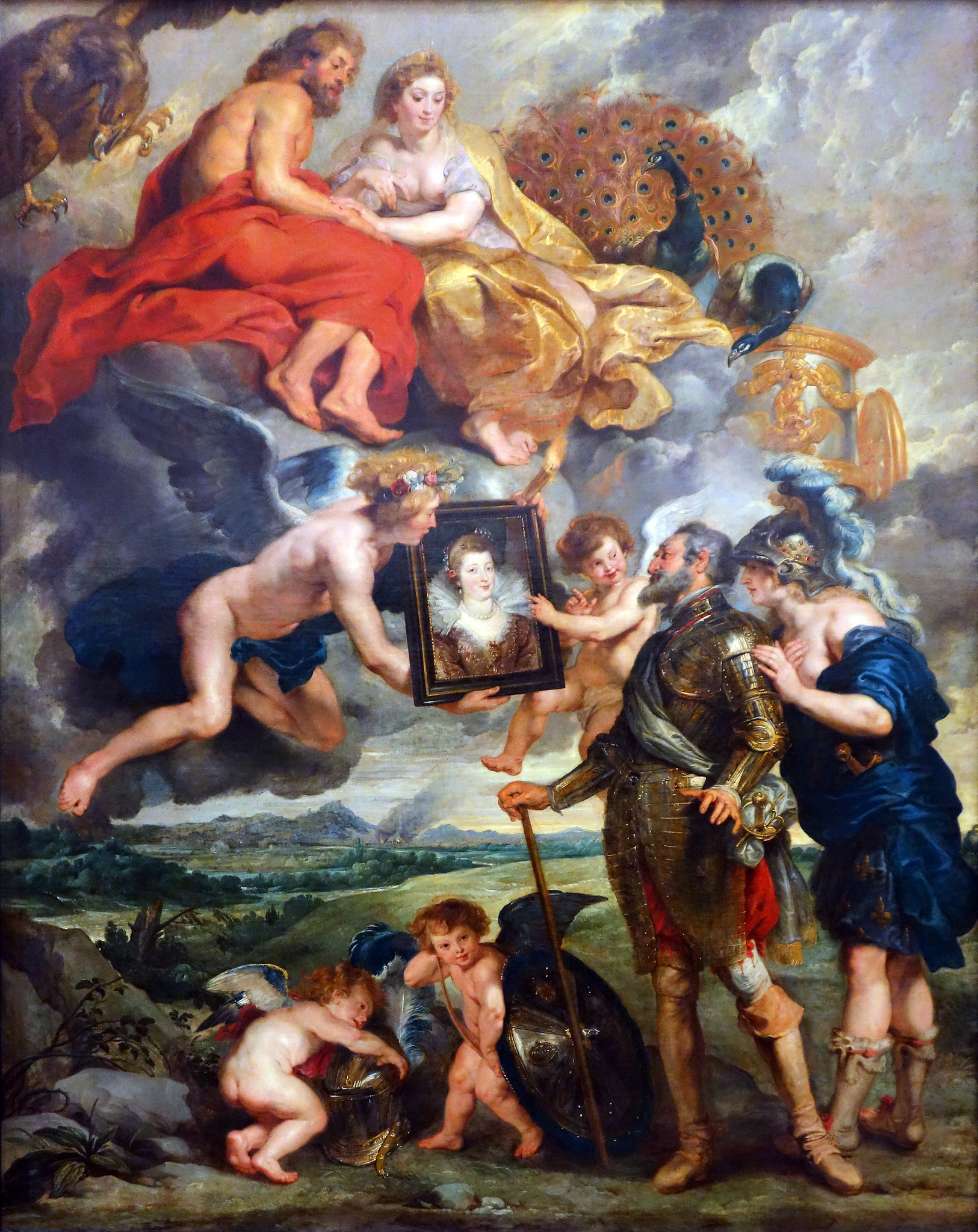
Henry IV Receives the Portrait of Marie de’ Medici, from the Marie de’ Medici Cycle- Peter Paul Rubens. 1621-1625. Oil on Canvas
Form
Baroque!
Greek
Dense
Overwhelming
Content
Triumphs of Marie’s life
Mythological/allegorical
Henry IV taken with her
Body facing her
Hand in awe
Elegant
Zeus and Hera
Eagle and Peacock
Cupid and Hymen holding painting
Hymen= god of marriage
France personified urging Henry
Landscape
post-battle
King’s helmet and shield off
Cupids playing with them
Marie portrait (flatness vs. movement)
Context
24-part series of her life
Medici fam married into Henry IV of France fam
Placed in her own house
Marriage of political alliance
Henry IV did not actually fw her that heavy
Function
To depict that Marie’s position and marriage was divinely ordained
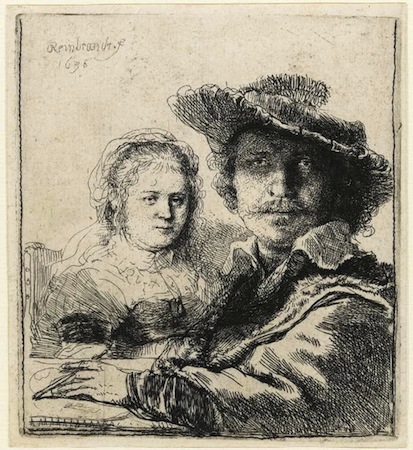
Self- Portrait with Saskia- Rembrandt van Rijn. 1636CE. Etching
Form
Shadowing
Curly &flowy
Content
Rembrandt and wife
Historical clothing
Plain background
Saskia smaller
Part of daily life
Rembrandt holding chalk holder
Drawing
Context
Rembrandt loved self-portraits
Reproducible
Function
Marriage portrait
Self-portrait
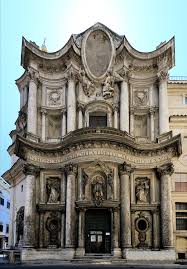
San Carlo alle Quattro Fontane- Rome, Italy. Francesco Borromini. 1638-1646. Stone and Stucco
Form
Movement
Rhythmic
Geometric
Concave x convex
Content
Undulating walls
Columns x niches
Arches
Oval dome
Oval layout
Entablature
Hectagons/Octagons
Dove
Symbol of the Trinitarians
Complexity to Clarity moving upwards
Context
Commissioned by Trinitarian order
Ransoming Christians taken in war or by pirates
Poor
Cheap materials
Small location
Geometry as Gods order
Heavy foot traffic
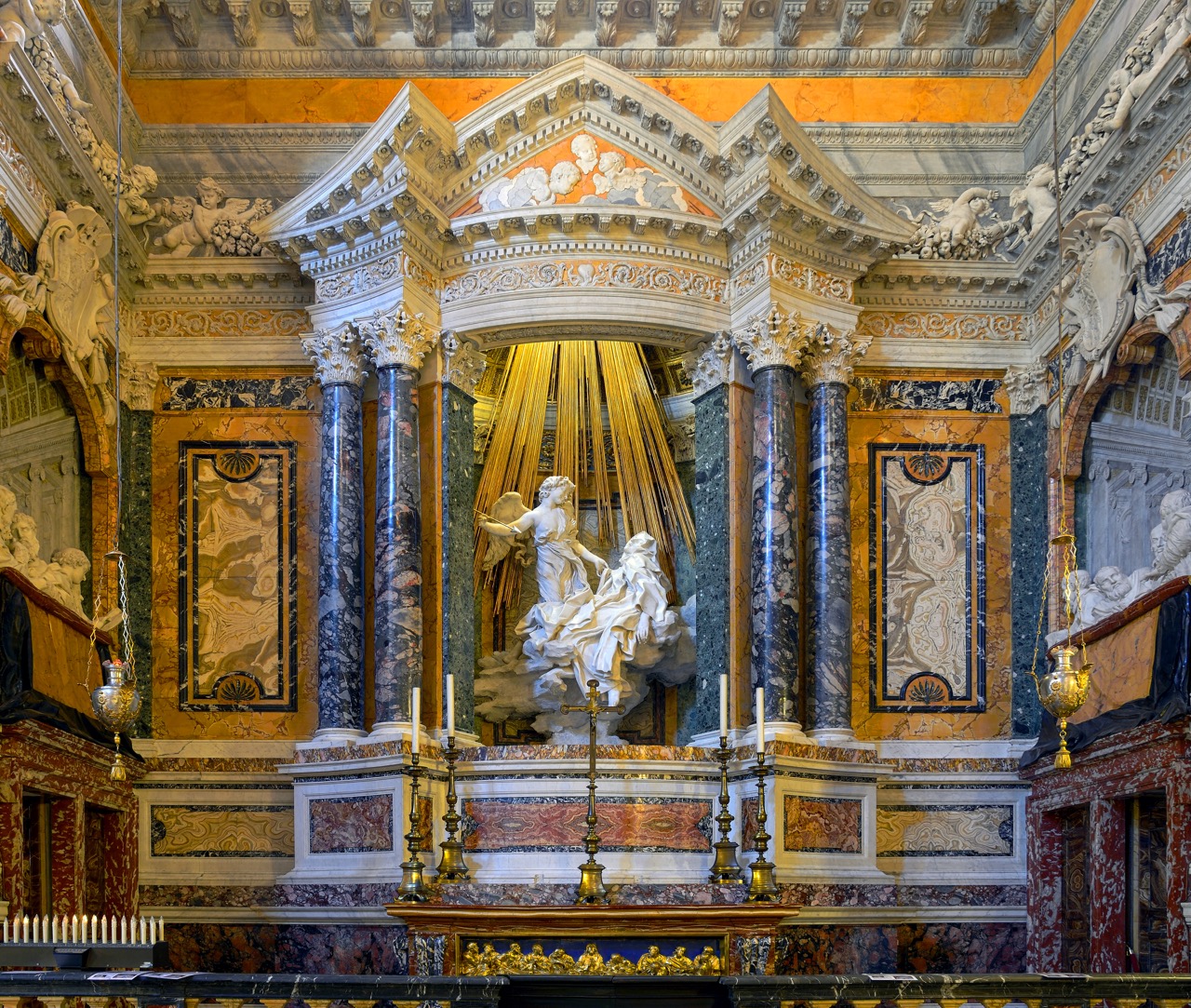
Ecstasy of Saint Teresa, Cornaro Chapel- Rome, Italy. Gian Lorenzo Bernini. 1647-1652 CE. Marble, Stucco and gilt bronze
Form
Engaging
Intimate
Naturalistic
Content
Fresco
Theatre boxes
Pediment/proscenium
Sculpture
One of Saint Teresa’s visions
Golden
Stabbed by angel
Earth vs. heaven
Floating on a clod
Window above to shine light
Context
Bernini combined religion and theatre
Bel composto
Counter reformation
Emphasis on individual worship
Function
To engage viewers in religious stories
To depict the spiritual experience
To display the social awakening occurring during the Counter Ref.
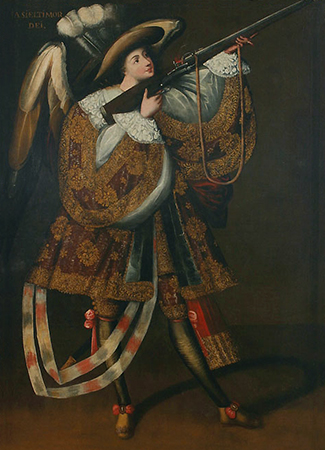
Angel with Arquebus- Asiel Timor Dei. Master of Calamarca. 17th Century. Oil on Canvas
Form
Portrait-style
Bold colors
Diagonals
Content
Androgynous figure
Harquebus (gun)
Angel
Latin letters
Status symbols of Incan and Spanish society
Context
Viceroyalty of Peru
Harquebus= very advanced
Church as army and angels as soldiers
Skirted around ban of angelic depictions
Ban called for duing council of Trent
American
Function
To aid in converting indigenous peoples to Catholicism
To display the power of the Spaniards over indigenous people
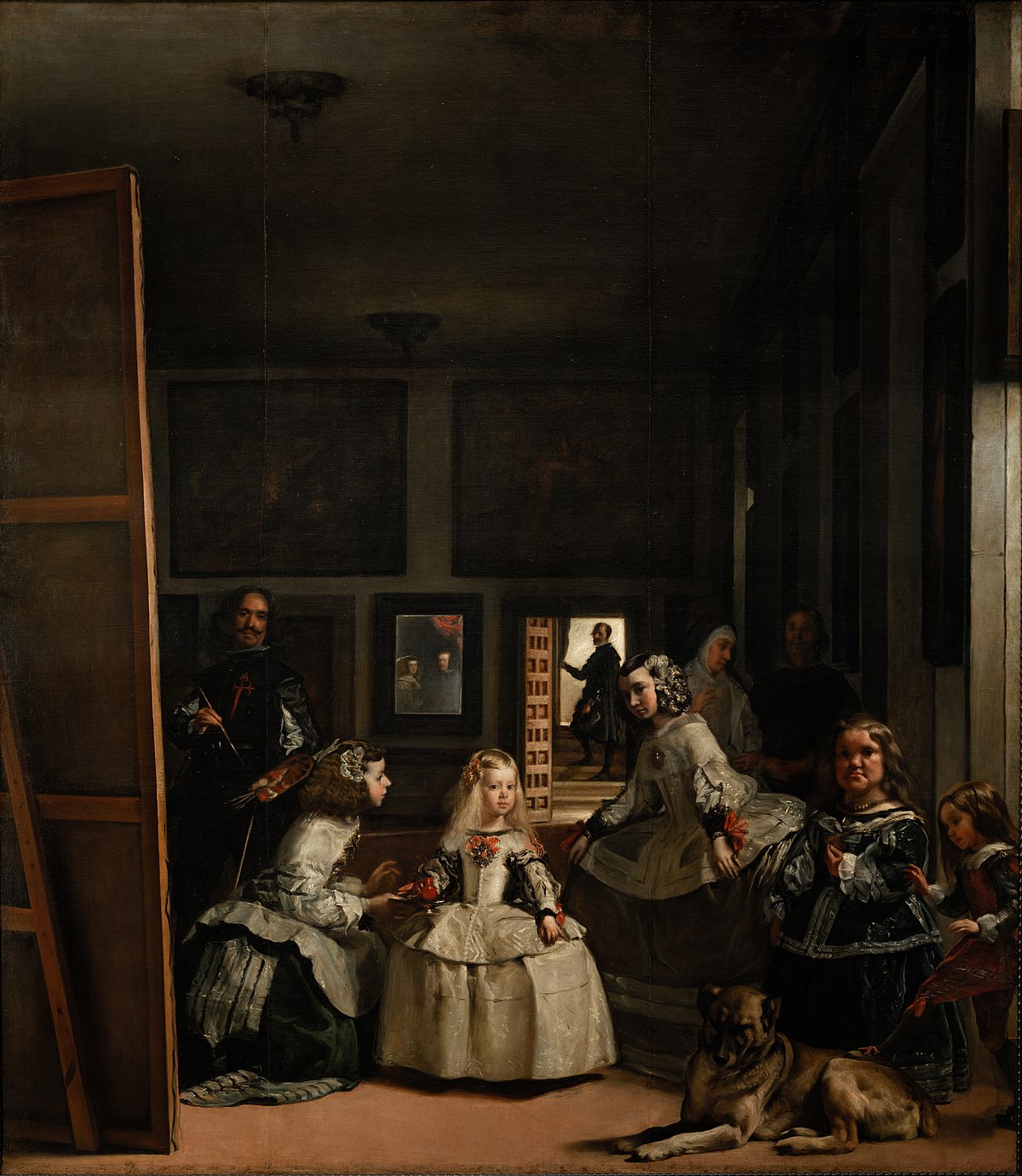
Las Meninas- Diego Velázquez. 1656 CE. Oil on Canvas
Form
Engaging (witnesses)
Realistic
Informal
intimate
Linear &Atmospheric perspective
Thick chunky brush strokes
Meta
Mysterious
Content
Velázquez self-portrait
Princess and attendants and governess
Mirror of King and Queen
Dog
Glances
Conext
Massive
Function
Velázquez’s display of his talent
To display the real lives of the royals
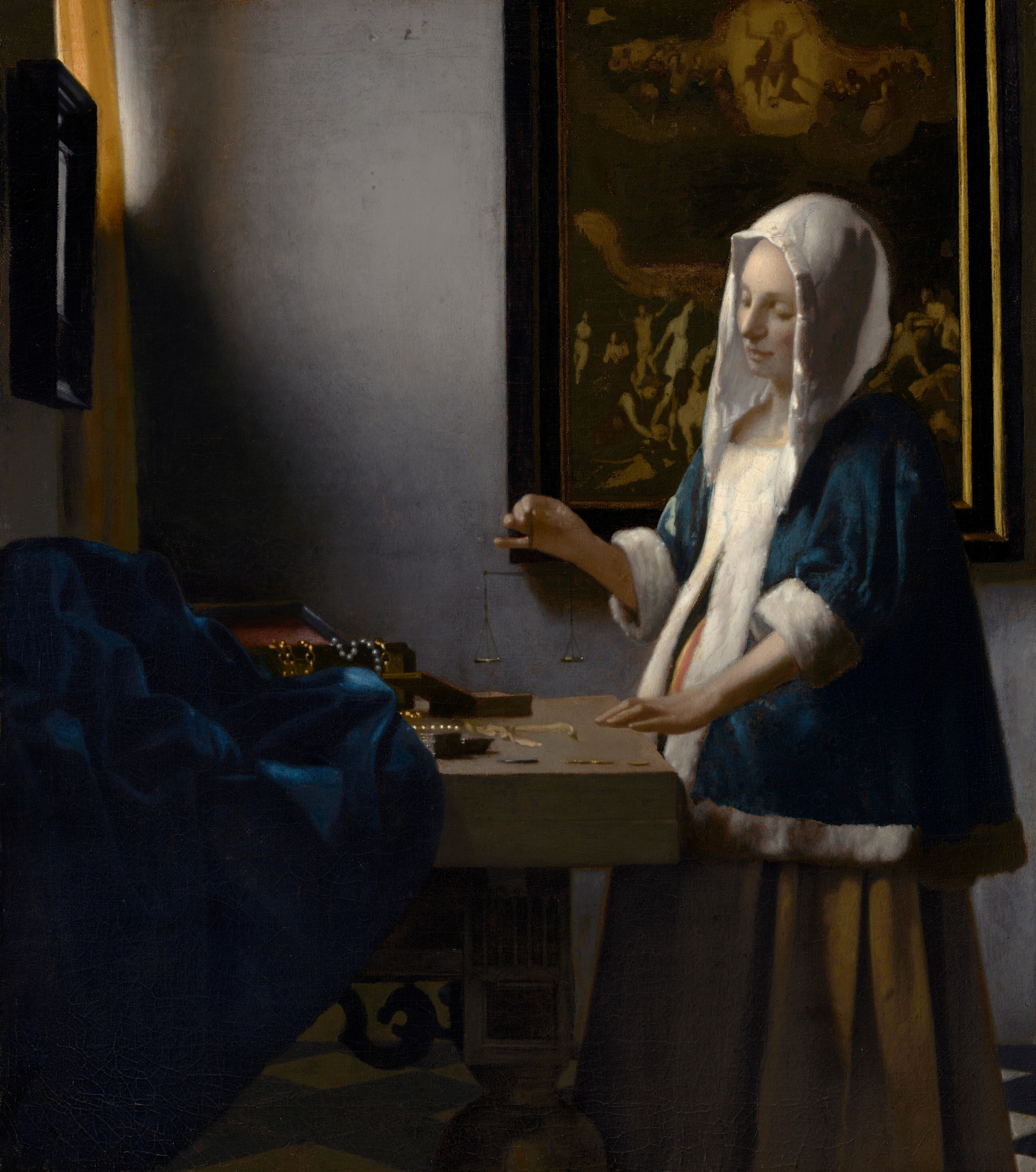
Woman Holding a Balance- Johannes Vermeer. 1664 CE. Oil on Canvas
Form
Quiet
Content
Fine clothing
Upper merchant class
Home hat
Fur jacket
Window and mirror
Golden curtain
Thin, empty balance
Boxes
Weights
Pearl strings
Painting of christ’s judgement
Waiting
Display of time
Context
Everyday life
Function
Artists painting for the merchant class
Balancing of God and the material
Vanity
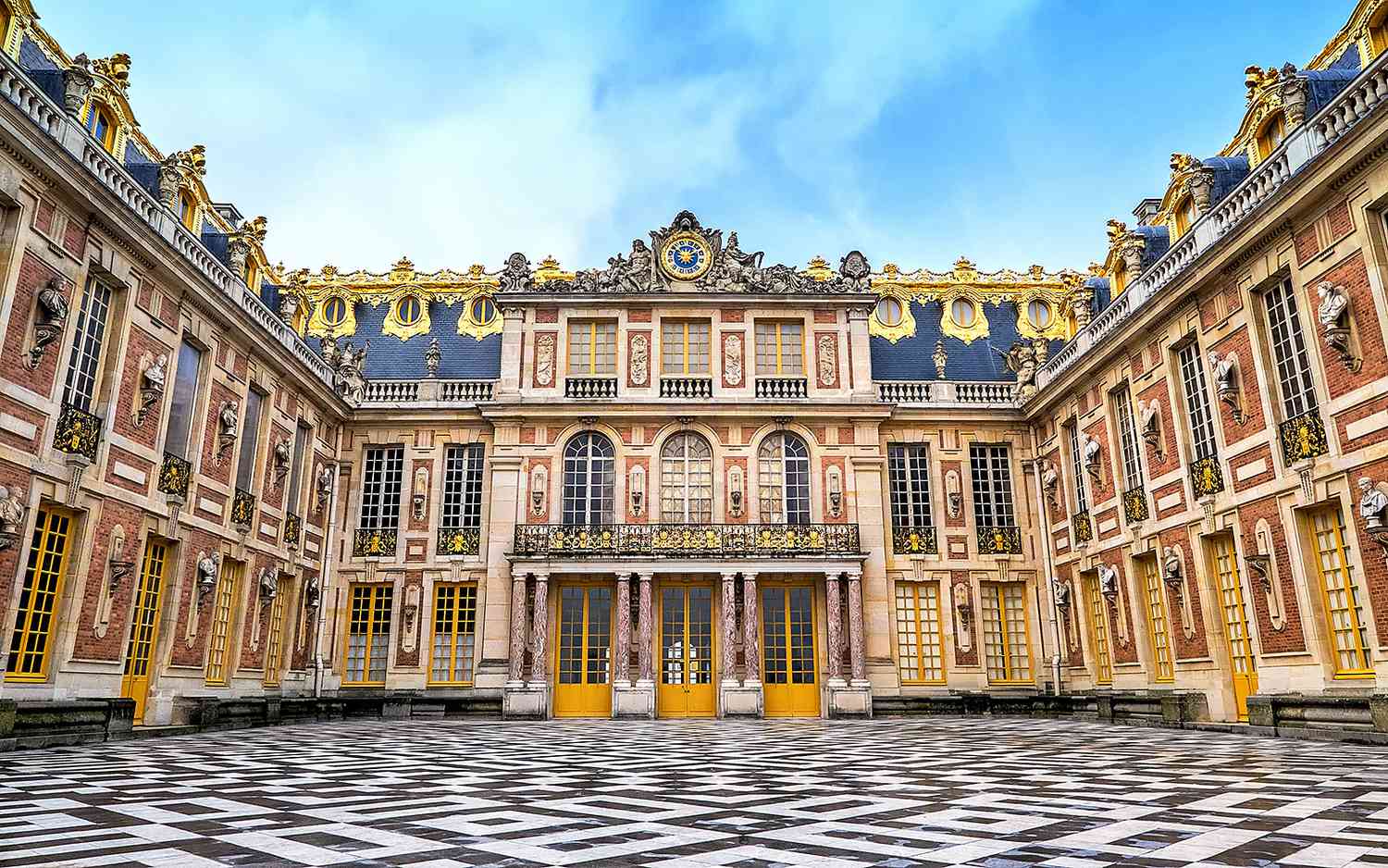
The Palace at Versailles- Louis le Vau, André le Nôtre, and Charles le Brun, Hall of Mirrors, Palace of Versailles, 1664–1710.
Form
Classical
Symmetrical
Content
Salon de war et paz
Grand Trianon
Family residence
Petit Trianon
Garden
Hameau de la reine
Working farm w cottages
Sun rise in allignment with home
Lots of depictions of Louis XIV
Marble and gold paintings
Greek Gods (and Louis)
Context
Sun king
Spent way too much of the taxes on this without consent of citizens
Function
To emphasize the importance of King Louis XIV

Screen with the Siege of Belgrade and Hunting scene- Circle of the González family. 1697-1701CE. Tempera and Resin on wood, shell inlay.
Form
Folding/moving
Thin strokes
Dense imagery
In action
Content
Japanese style landscape
Floral decor
Battle scene side
Hapsburgs vs. Turks
Contemporary
Encochado
Inlaid with shell
Landscape side
Hunting
Botanical motifs
Expansive landcape
Context
Japanese inspo
Japanese objects- Phillipines- Mexico
Trade through the Spanish
Screens, laquer wood boxes, ivory
Craze in Mexico for Japanese goods
Expensive
Owned by Viceroy
Silver mining industry
Battle side for Viceroy to see
Hunting and landscape side for women to see
Function
To assert Hapsburg dominance in Mexico
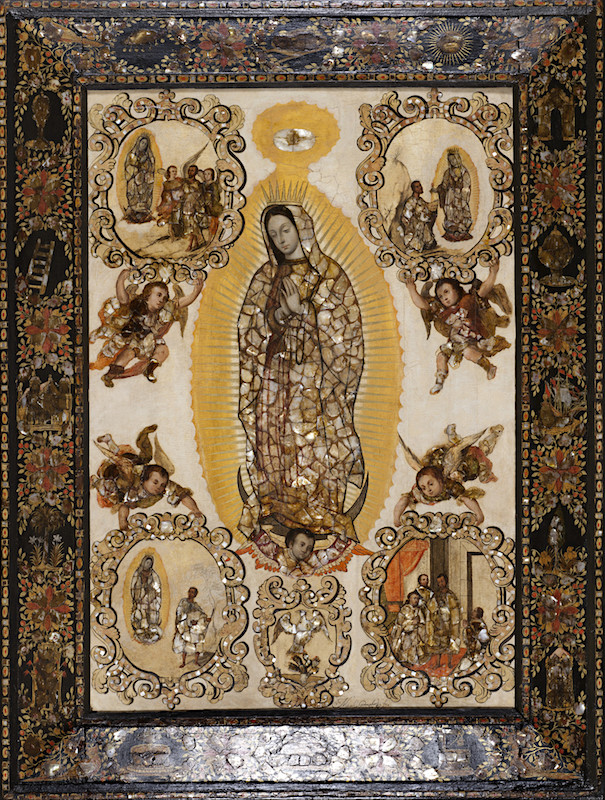
The Virgin of Guadalupe (Virgen de Guadalupe)- Miguel González. 1698CE. Oil on canvas on wood, inlaid with mother of pearl
Form
Light play
Central
Content
Encochado
Book of Revalation
Ashen Skin
Indigenous connotation
Context
Replica of OG
Guadalupe appears magically in front of Juan Diego and speaks to him in Nahuatl to make a shrine to her
He convinces priest to do it
During conversion of Natives
Function
Confirms the correctness of Christianity over indigenous religious practices
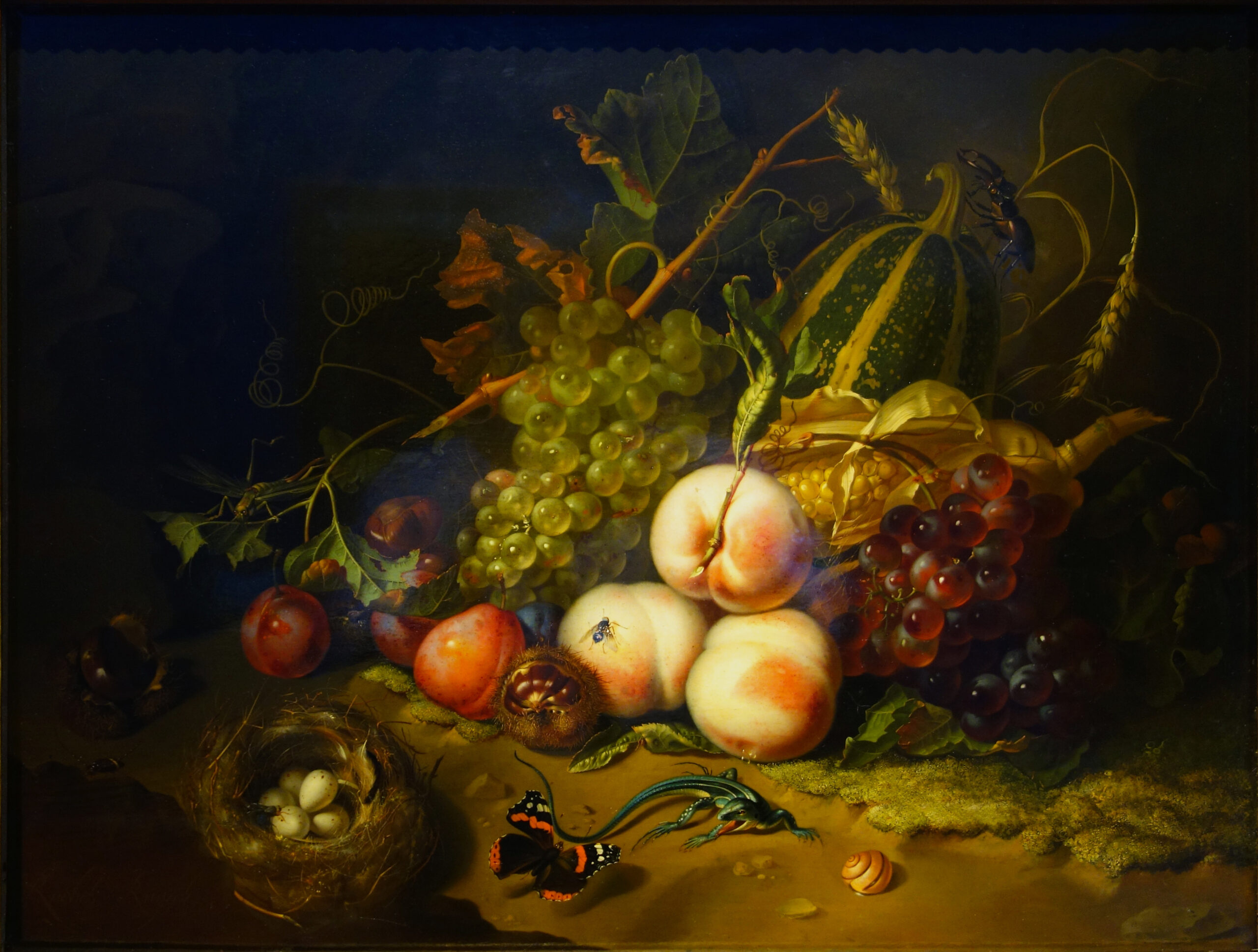
Fruit and Insects- Rachel Ruysch. 1711CE. Oil on wood
Form
Still life
Content
Harvest of autumn
Wheat and grapes
Eucharist
Minute details
Balance of colors and shades
Butterfly and salamander
Action/story
Context
High value
Specialized artist
Composite image
Scientific interest
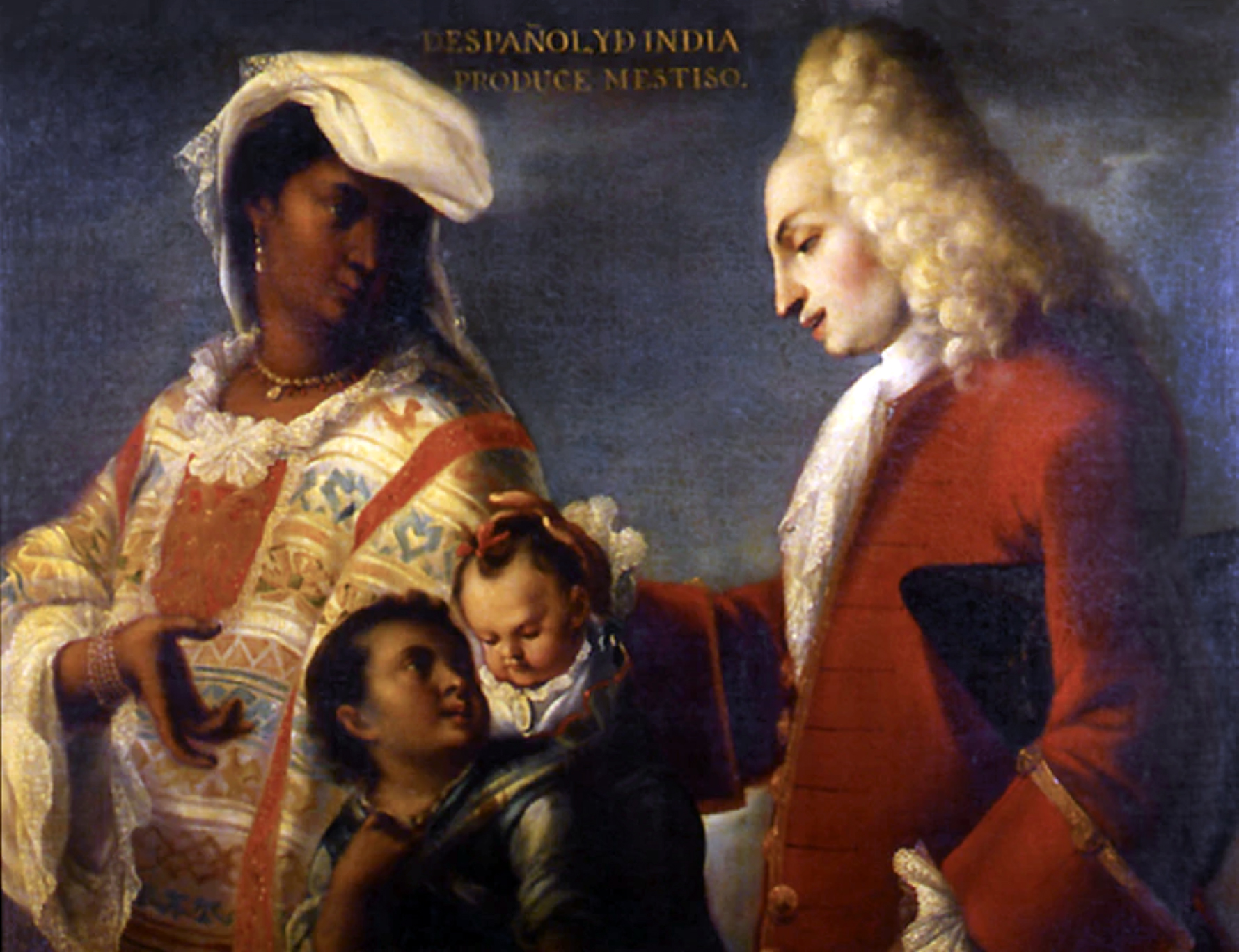
Spaniard and Indian Produced a Mestizo- Juan Rodríguez Juarez. 1715CE. Oil on canvas
Form
Naturalistic soft
Content
Literally just the title
Context
Casta system
Spanish colonialism
Function
Casta painting
To show off to Spanish King and bring back to spain
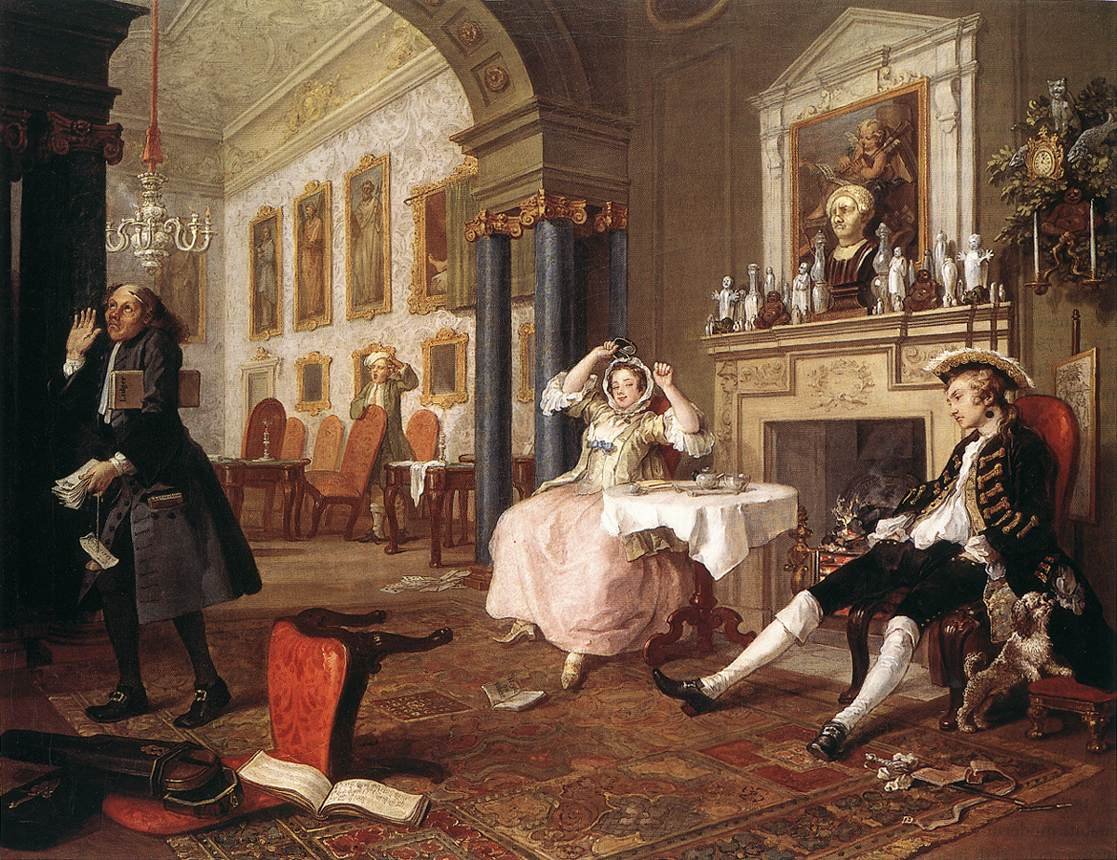
The Tête a Tête, From Marriage a la Mode- William Hogarth. 1743. Oil on Canvas
Content
Husband returned from long night of drinking and partying
Dog sniffing woman’s bonnet in husband’s pocket
Wife flirtacious
Bodice undone
Mirror in hand
Chair overturned
Musical instruments
Accountant is done
Knick Knacks everywhere
Saints depicted on walls
Broken nose on sculpture on the mantel piece
Context
Beginnings of IR
Growing middle/merchant class
Printed
Critique of marriage for money
Arranged marriages
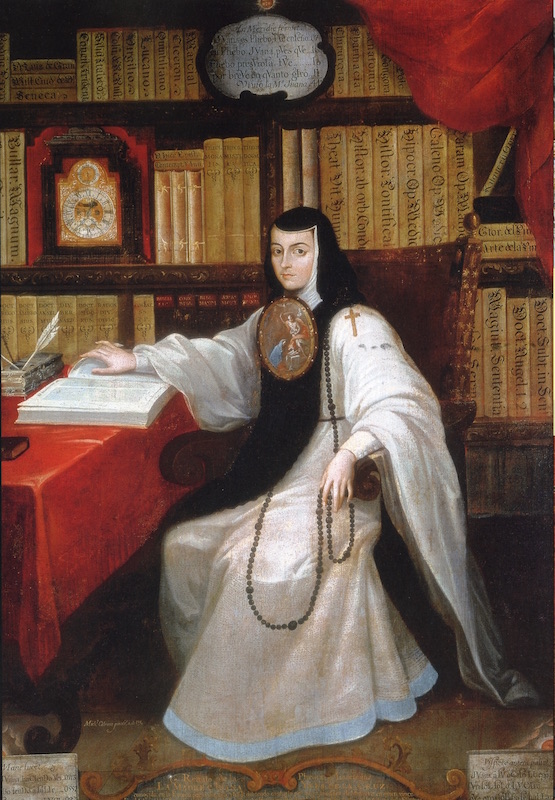
Portrait of Sor Juana Inés de la Cruz- Miguel Cabrera. 1750CE. Oil on canvas
Form
Eye contact
Centrality
Bold colors
Text
Content
Mexican nun/writer
Seated at desk
Surrounded by books
Similar to depictions of states
Nun badge
Woven x painted
Virgin mary
Rosary x books
Context
Posthumous
Considered first feminist in American
Intellectual (theological debates and art)
Child prodigy
Lady in waiting at viceroy house
Critiqued for writing- so she gave up intellectual pursuits
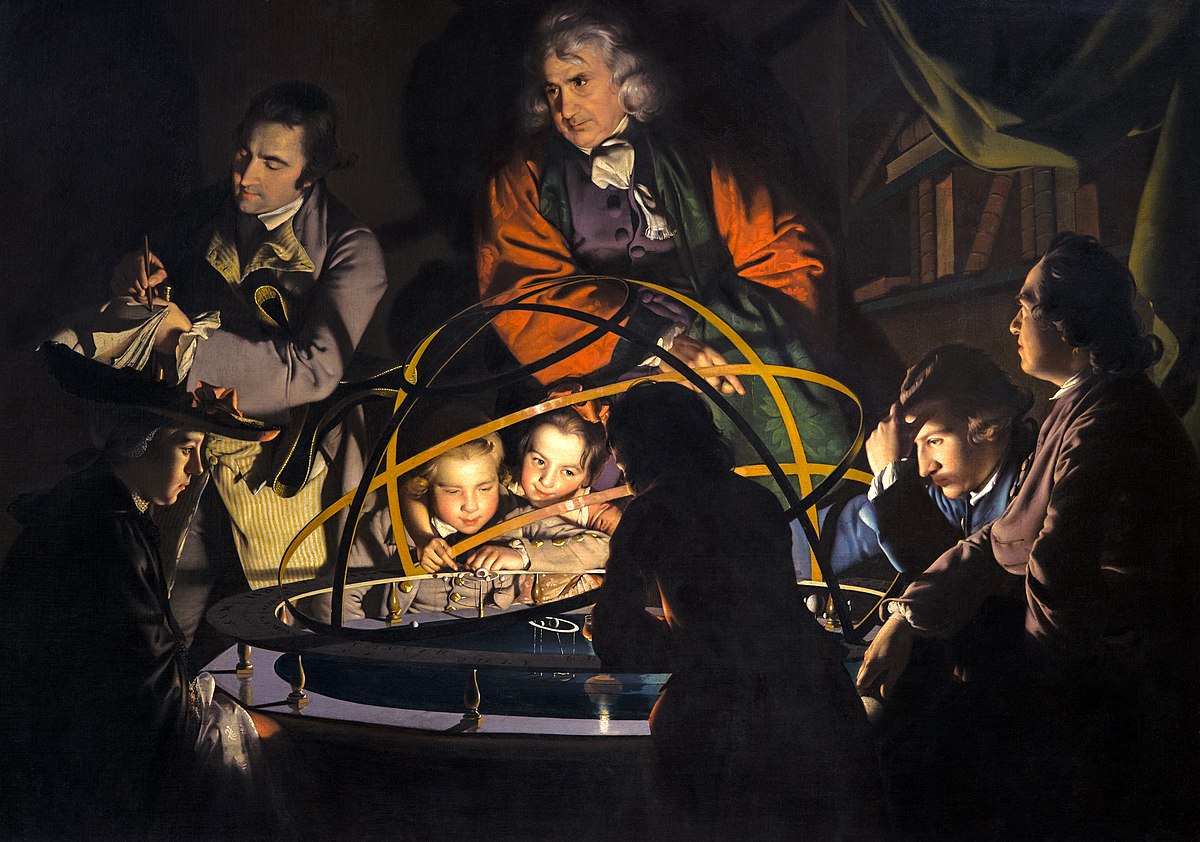
A Philosopher Giving a Lecture on the Orrery- Joseph Wright of Derby. 1763 CE. Oil on canvas
Content
Two young boys
Teenage girl
Young man shielding eyes
Taking notes
Non-idealized
Informal
Context
Enlightenment
Empirical scientific approach
Writers and artists aided in spread of Enlightenment ideas
Joseph Wright of Derby
Explored boundaries of painting
Reflects religious epiphany
Caravaggio style and similar message
Orrery
Solar system model
Function
To display the scientific enlightenment and philosophical shift